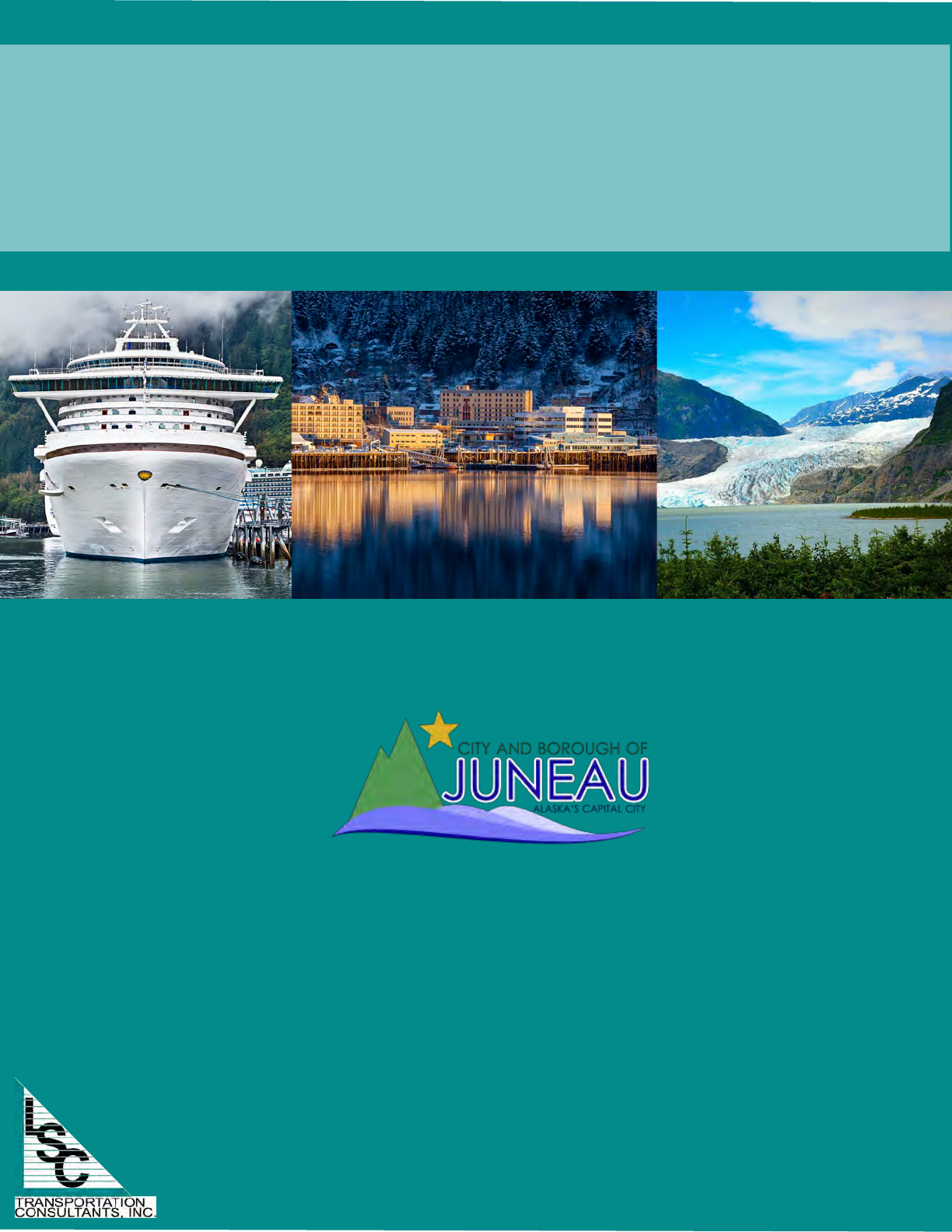
Prepared by LSC Transportation Consultants
JUNEAU VISITOR
CIRCULATOR STUDY
Final Report
February 8, 2024

Juneau Visitor
Circulator Study
FinalReport
Preparedfor
City and Borough of Juneau
155 S. Seward Street, Juneau AK 99801
Preparedby
LSC Transportation Consultants, Inc.
2690 Lake Forest Road, Ste. C
Tahoe City, CA 96145
530-583-4053
February8,2024
This page intentionally
left
blank

Juneau Visitor Circulator Study LSC Transportation Consultants, Inc.
City and Borough of Juneau Page i
TABLEOFCONTENTS
CHAPTER PAGE
1 Introduction .............................................................................................................................. 1
Introduction ........................................................................................................................................ 1
2
Existing Community Conditions ................................................................................................ 3
Introduction ...................................................................................................................................... 3
Study Area Characteristics ................................................................................................................ 3
Traffic Volumes and Delays ............................................................................................................... 8
Visitor Characteristics ....................................................................................................................... 8
3
Existing Transportation Services ............................................................................................. 11
Introduction .................................................................................................................................... 11
Transportation Services .................................................................................................................. 11
4
Relevant Planning Documents and Plans ............................................................................... 21
Introduction .................................................................................................................................... 21
Future Planned Developments ....................................................................................................... 25
5
Visitor Data Summary ............................................................................................................. 27
Juneau Visitor Overview.................................................................................................................. 27
Cruise Ship and Passenger Activity ................................................................................................. 30
Mendenhall Glacier Visitor Activity ................................................................................................ 33
6
Public and Stakeholder Outreach ........................................................................................... 35
Online Community Survey Results .................................................................................................. 35
Stakeholder Presentation and Workshop ....................................................................................... 36
7
Needs Assessment and Service Concepts .............................................................................. 39
Needs Assessment .......................................................................................................................... 39
Potential Alternatives ...................................................................................................................... 43
8 Service Alternatives Analysis ................................................................................................... 45
Introduction .................................................................................................................................... 45
Downtown Circulator ...................................................................................................................... 45
Capital Transit Tripper Service ........................................................................................................ 65
Expanded Capital Transit Service to Mendenhall Glacier .............................................................. 64
Conclusions ..................................................................................................................................... 68

Juneau Visitor Circulator Study LSC Transportation Consultants, Inc.
City and Borough of Juneau Page ii
9
Potential Funding Sources ...................................................................................................... 69
Introduction ......................................................................................................................................... 69
Potential Funding Sources ................................................................................................................... 69
10 Recommended Visitor Circulation Plan
....................................................................................... 71
Introduction ......................................................................................................................................... 71
Existing Conditions and Challenges ..................................................................................................... 71
Recommended Service and Operations Plan ...................................................................................... 72
Marketing Strategies ............................................................................................................................ 78
Marketing Timeline .............................................................................................................................. 80
Management Plan ................................................................................................................................ 81
Implementation Plan ............................................................................................................................ 82
Financial Plan ........................................................................................................................................ 83
LISTOFTABLES
TABLE PAGE
Table 1: Historic and Projects Population of Juneau ................................................................................ 3
Table 2: Annual Enplanements/Deplanements ....................................................................................... 6
Table 3: Distances to Downtown Juneau .................................................................................................. 6
Table 4: Juneau AADT by Location and Year – Major Roads .................................................................... 8
Table 5: Downtown Juneau AADT by Location and Year – Local Roads .................................................. 9
Table 6: Capital Transit Current Services and Frequency ....................................................................... 12
Table 7: Capital Transit Ridership by Month ........................................................................................... 14
Table 8: Capital AKcess Annual Ridership by Month .............................................................................. 16
Table 9: FY 2022 Capital Transit Cost for Services .................................................................................. 17
Table 10: Alaska Visitors by Mode of Travel ........................................................................................... 28
Table 11: Ships in Port by Day and Hour for Peak Summer Week ........................................................ 31
Table 12: Capital Transit Passengers Unserved by Time of Day ............................................................. 40
Table 13: Analysis of Passengers Unserved on Capital Transit vs. Ship Capacity ................................... 41
Table 14: Analysis of Cruise Ship Capacity in Port Criteria for Scheduling Tripper Buses ...................... 42
Table 15: Daily Cruise Capacity and Passengers by Day of Week ........................................................... 45
Table 16: Example Downtown Circulator Running Times ....................................................................... 47
Table 17: Estimate of Daily Circulator Ridership on Design Day ............................................................ 50
Table 18: Analysis of Hourly Circulator Ridership and Peak Load .......................................................... 53
Table 19: Downtown Circulator Operating Costs ................................................................................... 54
Table 20: Downtown Circulator Fare Revenue Analysis ......................................................................... 55
Table 21: Circulator Bus Stop Improvement Costs ................................................................................. 60
Table 22: Circulator Service – Capital Costs ............................................................................................ 61
Table 23: Example Tripper Bus Costs ...................................................................................................... 64
Table 24: Route 8 Sample Afternoon Schedule Serving Mendenhall Glacier ........................................ 66
Table 25: Estimated Incremental Operational Costs of Route 8 Service to Mendenhall Glacier .......... 66

Juneau Visitor Circulator Study LSC Transportation Consultants, Inc.
City and Borough of Juneau Page iii
Table 26: Route 8 Extension to Mendenhall Glacier – Projected Passengers and Fare Revenue ......... 67
Table 27: Recommended Service and Operations Plan .......................................................................... 72
Table 28: Circulator Bus Stop Improvement Costs ................................................................................. 75
Table 29: Implementation Plan ............................................................................................................... 84
Table 30 Operating Financial Plan ........................................................................................................... 85
Table 31: Capital Funding Plan ................................................................................................................ 86
LISTOFFIGURES
FIGURE PAGE
Figure 1: Juneau Activity Centers .............................................................................................................. 4
Figure 2: Juneau Cruise Docks ................................................................................................................... 7
Figure 3: Capital Transit Route and Bus Stop Map ................................................................................. 13
Figure 4: Capital Transit Annual Ridership .............................................................................................. 15
Figure 5: Capital Transit Monthly Ridership by Fiscal Year ..................................................................... 15
Figure 6: Capital Akcess Ridership by Fiscal Year and Month ................................................................. 17
Figure 7: Alaska Visitors by Cruise Ship ................................................................................................... 28
Figure 8: Alaska Visitors by Mode of Travel ............................................................................................ 29
Figure 9: Hourly Arriving and Departing Ship Capacity by Day and Hour .............................................. 32
Figure 10: Passenger Capacity in Port by Day and Hour for Peak Summer Week ................................. 33
Figure 11: Short Route Option ................................................................................................................ 46
Figure 12: Long Route Option ................................................................................................................. 48
Figure 13: Cruise Ship Capacity in Juneau by Day - 2023 ....................................................................... 49
Figure 14: Route 8 Extension to Mendenhall Bus Staging Area ............................................................. 65
Figure 15: Downtown Circulation Plan ................................................................................................... 73
LISTOFAPPENDICES
Appendix A – Stakeholders List - Removed
Appendix B – Stakeholder Comments

Juneau Visitor Circulator Study LSC Transportation Consultants, Inc.
City and Borough of Juneau Page iv
This page intentionally left blank

Juneau Visitor Circulator Study LSC Transportation Consultants, Inc.
City and Borough of Juneau Page 1
Chapter 1
INTRODUCTION
INTRODUCTION
Juneau, Alaska has long been a major cruise ship destination for those seeking outdoor adventure,
sightseeing, and wildlife viewing. This massive influx in tourism over time has led to an increase in traffic
congestion and environmental pollution in and around Downtown Juneau during peak summer months. It
also has led to visitor use of the Capital Transit fixed routes to a degree that impacts resident’s mobility in
peak visitor activity periods. To address these issues, the City and Borough of Juneau (CBJ) hired LSC
Transportation Consultants, Inc. to evaluate the possibility of a public transit circulator strategies that
could facilitate visitor travel within the area and help to solve these identified problems.
This document is the first in a series of working papers that will be developed over the course of the study
to provide opportunities for public review and input.
Study Goals
The goal of the Circulator Study was to determine what types of transportation services the CBJ should
consider, which service(s) would be most appropriate for the region, and how the CBJ could fund and
implement such a program. Key questions to be addressed in the study included the following:
• How can a circulator service best address the impacts of high visitor levels on the
community?
• How can improved circulator services enhance the local economy by better serving visitors
and helping to spread visitors to a broader range of establishments and activities?
• What destinations should be served, and what are the appropriate hours and days of service?
• What is the appropriate role of the public sector (Capital Transit) versus private
transportation services? How best can a visitor circulator service coordinate with existing
transit services?
• Given the realities of financial and driver availability limits, what is an implementable strategy
for circulator services?
Study Process
A series of Technical Memoranda (Tech Memos) were completed over the course of the study to provide
opportunities for stakeholder review and input. The first Tech Memo summarized Juneau as it exists
today in relation to tourism, transportation, and land use development. At this point, local stakeholders,
business owners, and transportation providers were engaged in both an online community survey and in-
person workshop to discuss current regional challenges and possible solutions. The second Tech Memo
evaluated potential demand for visitor circulator services. The third and final memo then discussed
potential service and capital alternatives while incorporating the stakeholder input received after Tech
Memo 1. The final Juneau Circulator Study encompasses the information vetted through the tech memos
review, with the addition of a final chapter presenting the final plan recommendations.

Juneau Visitor Circulator Study LSC Transportation Consultants, Inc.
City and Borough of Juneau Page 2
This page left intentionally blank.

Juneau Visitor Circulator Study LSC Transportation Consultants, Inc.
City and Borough of Juneau Page 3
Chapter 2
EXISTING C
OMMUNITY CONDITIONS
INTRODUCTION
Juneau is a unique destination with a diverse range of visitor attractions, including historical sites,
harbors, sight-seeing, shopping, and hiking. Located at the base of Mount Juneau, it is both a mountain
town and a maritime coastal port along the Gastineau Channel. While the city is home to only 32,000
residents, the region typically attracts more than 1 million visitors each year. This level of activity,
concentrated in the busy summer season, impacts the very limited roadway network.
This chapter provides an in-depth overview of major characteristics including population, activity centers,
existing traffic volumes, and future planned development. The chapter then concludes with relevant
planning documents considered in this study.
STUDY AREA CHARACTERISTICS
Population
The population of Juneau has stayed consistent over the last 20 years, as shown in Table 1. A slight
decline in population is anticipated in the coming decades. With this information in mind, this study will
focus on anticipated visitor populations.
Activity Centers
Major activity centers are important to recognize as potential transit trip generators. For the purpose of
this study, an activity center may be a government agency, tourism destination, or any other interesting
location attracting higher levels of day-to-day traffic. These centers are important not only for the
possibility of providing transportation services but also for anticipating potential conflicts transportation
services. As shown in Figure 1, activity centers are primarily located in Downtown Juneau and within
Mendenhall Valley (the Mendenhall Glacier and Statter Harbor).
Table 1: Historic and Projected Population of Juneau
2000 2010 2020 2030 2040 2050
Population
30,668 31,275 32,195 31,261 30,229 28,692
Historic
Projected
Source: US Census Bureau American Community Survey and Alaska Dept. of Labor and
Workforce Development
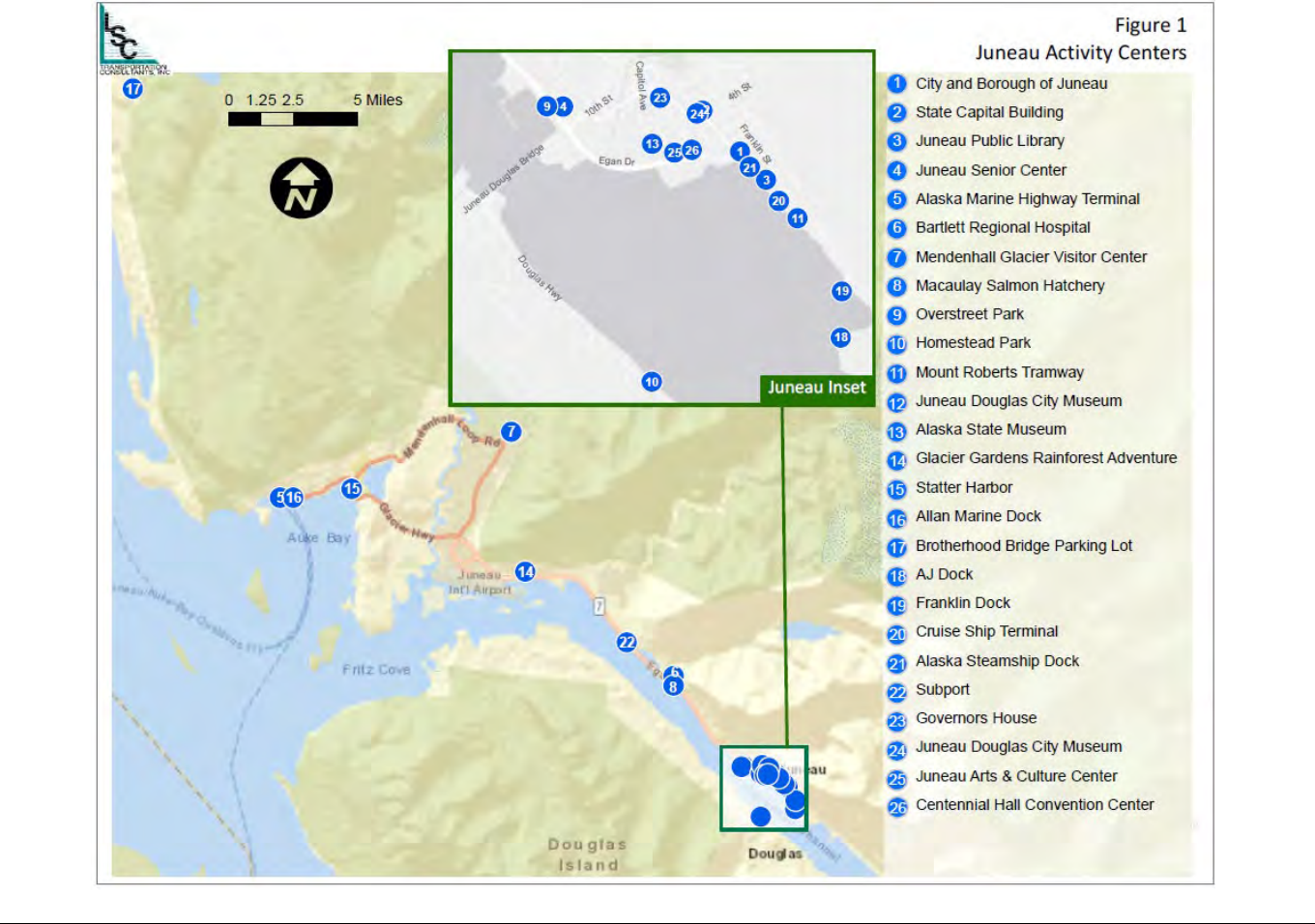
Juneau Visitor Circulator Study LSC Transportation Consultants, Inc.
City and Borough of Juneau Page 4

Juneau Visitor Circulator Study LSC Transportation Consultants, Inc.
City and Borough of Juneau Page 5
Downtown Juneau
Downtown Juneau is also shown in Figure 1. As illustrated, downtown Juneau is full of many points of
interest including the Alaska State Capital, State Museum, Centennial Hall Conference Center, Mount
Roberts Tramway, and the Governor’s Mansion. There are also a wide variety of retail shops, breweries,
bars, and restaurants popular with both tourists and residents alike located along South Franklin Street
and Front Street. Downtown Juneau is also the access point for hiking trails and the Last Chance Mining
Museum located on Basin Road.
Mendenhall Glacier
Nearly 13 miles north of Downtown Juneau is the Mendenhall Glacier. Attracting around 700,000 visitors
annually, the area offers not only the Mendenhall Glacier Visitor Center, but also several hiking trails and
scenic viewpoints around Mendenhall Lake and guided adventures. Being located within the Tongass
National Forest, the area is managed by the United States Forest Service (USFS).
In an effort to better accommodate annual visitors, the USFS is considering a series of improvements for
the Mendenhall Glacier Recreation Area (MGRA). These improvements will include expanded parking
facilities, increased visitor amenities (shelters and drop off/pick up locations), and improved trail access
through the MGRA.
Macaulay Fish Hatchery (DIPAC)
The Macaulay Fish Hatchery (commonly referred to as the DIPAC Fish Hatchery) is primarily open
between May and September between 10 am and 6 pm Monday through Friday and from 10am to 5 pm
Saturday and Sunday. The destination offers an experiential learning tour of the salmon hatchery,
saltwater aquariums, and tide pools. There is also a small gift shop with various types of locally made
foods. In 2019, prior to the pandemic, the hatchery recorded its highest annual visitor count with over
90,000 people visiting. A hatchery representative indicated that a majority of summer guests arrive via
tours scheduled from their respective cruise ships, often arriving in large, contracted vehicles.
Juneau International Airport
The Juneau International Airport is located 8.5 miles north of downtown Juneau, approximately 15
minutes by vehicle. Alaska Airlines and Delta Air Lines are the only two commercial services to the airport,
operating alongside the following local air travel providers: Alaska Seaplanes, Coastal Helicopters, Island
Air Express, NorthStar Trekking, Temsco Helicopters, Wings of Alaska Airways, and Ward Air. Alaska
Airlines provides direct flights from Anchorage, Seattle, Ketchikan, Sitka, Yakutat, Cordova, and Wrangell.
Delta Air Lines provides direct flights from Seattle seven days per week in the summer and weekends only
in the winter. Annual enplanements and deplanements by airline and year are shown in Table 2. As
shown, prior to the pandemic total enplanements remained steady with a total of over 300,000
enplanements and deplanements year over year. While passenger activity declined during the pandemic,
based on current enplanement and deplanements of 2022 year-to-date air travel to and from the region
is returning to pre-pandemic levels. The airport employs over 1,000 people locally and provides
commercial air travel to over 300,000 people on average per year.

Juneau Visitor Circulator Study LSC Transportation Consultants, Inc.
City and Borough of Juneau Page 6
The Juneau Air and Ferry Visitor Survey, Summer 2018 prepared by McDowell Group indicated that 56
percent of travelers arriving by air were traveling for vacation/pleasure. Their top activities in the area
were Mendenhall Glacier (63 percent), shopping (61 percent), hiking (45 percent) and the tramway (44
percent). Those arriving by air were planning to travel in the Juneau area by rental vehicle (27 percent),
taxi (27 percent), personal vehicle (25 percent), hotel shuttle (18 percent) and public transit (10 percent).
Cruise Docks
The Juneau area welcomes nearly 1,000 cruise ships each summer season, each docking near and around
the downtown Juneau area. There are six major docks in Juneau Harbor: AJ Dock, S. Franklin Street Dock,
Intermediate Vessel Float, Cruise Ship Terminal, Alaska Steam Ship Dock, and Seadrome Dock.
Alaska Steam Dock and Cruise Ship Terminal are south of downtown Juneau running parallel to Franklin
Street. Intermediate Vessel Float is a small dock adjacent to Cruise Ship Terminal on the south side.
Heading southward, these docks are followed by South Franklin and AJ Dock Figure 2 shows a more
detailed map of each dock location including the proposed Huna Totem dock. While some docks are very
close to downtown Juneau (Alaska Steam Dock), Franklin Dock and AJ Dock are a 15- and 30-minute walk,
respectively (Table 3).
Table 2: Annual Enplanements/Deplanement
Enplaned Deplaned Enplaned Deplaned Enplaned Deplaned
2016 20,462 19,397 302,546 300,852 323,008 320,249
2017 21,323 20,472 313,251 313,530 334,574 334,002
2018 20,797 20,332 322,929 323,718 343,726 344,050
2019 22,987 22,682 315,475 316,528 338,462 339,210
2020 9,290 9,690 133,451 135,118 142,741 144,808
2021 16,276 17,539 240,251 238,224 256,527 255,763
% Change 2016 - 2019 12% 17% 4% 5% 5% 6%
Source: Juneau International Airport, 2022
Alaska Airlines
Delta AirlInes
Total
Table 3: Distance to Downtown Juneau
Disance
(Mi)
Time
(Min.)
Seadrome Dock 0.5 10
Alaska Steam Ship Dock 0.2 5
Cruise Ship Terminal 0.4 9
Intermediate Vessel Float 0.5 11
Franklin Street Dock 0.7 15
AJ Dock 1.5 30
Walking
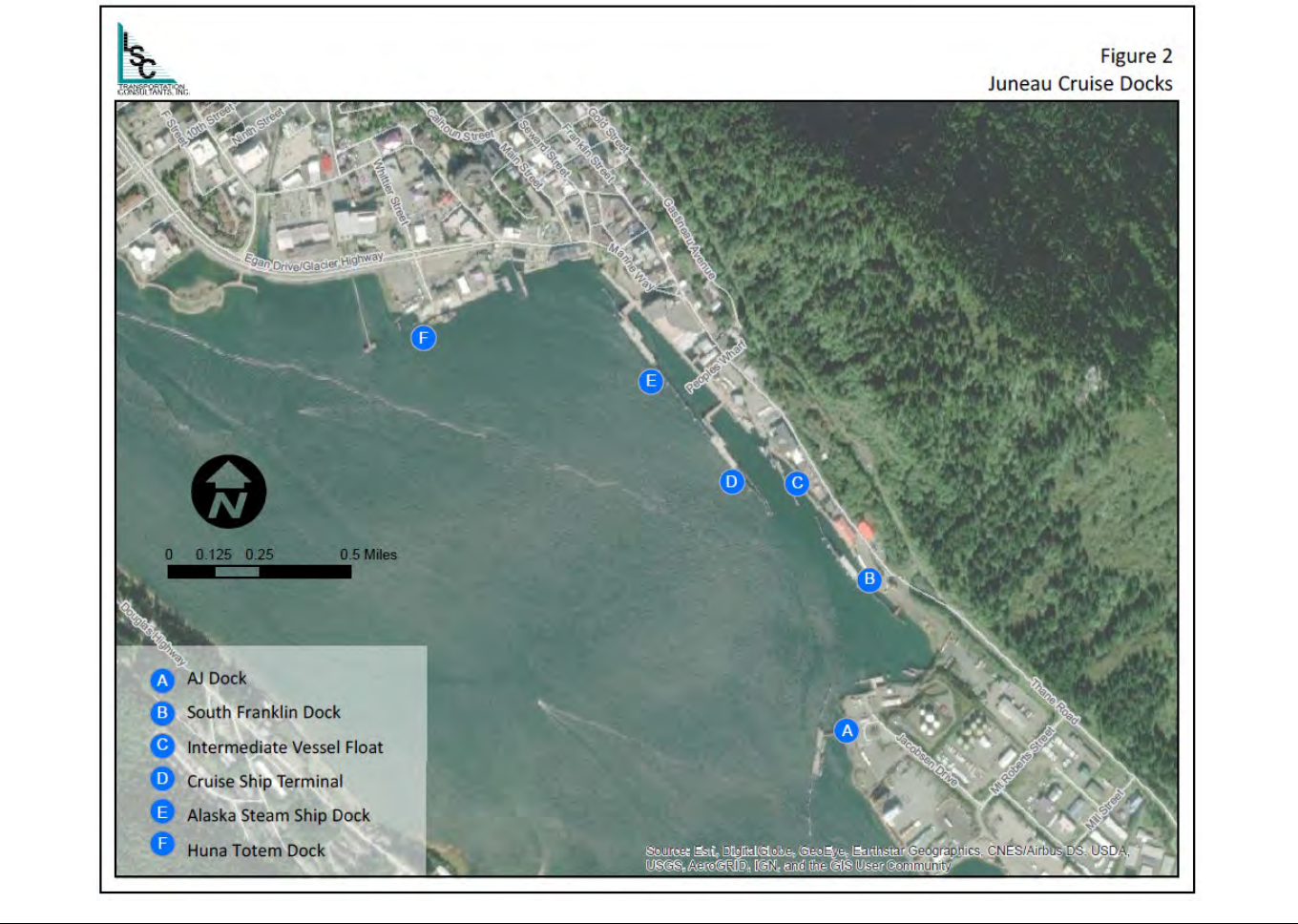
Juneau Visitor Circulator Study LSC Transportation Consultants, Inc.
City and Borough of Juneau Page 7

Juneau Visitor Circulator Study LSC Transportation Consultants, Inc.
City and Borough of Juneau Page 8
TRAFFIC VOLUMES AND DELAYS
For the purpose of this study, pre-Covid Annual Average Daily Traffic (AADT) volumes were analyzed, as
shown in Tables 4 and 5. For most major roads (Table 4), traffic volumes have remained steadily
increasing year over year prior to the pandemic. Of the major roadways near Juneau, Mendenhall Loop
Road has seen the greatest increase in daily traffic volumes increasing 14 percent, with a high of 5,353
vehicles per day in 2017. The second largest growth in volumes could be seen along Riverside Road with 9
percent growth since 2012. While the pandemic has reduced these volumes to close to 2012 levels, they
can be expected to return to pre-pandemic levels in the future.
Downtown Juneau traffic volume data is shown in Table 5. The roadway that had grown the most pre-
pandemic, was Thane Road near Mt Roberts Tram Parking (38 percent), followed by Glacier Highway and
Willoughby Avenue - Between Behrends Avenue and 12
th
Street (28 percent). These volumes and traffic
patterns will be considered in greater depth in later Tech Memos as possible circulator solutions are
being evaluated.
VISITOR CHARACTERISTICS
The Juneau Visitor and Economic Impact Study was completed by McDowell Group in 2017. The study was
written using data gathered by the Alaska Visitor Statistics Program 7 (AVSP) conducted in 2016. Key
characteristics of Juneau visitors included the following:
• Of the 1,093,000 out or state visitors, 1,015,000 (93 percent) arrived by cruise ship, followed
by 61,000 visitors (6 percent) who arrived by Air, and 17,000 visitors (2 percent) who arrived
by ferry.
Table 4: Juneau AADT by Location and Year - Major Roads
Year
Juneau -
Auke Bay
Juneau - Egan
@ 3mile
Juneau -
Riverside Dr.
Juneau -
Mendenhall
Juneau -
Sunny Pt.
2012 2,086 21,428 3,920 4,508 25,281
2013 2,107 21,225 3,969 - 25,254
2014 2,108 21,412 3,967 4,520 26,795
2015 2,
189 21,719 3,861 5,181 27,201
2016 2,191 22,585 3,915 3,518 24,963
2017 2,142 21,320 4,042 5,353 24,749
2018 2,125 21,449 4,045 5,016 25,137
2019 2,205 22,317 4,291 5,141 24,910
2020 2,120 16,900 3,850 4,230 20,200
2021 2,150 17,800 3,980 4,530 22,200
% Change 2012-19 6% 4% 9% 14% -1%
% Change 2012-21 3% -17% 2% 0% -12%
Source: LSC Transportation Consultants and Alaska Traffic Data
Pandemic

Juneau Visitor Circulator Study LSC Transportation Consultants, Inc.
City and Borough of Juneau Page 9
• Cruise passengers were most likely to participate in whale watching and other day cruises (31
percent), followed by city/sightseeing tours, tram, hiking/nature walks, and wildlife viewing.
Highway/ferry visitors reported a wide range of activities, topped by hiking/nature walks,
wildlife viewing, and museums. Air visitors were much more likely to go fishing (17 percent)
than other markets.
• The average age of Juneau visitors was 56.2 years. The average age of those visiting only
Juneau were the youngest (47.3 years), while marine highway/ferry visitors were the oldest
at 57.3 years.
• The most common age group was 65 and older (33 percent) for all travel markets. This
percentage reflects an increase from 27 percent in 2011.
The Alaska Visitor Volume Report was also completed by the McDowell Group in 2020 and includes data
from the 2018-2019 winter season and 2019 summer season. According to the study, 98 percent of all
Alaska’s cruise ship visitors visit Juneau, making it the busiest port in Alaska (p.6). Prior to the pandemic,
cruise passenger volume over the previous decade had grown at an average of 3.7 percent year over
year. However, 2019 experienced the largest increase in cruise passenger volume with a 9 percent
increase over the previous year. Another point of interest included the visitor industry executives
McDowell Group interviewed for the report. A summary of these interviews provided the following
insights in relation to cruise ship passengers:
Table 5: Downtown Juneau AADT by Location and Year - Local Roads
Location 2014 2015 2016 2017 2018 2019
2014-18
Change
Glacier Highway/Willoughby Ave Between Norway Point & Ross Way
969 1,063 - 1,071 1,061 1,130 17%
Glacier Highway and Highland Dr
20,580 22,713 23,619 22,805 20,777 21,620 5%
Behrends Ave. - Between Glacier Highway/Willoughby Ave & Ross Way
120 150 192 138 176 155 29%
Highland Dr & Beharends Ave
2,034 1,930 1,862 2,095 2,479 2,642 30%
Glacier Highway/Willoughby Ave - Between Behrends Ave & 12th St
2,093 2,037 1,965 2,127 2,523 2,689 28%
12th St - Between Egan Dr & Glacier Highway/ Willoughby Ave
2,448 2,488 2,864 3,179 2,732 2,791 14%
Glacier Highway/Willoughby Ave - Between 12th St & 10th St
2,882 2,694 2,681 2,914 3,208 3,278 14%
Glacier Highway/Willoughby Ave - Between 10th St & Glacier Ave
5,055 5,136 5,112 5,157 5,276 5,391 7%
Glacier Highway/Willoughby Ave - Between Whittier St & Egan Dr
1,564 1,819 1,810 1,532 1,596 1,630 4%
12th St and 10th St
21,000 21,318 22,733 21,949 18,158 18,894 -10%
10th St - Between Egan Dr & Willoughby Ave
5,248 5,332 5,465 6,066 4,935 5,042 -4%
Glacier Ave - Between Egan Dr & Willoughby Ave
1,691 1,717 1,838 1,804 1,750 1,865 10%
Glacier Ave & Whittier St
14,940 15,166 15,803 15,258 11,942 12,426 -17%
Whittier St & Willoughby Ave
13,887 14,098 - - 13,212 13,748 -1%
Willoughby Ave & Main St
12,250 12,436 13,796 13,320 13,212 13,748 12%
Gold St- Between 4th St & 8th St
491 502 509 560 479 460 -6%
4th St - Between Franklin St & Gold St
1,298 1,323 1,276 1,358 913 1,124 -13%
Franklin St - Between Front St & 4th St
- - - - 2,020 1,524 --
Seward St - Between 4th & Front St
- - - - 835 1,124 --
Seward St - Between Front St & Marine Way
1,850 1,880 1,299 1,441 1,252 1,279 -31%
Ferry Way - Between Marine Way & Franklin St
1,372 1,394 913 1,013 1,019 1,041 -24%
Franklin St - Between Mt Roberts Tram Parking & Marine Way Roundabout
5,266 5,351 5,955 5,860 3,925 4,010 -24%
Thane Rd & Mt Roberts Tram Parking
3,369 3,423 3,407 4,183 3,716 3,797 13%
Source: LSC Transportation Consultants and Alaska Traffic Data

Juneau Visitor Circulator Study LSC Transportation Consultants, Inc.
City and Borough of Juneau Page 10
• “Passengers were less likely to purchase land tours with their cruise. Lower average incomes
and last-minute planning were cited as factors.” (Pg 8)
• “Cruise passengers are becoming more savvy about traveling independently and planning less
traditional land tours. They want more customization.” (Pg 8).
• “They are more comfortable navigating on their own than in the past. One contact also
observed a trend of cruise passengers desiring smaller groups.” (Pg 8).
These observations could indicate cruise passengers potential preference in planning their own day trips
and shore excursions with the flexibility provided by public transit instead of pre-planned tour. Less
reliance on private, curated tours could mean an increase in visitors using technology to research
alternative ways of getting in and around Juneau and its various attractions.

Juneau Visitor Circulator Study LSC Transportation Consultants, Inc.
City and Borough of Juneau Page 11
Chapter 3
EXISTING T
RANSPORTATION SERVICES
INTRODUCTION
The following chapter describes the existing transit and transportation network that provides mobility
throughout the City of Juneau with connections to Douglas Island and Mendenhall Valley. These services
include both public and private entities and are described in further detail below.
TRANSPORTATION SERVICES
Public Transportation - Capital Transit
Since 1970, Capital Transit has provided public transportation for Juneau. Capital Transit offers nine fixed
routes and a paratransit dial-a-ride service (Capital AKcess). The following sections provide an overview of
existing routes and ridership.
Existing Routes and Services
As of November 7, 2022, Capital Transit revised their current fixed route services. These routes are
summarized below and shown in Figure 3. An overview of each route’s schedule and frequency is
summarized in Table 6. Capital Transit has been affected by the nationwide driver shortage and
periodically needs to suspend service to some routes due to low staffing. Notifications are posted on the
Capital Transit website ( https://juneaucapitaltransit.org/).
•
Route 1: Douglas
begins at the Treadwell Ice Arena in Douglas and travels north towards
Downtown Juneau. Major stops along the route include the Douglas Post Office, the Breeze-
In, the Federal Building, and the State Museum.
•
Route 3 & 4: Mendenhall Valley
runs in both counterclockwise (Route 3) and clockwise (Route
4) directions. The route travels between Mendenhall Valley and Downtown Juneau making
stops at the Valley Transit Center, Nugget Mall, Fred Meyer, Bartlett Regional Hospital,
Federal Building, State Museum, and the Downtown Transit Center.
•
Route 5: University Connector
begins at the University of Alaska and continues on to Auke Bay
and the Valley Transit Center.
•
Route 6: Riverside/Airport Connector
runs between the Juneau International Airport, Nugget
Mall, and the Valley Transit Center.
•
Route 7: Lemon Creek Express
has one early morning run that begins at the Valley Transit
Center making stops at the Nugget Mall, Fred Meyer, the Federal Building, and the
Downtown Transit Center and two afternoon runs heading in the opposite direction.
•
Route 8: Downtown/Valley Express
runs between the Downtown and the Valley Transit
Centers making stops at Fred Meyer, Glacier Highway, Tonsgard Court, Dredge Lake Road,
and Auke Bay.
• Route 9: Egan Express runs once in the morning between the Downtown and the Valley
Transit Centers making one stop only at the Federal Building.

Juneau Visitor Circulator Study LSC Transportation Consultants, Inc.
City and Borough of Juneau Page 12
•
Route 10: Taku Express
runs between the Juneau Job Center and the Valley Transit Center
making stops at Dimond Park, Julep Street and Riverside Drive, and Mendenhall Loop Road.
Capital Transit offers a Ride Free Zone for locals and visitors who may experience mobility issues or are
interested in getting to the Capital, Juneau-Douglas City Museum, Dimond Courthouse, Juneau Hostel, or
other locations at the top of the hill. There are four bus stops in the Ride Free Zone – the Marine Parking
Garage (at the Downtown Library), on Franklin Street near the old Gunakadeit Park (Pocket Park), on
Fourth Street near Rainbow Foods, and the Downtown Transit Center. A map of the Capital Transit Ride
Free Zone is found here:
http://capitaltransit.wpenginepowered.com/wp-
content/uploads/2017/08/Capital-Transit-Ride-Free-Zone-Map.pdf
Major connections between routes are made at the Downtown Transit Center and the Valley Transit
Center. There are about 128 bus stops within the Capital Transit system, 15 of which are located in
downtown Juneau, as also shown in Figure 3. Of the bus stops located in the downtown area, there are
seven covered bus shelters.
Table 6: Capital Transit Current Services and Frequency
Route Start End Start End Start End
Route 1: Douglas 6:58 AM 10:48 PM 6:58 AM 10:48 PM 8:58 AM 5:48 PM Half-Hourly
Route 3: Mendenhall Loop Counterclockwise 7:58 AM 11:36 PM 7:
58 AM 11:36 PM 8:58 AM 6:06 PM Hourly
Route 4: Mendenhall Loop Clockwise 6:44 AM 11:16 PM 6:49 AM 11:16 PM 9:19 AM 6:36 PM Hourly
Route 5: University Connector 6:48 AM 4:56 PM Note 1 - - - - Hourly
Route 6: Riverside/Airport Connector 6:50 AM 5:28 PM Note 1 - - - - Hourly
Route 7: Lemon Creek Express 6:50 AM 7:25 AM Note 2 - - - - 1 AM Run, 2 PM Runs
Route 8: Valley Express 6:38 PM 5:03 PM - - - - Half-Hourly
Route 9: Egan Express 6:35 AM 7:22 AM - - - - 3 AM Runs, 2 PM Runs
Route 10: Taku Connector 6:16 AM 7:01 AM - - - - 3 AM Runs
Source: Capital Transit, 2022 Note 1: Mid-day runs (10 AM - 2 PM) currently not operated due to staff shortage.
Note 2: 7:05 AM and Mid-day runs (9 AM - 2 PM) currently not operated due to staff shortage.
Saturday
Sunday
Service Hours
Weekend Service
Weekday Service
Service
Frequency
(Minutes)
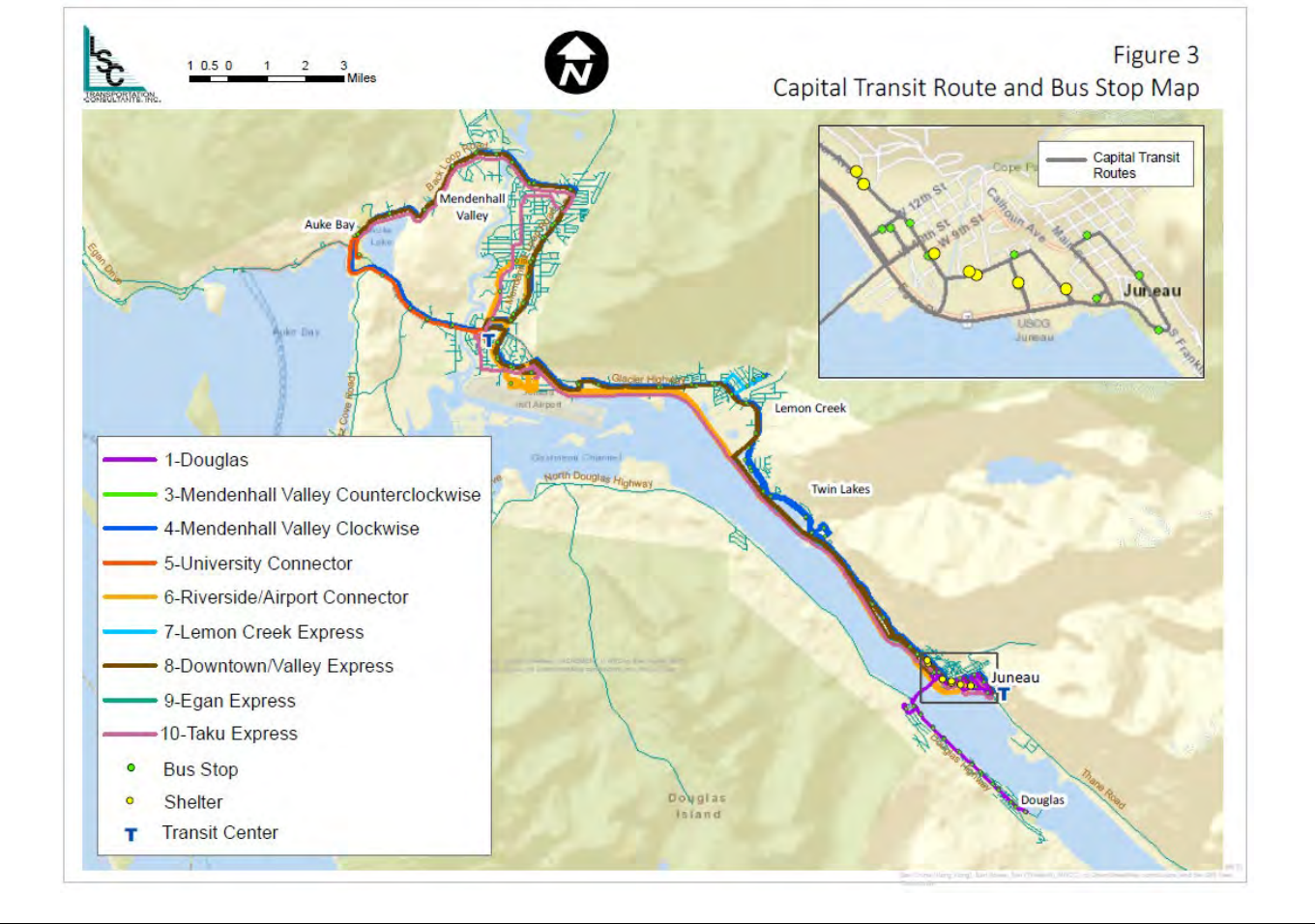
Juneau Visitor Circulator Study LSC Transportation Consultants, Inc.
City and Borough of Juneau Page 13

Juneau Visitor Circulator Study LSC Transportation Consultants, Inc.
City and Borough of Juneau Page 14
Bus Stops and Shelters
Major connections between routes are made at the Downtown Transit Center and the Valley Transit
Center. There are about 128 bus stops within the Capital Transit system, 15 of which are located in
downtown Juneau, as also shown in Figure 3. Of the bus stops located in the downtown area, there are
seven covered bus shelters.
Historic and Recent Ridership
Annual ridership over the last seven years is shown in Figure 4. Ridership was around 1 million passengers
each year up until FY 2020/21 when ridership dropped from 1,036,923 passengers in FY 2019/20 to
485,128 passengers (a decline of 53 percent). In the most recent year (FY 2021/22) ridership rebounded
somewhat by 25 percent to 606,648 but is still 41 percent lower than in FY 2019/20.
Figure 5 and Table 7 depicts monthly ridership by fiscal year. As shown, peak ridership tends to occur
during the summer months, though that month may vary between June, July, and August. The summer
ridership growth over the last two years is relatively strong (29 to 36 percent, depending on month)
compared to the remainder of the year (22 percent), possibly reflecting the return of summer visitors.
Ridership Characteristics
The firm of Rain Coast Data conducted the Juneau Transit Survey
1
in April and May of 2022, which
surveyed a total of 625 Juneau residents (of which 363 were Capital Transit users). Key findings pertinent
to the circulator issue are as follows:
• Primary reasons for using Capital Transit are to travel to work (69 percent of riders) and
shopping (66 percent of riders).
• Most riders are long-time users of the system, with a majority using it for more than 10 years.
1
“Juneau Transit Survey 2022,” Rain Coast Data, May 2022, https://capitaltransit.wpenginepowered.com/wp-
content/uploads/2022/09/Final-CBJ-Transit-Survey-with-Appendix.pdf
Year Jan Feb Mar A
pr May Jun Jul Aug Sep Oct Nov Dec Total
FY 2016 83,163 82,322 92,218 89,675 98,201 100,420 110,129 106,558 99,980 94,585 80,127 83,642 1,121,020
FY 2017 78,568 80,354 89,810 85,130 89,917 97,510 104,619 100,855 91,188 85,936 75,386 77,248 1,056,521
FY 2018 76,186 76,201 86,398 84,649 92,418 96,977 90,072 97,568 83,045 79,280 72,641 73,543 1,008,978
FY 2019 76,881 76,027 86,539 89,440 97,931 97,858 94,355 99,846 86,563 82,991 75,151 68,722 1,032,304
FY 2020 73,843 71,018 85,100 86,777 97,842 96,126 99,830 103,929 88,636 85,960 76,604 71,258 1,036,923
FY 2021 39,780 31,657 39,122 39,116 39,108 50,488 41,051 42,400 43,345 45,092 35,187 38,782 485,128
FY 2022 37,630 43,121 52,419 54,298 59,673 68,847 53,017 54,673 47,985 47,275 44,347 43,363 606,648
Source: Capital Transit Ridership, FY 2015/16 - FY 2021/22
Table 7: Capital Transit Ridership by Month
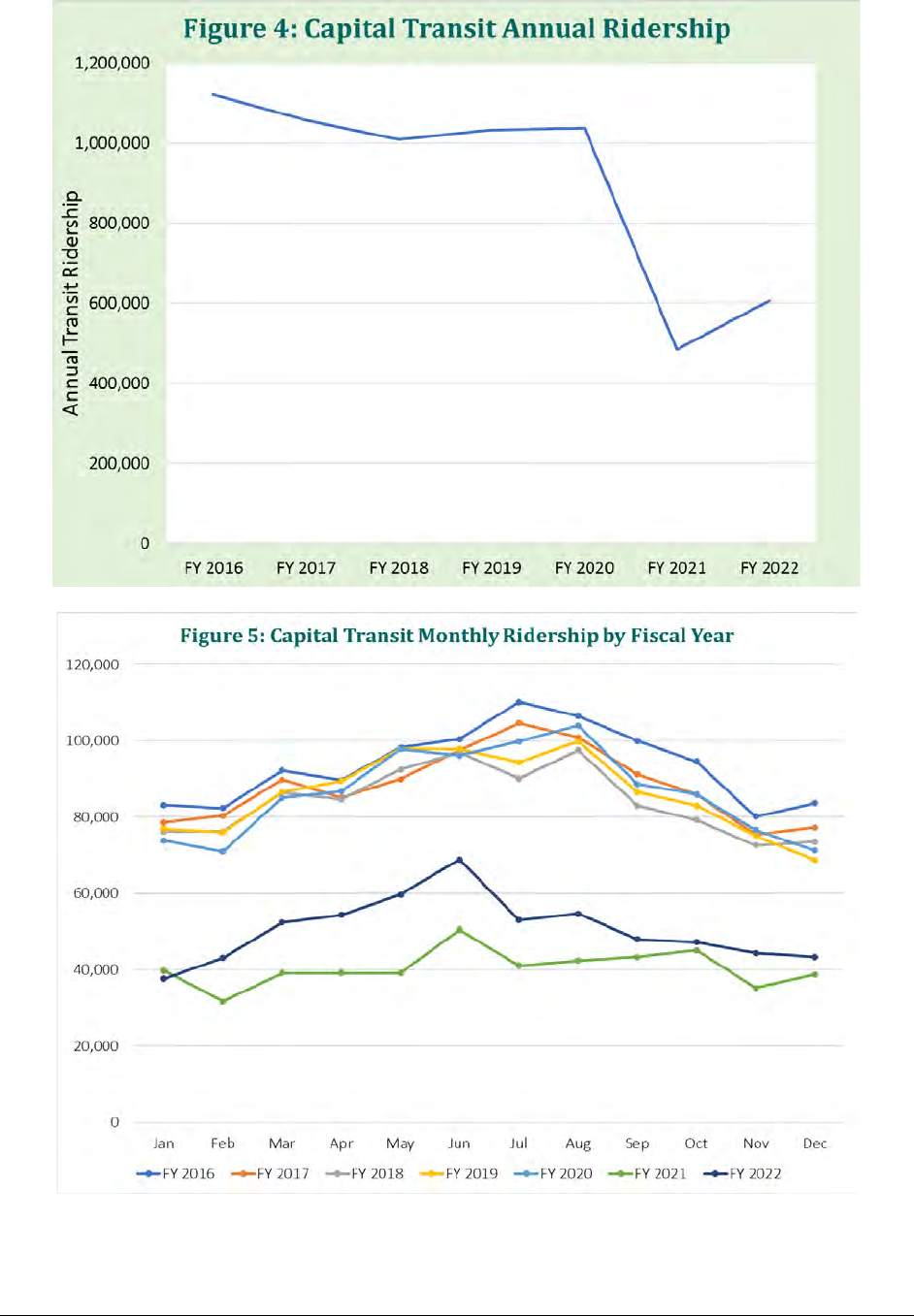
Juneau Visitor Circulator Study LSC Transportation Consultants, Inc.
City and Borough of Juneau Page 15

Juneau Visitor Circulator Study LSC Transportation Consultants, Inc.
City and Borough of Juneau Page 16
• 45 percent were members of a low-income household, 47 percent were Alaska Natives, 15
percent were persons with a disability and 13 percent were age 65 or above.
• Riders indicated a preference for a simpler route network with more frequent and consistent
service.
Operations, Fleet, and Maintenance
Capital Transit operates out of a modern operational and maintenance facility, located at 10099
Bentwood Place in the Mendenhall Valley. Capital Transit has a fleet of 17 35-foot Gillig buses and 1 40-
foot Proterra electric bus that are inspected, maintained, and stored in this facility. Staff reports that
there is no capacity at this facility for a substantial increase in the fleet.
Capital AKcess
Capital AKcess provides paratransit service in accordance with the Americans with Disabilities Act of 1990.
Their services are intended to provide disabled individuals who are unable to use fixed route services and
who are certified as ADA paratransit eligible as outlined in their Rider’s Guide. Visitors may also ride
Capital AKcess if they are able to provide specific eligibility documentation. As shown in Table 8 and
Figure 6, ridership was above 30,000 passengers per year prior to the pandemic. While FY 2021 saw a
decrease to 17,358 passengers, ridership has been steadily rising.
Table 8: Capital Akcess Annual Ridership by Month
FY 2018 FY 2019 FY 2020 FY 2021 FY 2022
January 3,186 2,887 2,399 1,258 1,516
February 2,921 2,612 2,193 1,306 1,741
March 3,328 2,855 1,747 1,680 2,054
April 3,034 2,740 894 1,616 1,961
May 2,995 2,683 1,061 1,502 1,824
June 2,968 2,517 1,204 1,669 1,925
July 2,783 2,707 2,457 1,339 1,715
August 2,984 3,170 2,440 1,311 1,647
September 2,913 2,774 2,436 1,354 1,527
October 2,970 3,087 2,544 1,440 1,651
November 2,838 2,736 2,308 1,287 1,676
December 2,907 2,690 2,368 1,596 1,827
Total 35,827 33,458 24,051 17,358 21,064
Source: Capital Transit, November 2022
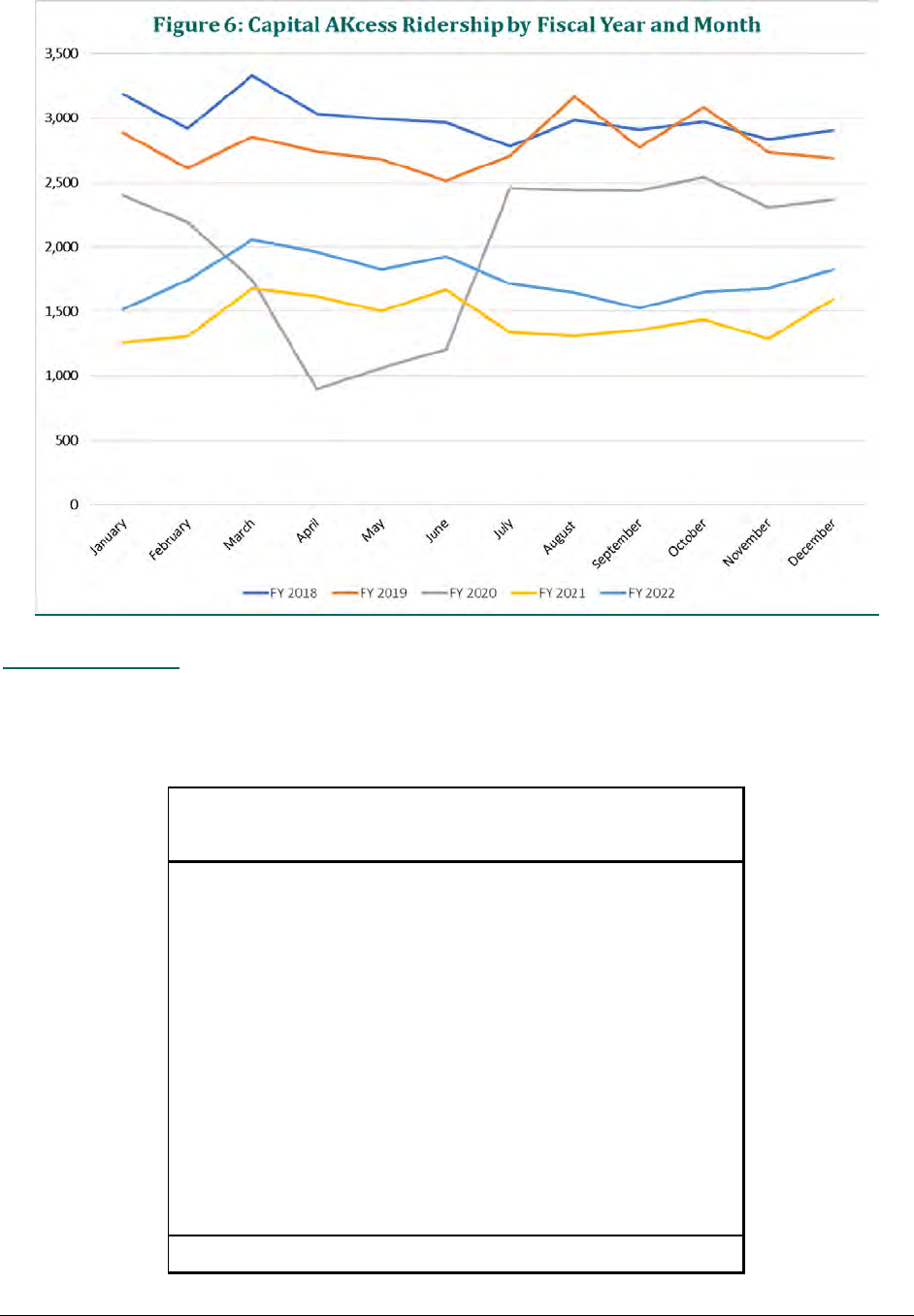
Juneau Visitor Circulator Study LSC Transportation Consultants, Inc.
City and Borough of Juneau Page 17
Cost for Services
Table 9 summarizes Capital Transit’s cost per mile, hour, and passenger trip for both fixed route and
demand response services during FY 2022. As shown, the fixed route cost per mile was $12.05 and cost
per hour was $164.72. Demand Response services cost a little less at $5.25 per mile and $95.06 per hour.
Table 9: FY 2022 Capital Transit Cost for Services
Total
Fixed Route
Vehicle Revenue Miles
491,823
Vehicle Revenue Hours
35,972
Regular Unlinked Passenger Trips
606,648
Cost Per Ride
$9.77
Cost Per Mile
$12.05
Cost Per Hour
$164.72
Demand Response
Vehicle Revenue Miles
177,352
Vehicle Revenue Hours
9,794
Regular Unlinked Passenger Trips
18,762
Sponsored Unlinked Passenger Trips
2,302
Cost Per Ride
$44.20
Cost Per Mile
$5.25
Cost Per Hour
$95.06
Source: Capital Transit FY 2022 Grant Reporting

Juneau Visitor Circulator Study LSC Transportation Consultants, Inc.
City and Borough of Juneau Page 18
These values were created using Capital Transit’s budget costs and revenue, including grants. Fare
revenues for that fiscal year were approximately $116,000. In addition to fares and local funding, Capital
Transit received the following a Federal 5311 grant for $979,379 and a CARES Act grant for $2,031,150.
Historically in years without pandemic related funding, over 70% of Capital Transit’s funding comes from
Juneau residents through property and sales taxes.
Private Transportation Services
The region has approximately 27 various private tour and transportation providers that cruise ship
passengers and other visitors may book while visiting Juneau. Their services include transportation and
tours to Mendenhall Glacier, and other attractions, shopping districts, helicopter tours, and other
sightseeing/outdoor adventures. LSC Transportation Consultants, Inc. reached out to private
transportation services in Juneau. In response, each private entity provided varying levels of details about
their operations. The following section provides a brief description of each major transportation service
provider in the area, followed by smaller companies and the services they currently provide.
Alaska Coach Tours
Alaska Coach Tours provides private group tours in Juneau and other major communities of southeast
Alaska including Ketchikan, Skagway, and Sitka. The company was formed in 2004 with the sole purpose
of providing transportation and tours for Royal Caribbean, Celebrity, Regent, Oceania, UnCruise
Adventures, and Lindblad Expeditions/National Geographic cruise lines in Southeast Alaska. Their entire
fleet is made up of 85 motorcoaches.
Holland America-Princess Alaska-Yukon
Holland America Princess (HAP) provides eight primary tours within Juneau, in addition to six other tours
provided on behalf of various cruise lines directly. With a fleet of 73 revenue vehicles, the service
provides tour transportation to approximately 500,000 passengers annually, with a weekly total of about
24,000 passengers during the peak season.
HAP has their own Maintenance Department consisting of a Foreman, Lead Mechanic, 4-5 Mechanic
Technicians (year-round), 1-2 seasonal Mechanic Technicians, and 1 Parts Administrator. Historically, the
operation employs up to 80 drivers in the peak summer, though pandemic and driver shortages have
reduced this figure to about 45 drivers per season in recent years. HAP utilizes RTA software for its
preventative maintenance program that tracks annual maintenance, scheduled maintenance, and defect
repairs in accordance with FMSCA requirements. RTA interfaces with the Zonar electronic inspection and
GPS tracking system that is installed in all HAP commercial vehicles.
HAP currently keeps a diesel fuel tank on property and has an arrangement in place with Petro 49 for
fueling needs – including delivery of biodiesel that is mixed on property with regular diesel during tank fill
ups at a range of between 5 and 8 percent. The tank on property was provided by Petro as part of their
service. During the season, the tank is filled approximately twice a week.

Juneau Visitor Circulator Study LSC Transportation Consultants, Inc.
City and Borough of Juneau Page 19
Juneau Tours
Juneau Tours have been providing tour and transportation services to the Juneau area for 17 years for
both visitors and residents. Serving over 90,000 visitors annually, they provide four types of tours during
the summer season. They have a 3.5-hour whale watching and marine life boat tour that you may book
with a group or as a private excursion. Each also includes transportation to and from Statter Harbor.
There are also two types of bus tours; one that focuses only on visiting the Mendenhall Glacier, and
another that visits both the Mendenhall Glacier as well as downtown Juneau. During the winter season
they also provide special event transportation within downtown Juneau using their trolley bus.
M & M Tours of Juneau
M&M Tours provides three major bus tours within Juneau as well as one overnight tour from Juneau to
Haines. The three Juneau bus tours include the following: the “Juneau Highlights” tour featuring Douglas
Island, historic Juneau sites (Capital Building, and Marine Park), The “Blue Bus Glacier Express” that runs
between downtown Juneau and the Mendenhall Glacier, and the “AJ Mine Gastineau Mill Tour” that
includes transportation and a guided tour of the AJ Mine. The “Red Trolley Tour” has also been offered in
the past but is currently unavailable for booking. When in operation, the Red Trolley Tour provides
transportation to the Capitol Building, the Governor’s Mansion, City and State Museum, the hatchery, and
Marine Park. M&M also provides several other adventure tours such as sea kayaking, river rafting, and
whale watching. Air tours to see the Mendenhall Glacier and enjoy a sled dog experience are also offered.
Other Transportation Services
Other transportation service providers operate on a smaller vehicle fleet (30 vehicles or less) and include
the following local taxi and shuttle companies:
• Dlux Rides
• Evergreen Taxi
• Juneau Taxi and Tours
• Glacier Taxi and Tours
• Capital Cab
• Goldbelt Transportation
• First Student
• Crew International Tours
• Mendenhall Glacier Transport
• Alaska and Yukon Tours
• Juneau Adventure Tours
• Alaska Shore Excursions
• Liquid Alaska Tours
• Gastineau Guiding
• Juneau Shore Tours

Juneau Visitor Circulator Study LSC Transportation Consultants, Inc.
City and Borough of Juneau Page 20
This page intentionally left blank

Juneau Visitor Circulator Study LSC Transportation Consultants, Inc.
City and Borough of Juneau Page 21
Chapter 4
RELEVANT PLANNING DOCUMENTS AN
D PLANS
INTRODUCTION
This chapter first presents a review of key planning documents that impact the issue of a circulator
service. This is followed by a summary of planned improvements to the port area that will affect visitor
activity patterns in the next few years.
Blueprint Downtown Juneau Area Plan (2022)
The Draft Blueprint Downtown Juneau Area Plan provides an overview of the Downtown area, planning
process, vision, goals, priorities, recommended actions, and measurements for success. While currently in
Public Review, the Area Plan stands to serve as a comprehensive plan for Downtown Juneau. The Area
Plan identifies goals that include providing diverse housing, a variety of mobility options and amenities,
safety measures, managed tourism tactics, economic stability measures, and a sense of place that
prioritizes walking and bicycling.
Chapter 7 of the plan focuses most on transportation, pedestrians, and streetscape. The most pertinent
to our study is the plan’s summary of a tourist transit circulator. Three general concepts are discussed:
• A “tourist shuttle” would relocate all existing staging areas outside of the downtown dock
area to an undefined new location, with arriving cruise passengers using this shuttle to access
private tour operators at the new location.
• A “Capital Transit circulator” would serve the downtown area as well as the Flats/Glacier
Avenue areas to the west.
• According to the plan, a visioning process resulted in the desire for further study to better
understand the potential to reduce traffic levels, logistics, connections with tour buses, costs,
and potential staging areas.
Lastly, there are many actions identified that support the Plan’s goals and priorities. Amongst these
actions, ones that encourage transportation use and aim to improve the area’s sense of place are most
related to the subject of a possible circulator service. In particular, this document indicates that “A
“circulator” system to easily move pedestrians across the downtown core is a highly supported and critical
step to reduce the number of vehicles on the street, as well as downtown parking demand.” (Pg. 24). The
plan also includes an action to “Actively market the existing, free Capital Transit circulator and maximize
its availability with increased frequency.” (p 193)
Tourism Best Management Practices (2022)
Travel Juneau develops an annual Best Management Practices document to guide various aspects of
private tourism-oriented business operations in Juneau. Key to this particular study are the agreements
and restrictions between transportation companies on vehicle staging and operations, as well as the tour

Juneau Visitor Circulator Study LSC Transportation Consultants, Inc.
City and Borough of Juneau Page 22
broker operations. This includes limitations on particular roadways, such as use of South Franklin Street
north of the Red Dog Saloon and 12
th
Street and Calhoun Avenue. Other major best practices related to
transportation include the following:
• Drivers agree not to impede traffic and to maintain a safe travelling speed. Drivers agree not
to use Sandy Beach, Twin Lakes, Cope Park, Eagle Beach, or Auke Bay Recreation Area
(including the Auke Bay Recreation access road) as tour destinations.
• Drivers of all vehicles agree to turn engines off at every reasonable opportunity when loading
and unloading passengers and/or when staging in the various loading zones, staging areas
and tour venues throughout the CBJ.
• Drivers agree to avoid transiting residential streets within the City and Borough of Juneau
unless conducting a specific pick-up or drop-off in the immediate vicinity.
A possible circulator would also need to abide by best management practices and be present for pre-
season transportation meetings in order to align with other public and private transportation providers in
Juneau.
City and Borough of Juneau Transit Development Plan (2014)
A Transit Development Plan (TDP) was conducted by Nelson Nygaard in 2014 to review the Capital Transit
System and Care-a-Van services.
2
Informed by the information gathered and conclusions made in the
2013 Comprehensive Operations Analysis (COA), the TDP provided recommendations that supported the
following five major goals:
1. Ensure that routes have adequate time to operate on-schedule.
2. Better match service levels with ridership demands to ensure resources are being used in the
most efficient way possible.
3. Evaluate requests/demands for service to new areas.
4. Strive to ensure high-quality and convenient service.
5. Ensure that service design, marketing information, buses, and other elements of the service are
as legible and easy to understand as possible.
In support of these goals, several short-term recommendations and actions were made including
“Implement a Downtown Circulator route.” There was significant demand expressed during this study for
a dedicated downtown circulator to provide service every 15 minutes. The implementation of a
downtown circulator bus that operates from 7:00 AM to 11:00 PM seven days a week would cost
approximately $600,000 per year to operate and cannot be accommodated within existing budget
levels.1 Instead, service would be provided around the downtown loop every 30 minutes by the Douglas
route.” (Pg. 2-2)
2
“City and Borough of Juneau Transit Development Plan: Final Report,” Nelson Nygaard, Feb 2014;
http://juneaucapitaltransit.org/wp-content/uploads/2016/04/JUNEAUTDP-Final-140213.pdf

Juneau Visitor Circulator Study LSC Transportation Consultants, Inc.
City and Borough of Juneau Page 23
City and Borough of Juneau Comprehensive Operations Analysis (2013)
The COA for CBJ was completed in 2013 by Nelson/Nygaard Associates Inc. The COA provides an overview
of demographic trends as they relate to transit system characteristics. While it provided a summary of
Capital Transit’s system and routes it also conducted a fair share of public outreach and community
engagement with a study advisory group, stakeholders, and transit operators. It was noted throughout
the analysis that both stakeholders and the general public were generally interested in a circulator transit
service that would serve downtown. While conducting a “tradeoff exercise,” 75 percent of stakeholders
stated that they’d like to see downtown improved by creating a separate downtown circulator route,
while 25 percent preferred making better use of existing bus routes serving downtown.
City and Borough of Juneau Comprehensive Plan (2013)
An update to the CBJ Comprehensive Plan was completed in 2013. Chapter 8 discusses eight policies and
actions to support transportation services within the region. Those related to public transportation within
Juneau include the following:
• Policy 8.4. To support the improvement of transportation facilities and systems that reinforce
Juneau’s role as the capital city of Alaska and a regional transportation and service center.
• Policy 8.5. To promote a balanced, well-integrated local multi-modal surface transportation
system that provides safe, convenient, and energy-efficient access and transport for people
and commodities.
• Policy 8.6. To promote and facilitate transportation alternatives to private vehicles as a
means of reducing traffic congestion, air pollution and the consumption of fossil fuels, and to
provide safe and healthy means of transportation to all people.
While a circulator would support any of the above-mentioned policies, it would best implement the
intentions of Policy 8.5 and is listed as an action under 8.5IA6.
Juneau Circulator Feasibility Study Supplement (2011)
In 2011 Moore & Associates completed a Feasibility Study for a Juneau Circulator. The study included
public outreach via direct mail and online directed towards year-round residents living and or working in
downtown Juneau. The major survey findings from the study included the following:
- When asked which type of service residents preferred, 63 percent indicated a year-round service.
o Of those respondents, 46 percent answered that they would use it frequently if
implemented.
- When asked how the service should be provided, 50 percent said they’d like the service to be
provided by Capital Transit, followed by 26 percent answering they’d like it to be instead of
Capital Transit.
- Preferred routes and destinations included the Federal Building (46 percent), Dept of Labor /Fish
and Game (40 percent), and 12
th
Street/Calhoun Avenue (38 percent).
- 50 percent of respondents wanted the service to come every 30 minutes, followed by 45 percent
preferring the service to run every 15 minutes.

Juneau Visitor Circulator Study LSC Transportation Consultants, Inc.
City and Borough of Juneau Page 24
- When asked how frequently participants might use the service, 42 percent stated 0-2 times per
week, followed by 33 percent who would use the service 3-5 times per week. Only 15 percent
indicated that they would not use the service at all.
With survey results and data collection in mind, the Feasibility Study offered six different alternatives for
a downtown circulator. Each alternative shared the same following assumptions:
• Summer service would run seven days per week between 7:00AM and 8:00 PM
• Winter service would only run Monday through Friday between 9:00 AM and 6:00 PM.
• The service would run on 15-minute headways in only one direction.
• The service would be provided using two vehicles.
• In the summer, the service terminus would be the Princess Dock and in Winter it would be at
the Library stop located at South Franklin and Egan.
Each alternative varied slightly with destinations and routes. The Feasibility Study recommended
Alternative B with the following destinations in mind: downtown retail and restaurants, City Museum,
State Buildings, Department of Labor, Department of Fish and Game, and other Key Employers along Egan
Drive.
2003 Long Range Waterfront Master Plan for the City and Borough of Juneau
Bermello, Ajamil & Partners, Inc. completed the Long Range Waterfront Master Plan in 2003. The plan
provides an overall vision for Juneau’s waterfront area. The plan had the four following overarching goals:
1. Enhance community quality of life.
2. Strengthen tourism product offerings as well as downtown retail, entertainment, residential and
service activities.
3. Improve Juneau’s image and attractiveness for investment.
4. Recognize current waterfront uses and provide protection for pockets of working waterfront.
To best plan for the future of Juneau’s downtown waterfront, the plan divided the area into the following
six subareas:
• Area A: Juneau-Douglas Bridge to
Gold Creek
• Area B: Subport
• Area C: Downtown
• Area D: Franklin Street Corridor
• Area E: AJ Rock Dump
• Area F: Little Rock Dump
After an extensive public outreach process, the plan supports the continuation of mixed-use development
throughout Areas A and B. Area C’s (Downtown) goal is to maintain and support historic character,
walkability, and open space. Area D (South Franklin) acts as an extension of the downtown towards south
cruise shop docks and its corridor is to be expanded and maintained. Lastly Areas E and F would continue
to serve as an “important economic engine and logistics point for the community of Juneau” through the
continuation of waterfront dependent and industrial uses.

Juneau Visitor Circulator Study LSC Transportation Consultants, Inc.
City and Borough of Juneau Page 25
Downtown Juneau Tourism Transportation Impact Study (2003)
This study was conducted by Kittelson and Associates, Inc. in 2003, and predates much of the subsequent
port improvements, as well as the Downtown Transit Center. At the time, Capital Transit routes extended
along S. Franklin Street to the Mt. Roberts Tramway. This study focused on roadway and pedestrian
improvements in the dock areas, and did not include recommendations regarding a circulator service,
though many of the stakeholders contacted as part of the study identified the desire for a downtown
shuttle/circulator service.
FUTURE PLANNED DEVELOPMENTS
There are several planned developments to occur in the upcoming decade. However, for the purpose of
this study, developments that has an impact on downtown and the cruise visitor experience are
highlighted below.
Seawalk Connection
The Juneau Seawalk is planned to ultimately connect from Overstreet Park to the AJ Dock. Currently the
Seawalk connects Overstreet Park to Gold Creek and begins again at Marine Park making its way south
the South Franklin Dock. The South Franklin Dock to AJ Dock stretch of the project is currently in the
planning stages and anticipated to begin construction in 2025.
Àak’w Landing
The vacant land and dock space located near Whittier Street and Egan Drive recently changed ownership
from Norwegian Cruise Line to the Huna Totem Group. In November 2022, a conceptual plan was
presented to the Assembly outlining a multiphase development project that includes a new dock, retail
space, open park and entertainment space, and the potential for either conference, residential units, or
office space. The proposed development also features a large parking lot and bus station. The design is
currently in the early development stages with the intention to begin Phase 1 construction in 2024.

Juneau Visitor Circulator Study LSC Transportation Consultants, Inc.
City and Borough of Juneau Page 26
This page left intentionally blank.

Juneau Visitor Circulator Study LSC Transportation Consultants, Inc.
City and Borough of Juneau Page 27
Chapter 5
VISITOR DATA SUMMARY
A circulator service for Juneau considers how best to provide transportation to visitors and tourists. To
better understand those visiting the region, various tourist surveys were summarized below. The
following sections describe visitor volumes, demographics, and modes of transportation.
JUNEAU VISITOR OVERVIEW
Prior to the pandemic, several visitor surveys were conducted in Juneau as well as the greater region of
Alaska. In 2016, the Alaska Visitor Statistics Program (AVSP) contracted the McDowell Group to survey
Juneau travelers. AVSP is a statewide survey of Alaska visitors commissioned by the Alaska Department of
Commerce, Community, and Economic Development and the Alaska Travel Industry Association. In 2017,
McDowell Group summarized this data in the Juneau Visitor Profile and Economic Impact Study. Major
takeaways from this report included the following:
• An estimated 1,093,000 out of state visitors traveled to Juneau between May and September
of 2016.
• A huge majority of visitors arrived by cruise ship (93 percent or 1,016,490), followed by air (6
percent or 65,580), and highway/ferry (2 percent or 21,860).
• While visiting Juneau, cruise ship visitors participated in whale watching and other day cruises
(31 percent), followed by city/sightseeing tours, tram, hiking/nature walks, and wildlife
viewing.
Most recently, the Alaska Visitor Volume Report was completed by McDowell Group in 2020. According to
their summary of the AVSP, 1,305,700 cruise ship passengers visited Juneau in 2019, indicating another
increase over the previous year by 13 percent. Their report goes on to show steady growth in cruise ship
visitor volume year over year prior to the pandemic as shown in Figure 7. According to Cruiseline
International Association 1.1 million people visited Juneau in 2022 with another 1.6 million visitors being
projected for 2023.
Visitor by Mode of Transportation
More recently, Travel Juneau contracted McDowell to conduct a Juneau Air and Ferry Visitor Survey. This
report estimated a total of 1,229,100 visitors between May and September of 2018. This represented an
increase of visitors to the area by 12.5 percent. Similar to 2016, 94 percent, or 1,155,300, of visitors
arrived by cruise ship, followed by 5 percent (63,000) arriving by air, and 1 percent (15,000) arriving by
ferry (Table 10 and Figure 8).
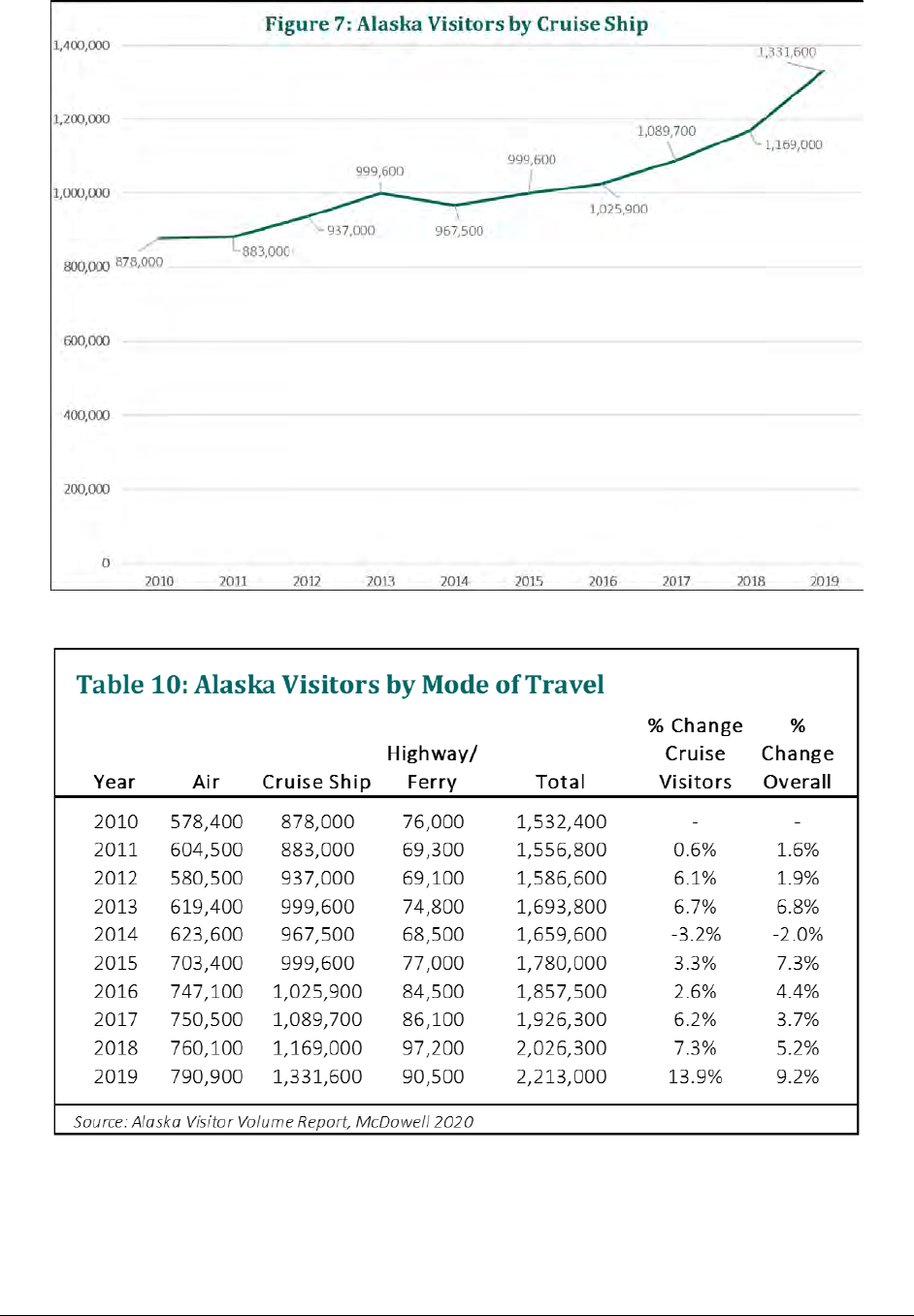
Juneau Visitor Circulator Study LSC Transportation Consultants, Inc.
City and Borough of Juneau Page 28
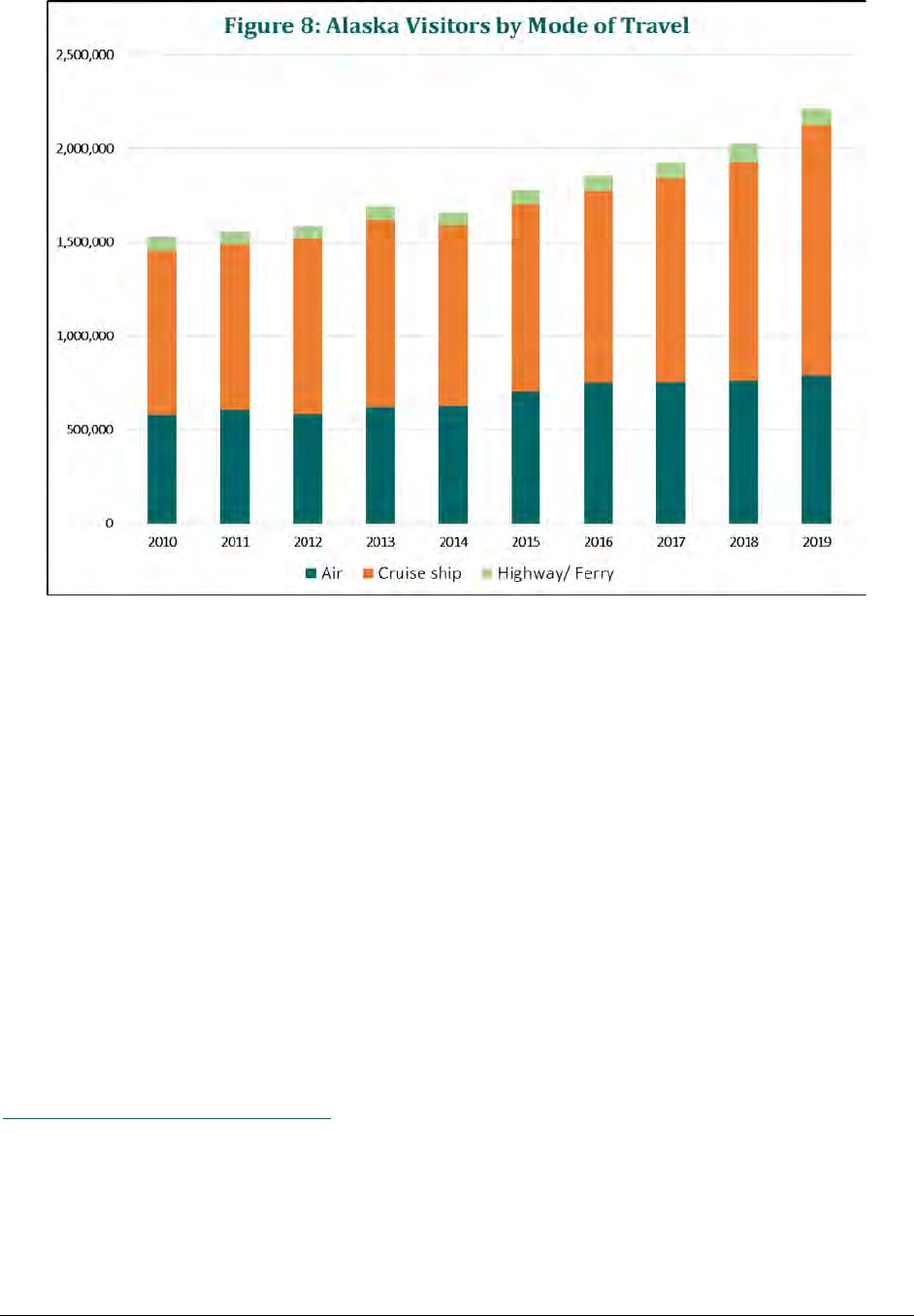
Juneau Visitor Circulator Study LSC Transportation Consultants, Inc.
City and Borough of Juneau Page 29
The Juneau Air and Ferry Visitor Survey summarizes 728 non-cruise ship visitors who spent at least one
night in Juneau. When studying various modes of transportation for these specific visitors, the following
mode split information was identified:
• Air visitors were about equally likely to use rental vehicles (27 percent), taxis (27 percent),
and personal vehicles (25 percent) to get around Juneau, while slightly fewer visitors
reported using hotel/lodging transport (18 percent) and public transportation/buses (10
percent).
• Among air visitors, vacation/pleasure visitors reported a much wider variety of transportation
types compared with other visitors: 34 percent used taxies, 27 percent used rental vehicles,
26 percent used hotel/lodging transport, and 16 percent used public transportation/buses.
Business visitors reported the highest usage of rental vehicles (43 percent), while 19 percent
reported using taxis. VFRs mostly relied upon personal vehicles to get around (75 percent),
with 14 percent using rental vehicles and 10 percent using taxis.
• Ferry visitors relied heavily on personal vehicles to get around Juneau (66 percent), with less
than 15 percent reporting using each of the other modes of transportation.
General Visitor Characteristics
General visitor demographics were collected during the 2016 survey. Major demographic characteristics
identified by the survey included the following conclusions:
• U.S. residents represented 81 percent of Juneau visitors, with Western states being the most
common region of origin (32 percent), followed by the South (24 percent), Midwest (15

Juneau Visitor Circulator Study LSC Transportation Consultants, Inc.
City and Borough of Juneau Page 30
percent), and East (11 percent). Within the West, California, Washington, Oregon, and
Arizona were the most prominent states.
• The average age of Juneau visitors was 56.2 years. Juneau Only visitors were the youngest at
47.3 years, on average, while highway/ferry visitors were the oldest at 57.3 years.
• The most common age group was 65 and older (33 percent) for all travel markets. This
percentage reflects an increase from 27 percent in 2011.
CRUISE SHIP AND PASSENGER ACTIVITY
A key factor in the overall visitor demand for transportation services is the level and pattern of cruise ship
visitation. Juneau’s cruise ship season is greatest during the months of May through September. With an
average of just over a million cruise ship passengers per season, an influx of over 17,000 people can
impact the port over the course of a single day. Table 11 presents an example of the cruise ship capacity
that is in port for each day over a peak summer week in 2002.
Figure 9 presents the arrival and departure times (by day and by passenger capacity), while Figure 10
presents a running total of cumulative capacity in port. This data indicates the following:
• Each day can vary and there is no consistent pattern. This indicates that a circulator program
would need to vary and react to port activity.
• Daily cruise ships in port at once vary between 4 and 6 ships, with individual ship capacities
ranging from as low as 70 passengers and upwards to nearly 5,000 passengers.
• Ships typically arrive in port in the 6 AM and 7 AM hour, though there is typically at least one
ship arriving in the early afternoon (1 PM hour) and scattered arrivals at other times up until
3 PM.
• Ships predominantly depart between 9 PM and 11 PM, though there are departures as early
as the 1 PM hour and another concentration around 5 PM.
• The length of stay in port varies between 7 hours and 16 hours, with an average of 11.3
hours. Longer stays in port increase the potential for individual passengers to make a second
shore trip.
• The peak week peak capacity (17,453 passengers) was reached on both Wednesday and
Saturday, both in the afternoon hours. Even within this peak week, the peak capacity in port
varies by approximately 6,000 passengers (or roughly 30 percent).
• As many as 8,652 passengers may arrive within an hour and 9,175 over a two-hour period,
putting an obvious strain on the ability of ground transportation to serve the passengers
reaching the docks. At the end of the day, up to 12,813 of ship capacity can depart in any one
hour.
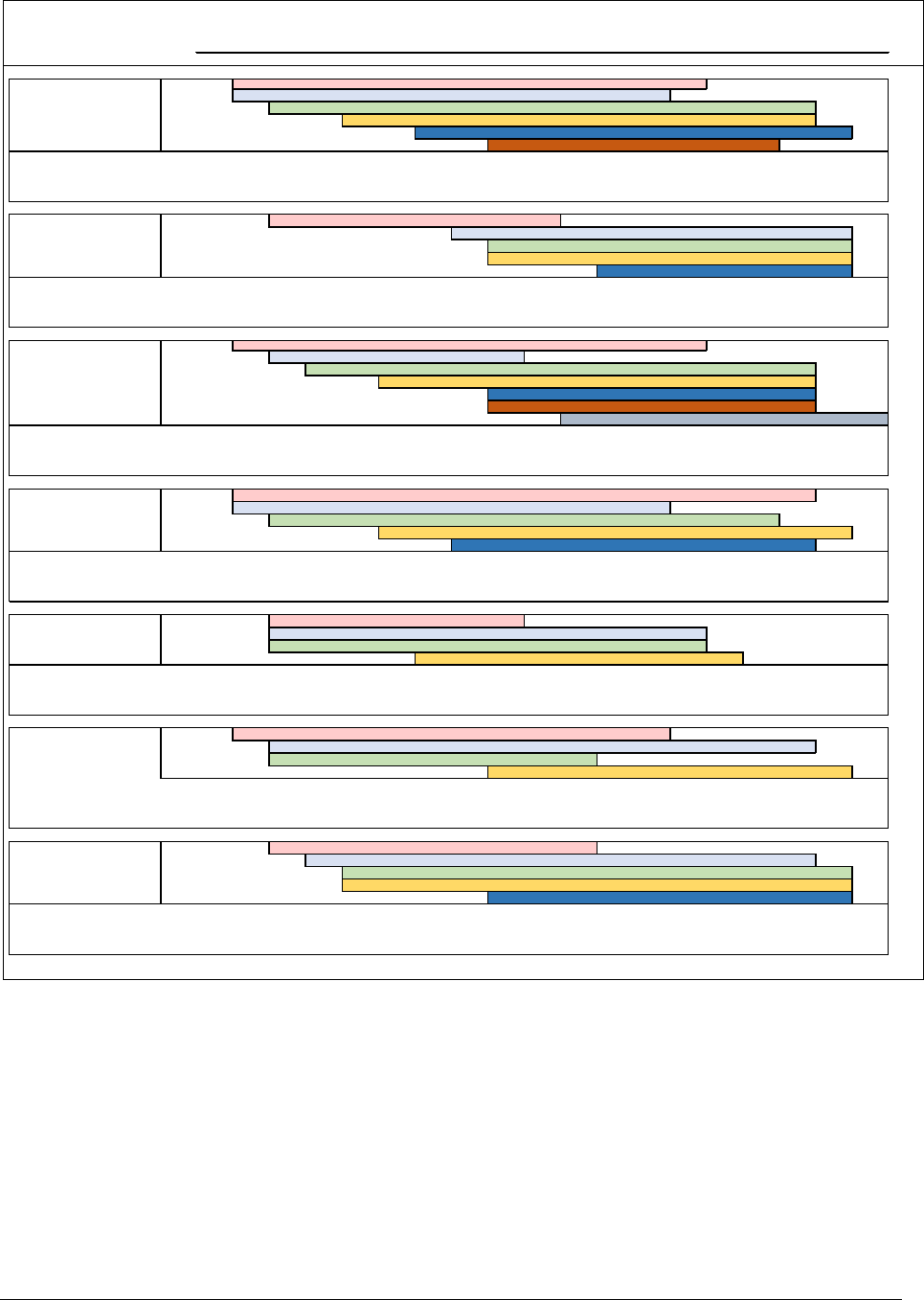
Juneau Visitor Circulator Study LSC Transportation Consultants, Inc.
City and Borough of Juneau Page 31
Table 11: Ships in Port by Day and Hour for Peak Summer Week
July 31 - Aug 6
Ship
Capacity
5 AM 6 AM 7 AM 8 AM 9 AM 1
0 AM 11 AM NOON 1 PM 2 PM 3 PM 4 PM 5 PM 6 PM 7 PM 8 PM 9 PM 10 PM 11 PM
National Geographic 100
1 1 1 1 1 1 1 1 1 1 1 1 1 13
Grand Princess 3,122 1 1 1 1 1 1 1 1 1 1 1 1 12
Carnival Spirit 2,549 1 1 1 1 1 1 1 1 1 1 1 1 1 1 1 14
Celebrity Millenium 2,590 1 1 1 1 1 1 1 1 1 1 1 1 1 12
Silver Shadow 466 1 1 1 1 1 1 1 1 1 1 1 1 12
Radiance of the Sea 2,546 1 1 1 1 1 1 1 1 8
0 2 3 3 4 4 5 5 6 6 6 6 6 5 4 4 3 1 0
Ca
pacity Arriving 0 3,222 2,549 0 2,590 0 466 0 2,546 0 0 0 0 0 0 0 0 0 0
Capacity Departing 0 0 0 0 0 0 0 0 0 0 0 0 3,122 100 0 2,546 5,139 466 0
0 3,222 5,771 5,771 8,361 8,361 8,827 8,827 11,373 11,373 11,373 11,373 11,373 8,251 8,151 8,151 5,605 466 0
Norwegian Sun 2,323 1 1 1 1 1 1 1 1 7
Eurodam 2,525 1 1 1 1 1 1 1 1 1 1 1 11
Koningsdam 3,194 1 1 1 1 1 1 1 1 1 1 10
Solstice 3,420 1 1 1 1 1 1 1 1 1 1 10
Crown Princess 3,674 1 1 1 1 1 1 1 7
0 0 1 1 1 1 1 2 4 4 3 4 4 4 4 4 4 4 0
Ca
pacity Arriving 0 0 2,323 0 0 0 0 2,525 6,614 0 0 3,674 0 0 0 0 0 0 0
Capacity Departing 0 0 0 0 0 0 0 0 0 2,323 0 0 0 0 0 0 0 12,813 0
0 0 2,323 2,323 2,323 2,323 2,323 4,848 11,462 11,462 9,139 12,813 12,813 12,813 12,813 12,813 12,813 12,813 0
National Geographic Sea
70
1 1 1 1 1 1 1 1 1 1 1 1 1 13
Norwegian Bliss 4,903 1 1 1 1 1 1 1 7
Majestic Princess 4,272 1 1 1 1 1 1 1 1 1 1 1 1 1 1 14
Star Breeze 312 1 1 1 1 1 1 1 1 1 1 1 1 12
Ovation of Seas 4,819 1 1 1 1 1 1 1 1 1 9
Westerdam 2,362 1 1 1 1 1 1 1 1 1 9
Norwegian Encore 4,903 1 1 1 1 1 1 1 1 1 9
0 1 2 3 3 4 4 4 6 5 6 6 6 6 5 5 5 1 1
Ca
pacity Arriving 0 70 4,903 4,272 0 312 0 0 7,181 0 4,903 0 0 0 0 0 0 0 0
Capacity Departing 0 0 0 0 0 0 0 0 4,903 0 0 0 0 70 0 0 11,765 0 4,903
0 70 4,973 9,245 9,245 9,557 9,557 9,557 16,738 11,835 16,738 16,738 16,738 16,738 16,668 16,668 16,668 4,903 4,903
Ruby Princess 3,672 1 1 1 1 1 1 1 1 1 1 1 1 1 1 1 1 16
Royal Princess 4,272 1 1 1 1 1 1 1 1 1 1 1 1 12
Serenade of the Sea 2,580 1 1 1 1 1 1 1 1 1 1 1 1 1 1 14
Nieuw Amsterdam 2,527 1 1 1 1 1 1 1 1 1 1 1 1 1 14
Discovery Princess 4,402 1 1 1 1 1 1 1 1 1 1 10
0 2 3 3 3 4 4 5 5 5 5 5 5 4 4 4 3 1 0
Capacity Arriving 0 7,944 2,580 0 0 2,527 0 4,402 0 0 0 0 0 0 0 0 0 0 0
Capacity Departing 0 0 0 0 0 0 0 0 0 0 0 0 4,272 0 0 2,580 8,074 2,527 0
0 7,944 10,524 10,524 10,524 13,051 13,051 17,453 17,453 17,453 17,453 17,453 17,453 13,181 13,181 13,181 10,601 2,527 0
Norwegian Jewel 2,866 1 1 1 1 1 1 1 7
Noordam 2,366 1 1 1 1 1 1 1 1 1 1 1 1 12
Eclipse 3,420 1 1 1 1 1 1 1 1 1 1 1 1 12
Regatta 803 1 1 1 1 1 1 1 1 1 8
0 0 3 3 3 3 4 4 4 3 3 3 3 3 1 0 0 0 0
Capacity Arriving 0 0 8,652 0 0 0 803 0 0 0 0 0 0 0 0 0 0 0 0
Capacity Departing 0 0 0 0 0 0 0 0 2,866 0 0 0 0 5,786 803 0 0 0 0
0 0 8,652 8,652 8,652 8,652 9,455 9,455 9,455 6,589 6,589 6,589 6,589 6,589 803 0 0 0 0
Disney Wonder 2,456 1 1 1 1 1 1 1 1 1 1 1 1 12
Seabourn Odyssey 540 1 1 1 1 1 1 1 1 1 1 1 1 1 1 1 15
Quantum of the Sea 4,819 1 1 1 1 1 1 1 1 1 9
Zuiderdam 2,364 1 1 1 1 1 1 1 1 1 1 10
0 1 3 3 3 3 3 3 4 4 4 3 3 2 2 2 2 1 0
Capacity Arriving 0 2,456 5,359 0 0 0 0 0 2,364 0 0 0 0 0 0 0 0 0 0
Capacity Departing 0 0 0 0 0 0 0 0 0 0 4,819 0 2,456 0 0 0 540 2,364 0
0 2,456 7,815 7,815 7,815 7,815 7,815 7,815 10,179 10,179 10,179 5,360 5,360 2,904 2,904 2,904 2,904 2,364 0
Carnival Splendor 3,619 1 1 1 1 1 1 1 1 1 9
Grand Princess 3,122 1 1 1 1 1 1 1 1 1 1 1 1 1 1 16
Seven Seas Mariner 779 1 1 1 1 1 1 1 1 1 1 1 1 1 1 16
Silver Shadow 466 1 1 1 1 1 1 1 1 1 1 1 1 1 1 16
Carnival Spirit 2,549 1 1 1 1 1 1 1 1 1 1 10
0 0 1 2 4 4 4 4 5 5 5 4 4 4 4 4 4 3 0
Ca
pacity Arriving 0 0 3,672 4,272 5,107 0 0 0 4,402 0 0 0 0 0 0 0 0 0 0
Capacity Departing 0 0 0 0 0 0 0 0 0 0 3,672 0 0 0 0 0 4,272 9,509 0
0 0 3,672 7,944 13,051 13,051 13,051 13,051 17,453 17,453 17,453 13,781 13,781 13,781 13,781 13,781 13,781 9,509 0
Hours
in Port
Capacity in Port
Wednesda
y August
3rd
Monday
August 1st
Ships in Port
Capacity in Port
Tuesday
August
2nd
Ships in Port
Capacity in Port
Saturday
August 6th
Ships in Port
Capacity in Port
Capacity in Port
Thursday
August 4th
Ships in Port
Capacity in Port
Friday
August 5th
Ships in Port
Ships in Port
Hour
Sunday
July 31st
Ships in Port
Capacity in Port
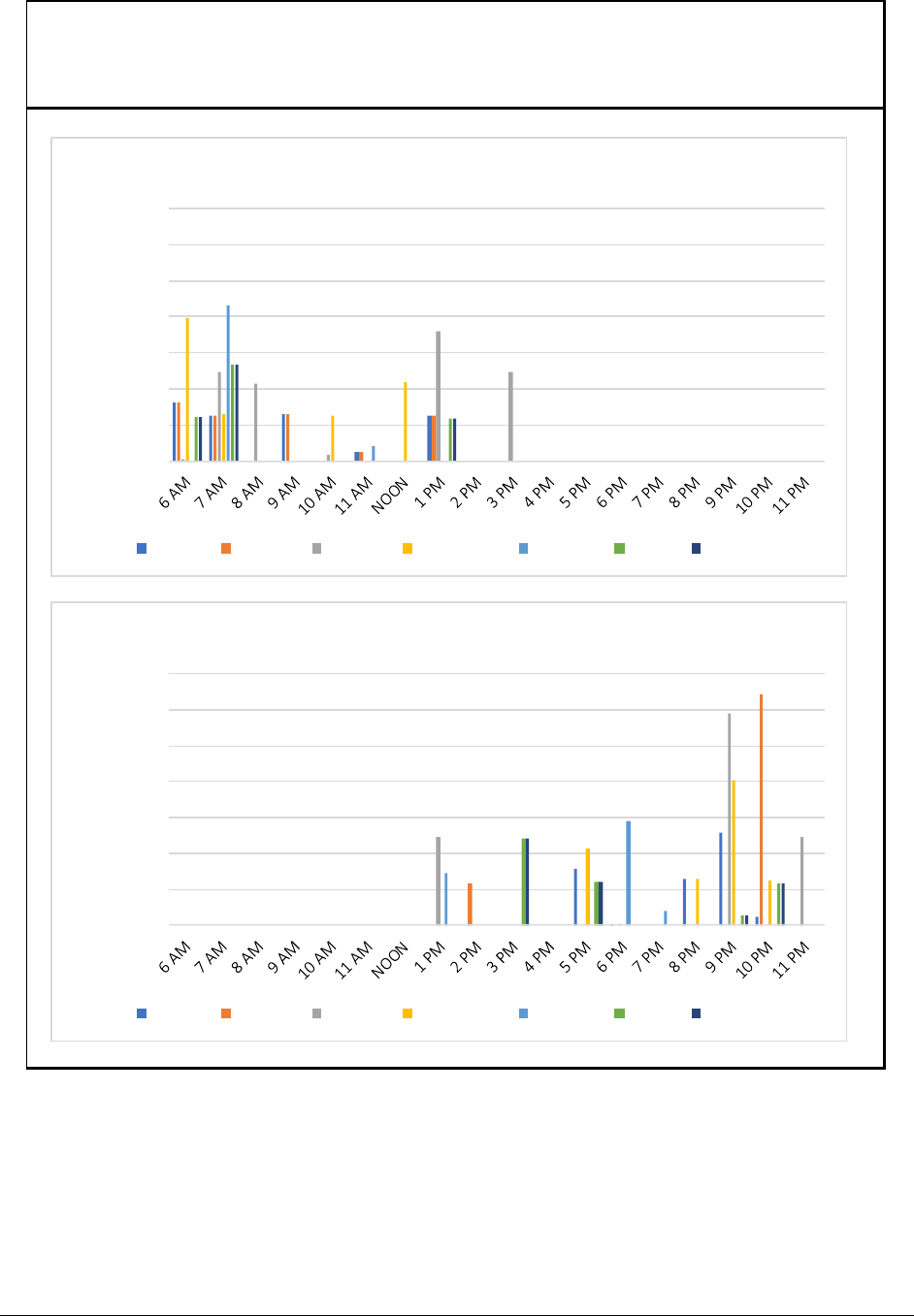
Juneau Visitor Circulator Study LSC Transportation Consultants, Inc.
City and Borough of Juneau Page 32
Figure 9: Hourly Arriving and Departing Ship Capacity by Day
and Hour
Peak Summer Week
0
2,000
4,000
6,000
8,000
10,000
12,000
14,000
Passenger Capacity
Arrivals
Sunday Monday Tuesday Wednesday Thursday Frid ay Saturd ay
0
2,000
4,000
6,000
8,000
10,000
12,000
14,000
Passenger Capacity
Departures
Sunday Monday Tuesday Wednesday Thursday Frid ay Saturd ay
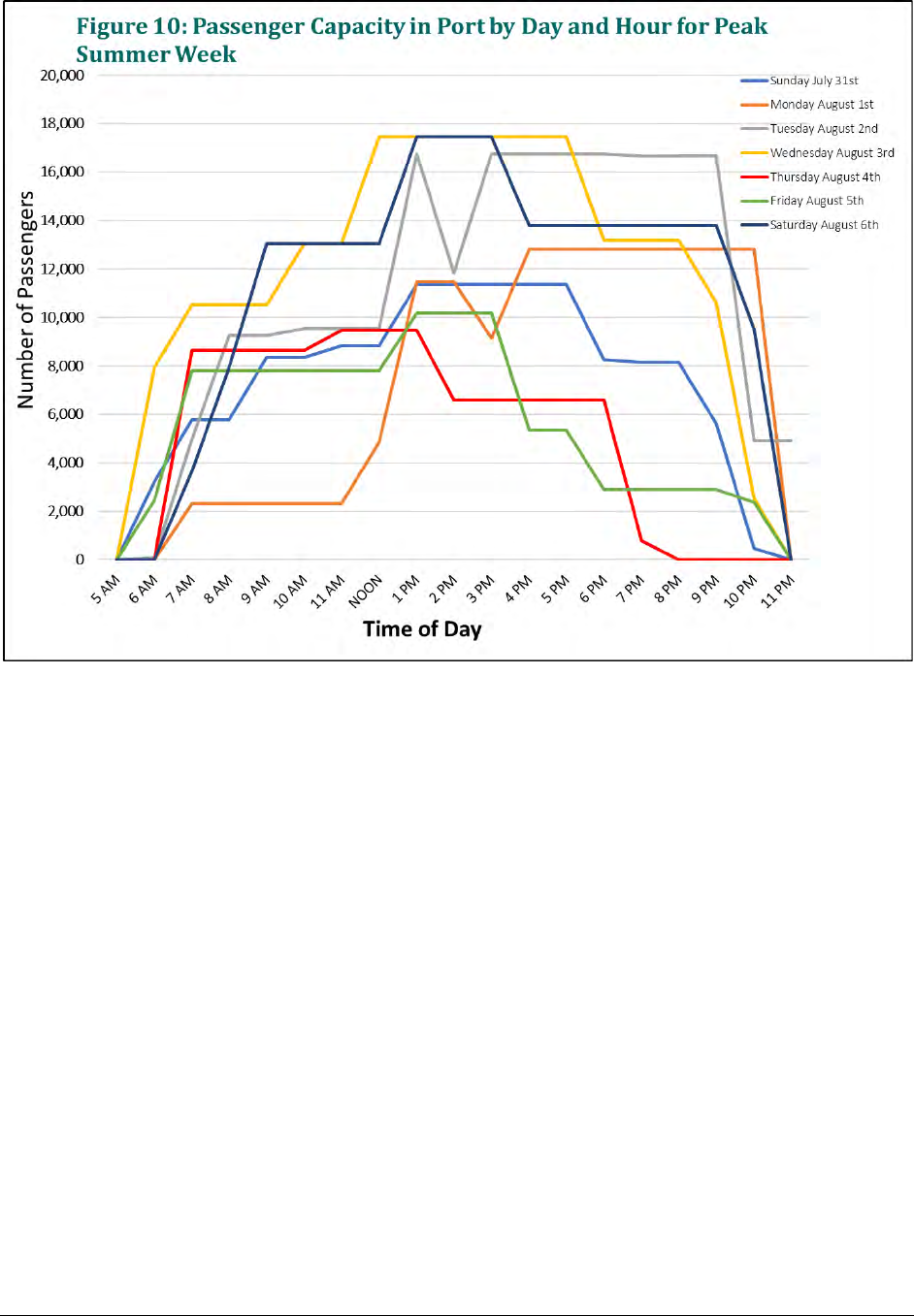
Juneau Visitor Circulator Study LSC Transportation Consultants, Inc.
City and Borough of Juneau Page 33
MENDENHALL GLACIER VISITOR ACTIVITY
Mendenhall Glacier is the prime visitor destination in the Juneau area, generating 378,000 commercial
visitors in 2021 (85 percent of the 2019 pre-pandemic figure). The majority of these visitors
(approximately two-thirds) specifically visit the Visitor Center area.
The USFS regulates private transportation services to Mendenhall Glacier Recreation Area. Per the most
recent award (in 2015) the USFS lists a total of 13 firms that provide transportation to/from the glacier (2
shuttle services, 2 taxi companies, 1 limo company and 8 other transport/tour companies). These
companies are allowed a specific capacity (totaling 157,179 visitors per year to the Visitor Center and an
additional 81,553 visitors per year to other access points).
The average length of time spent at Mendenhall Glacier ranges from 75 to 90 minutes. Visits to the
glacier are often packaged together with stops at other visitor activities, such as the fish hatchery. Per the
Mendenhall Glacier Recreation Area Market Demand and Economic Analysis report prepared by the USFS
in 2022, a round-trip to the Glacier can be had for as little as $50.

Juneau Visitor Circulator Study LSC Transportation Consultants, Inc.
City and Borough of Juneau Page 34
This page left intentionally blank.

Juneau Visitor Circulator Study LSC Transportation Consultants, Inc.
City and Borough of Juneau Page 35
Chapter 6
PUBLIC AND STAKEHOLDER OUTREACH
During late October and early November of 2022 an online community survey was launched and shared
with local businesses and members of the community. The following is a brief overview of the online
survey followed by a summary of the on-site stakeholder outreach conducted during LSC’s on-site visit
November 8
th
-10
th
, 2022.
ONLINE COMMUNITY SURVEY RESULTS
An online community survey was conducted between October 28
th
and November 18
th
, 2022. This survey
aimed to better understand the community’s perspective of the current challenges related to cruise ship
passengers and other tourism occurring in Juneau. A total of 38 people, representing 34 different
organizations completed the survey. The following is a summary of their responses.
Q1. What organization do you represent?
A total of 38 people took the survey, representing 34 different organizations throughout Juneau. A
complete list of these participating organizations can be found in Appendix A. The following is an
abbreviated list of those who participated:
• Alaska State Museum
• AWARE
• Juneau Lighthouse Tours
• Greater Juneau Chamber of
Commerce
• Red Dog Saloon
• Travel Juneau
• USDA Forest Service
Q2. On a scale of 1 (not a problem) to 5 (very serious problem), please indicate your
perception of the following issues during the peak summer tourism season:
Survey participants were given five potential issues that occur during the summer peak season. Of these
potential issues downtown parking problems was ranked as the greatest problem with 39 percent of
respondents indicating it as a 5 (very serious problem), followed by downtown traffic congestion (37
percent, ranked as a 4).
Q3: Beyond the cruise ship docks, what visitor activity centers do you think a
circulator should serve?
About 18 percent of respondents agreed that downtown Juneau and the Alaska State Museum should be
served by a circulator, followed by the airport (13 percent) and the Mendenhall Glacier (12 percent). Of
the 9 percent of participants who indicated “other”, destinations included the Ferry Terminal,
Perseverance Trail, and the State Capitol.

Juneau Visitor Circulator Study LSC Transportation Consultants, Inc.
City and Borough of Juneau Page 36
Q4: On a scale of 1 (not important at all) to 5 (very important), please identify the
importance of potential goals of a visitor circulator service.
When asked which circulation service goals were most important, survey respondents indicated that
improving the experience provided to Juneau visitors and spreading visitor activity & spending beyond
existing locations.
Q5: In general, do you support the concept of a summer visitor circulator service?
A majority of community members (76 percent) responded that they do support the concept of a
summer visitor service with only 5 percent indicating that they weren’t in support. Of the 19 percent who
said “maybe” their answers stated that it would depend on what the study finds and recommends, if it
can actually reduce congestion, if it were provided by existing transportation businesses in the area, and
what the costs will be to the community.
Q6. How do you think a Juneau Circulator could benefit you and your business?
When asked the above question, the most frequent response included something to the effect of
reducing congestion in Juneau and supporting locally-owned businesses. Other benefits highlighted the
need desire to distribute tourists to new destinations in and around Juneau, provide positive
environmental impacts, and alleviate pressure on Capital Transit during peak season. There were a
handful of individuals who did not see a benefit to adding a Circulator service to the region.
STAKEHOLDER PRESENTATION AND WORKSHOP
During an on-site stakeholder meeting on November 8th, 2022, a group of 16 community members
gathered to discuss potential types of circulator transportation services and the benefits and challenges
of each. This stakeholder group was made up of representatives of CBJ, National Forest Service, Travel
Juneau, the Downtown Business Association, existing transportation providers, cruise ship corporations,
and tour businesses.
During the stakeholder meeting, there were several existing challenges identified by our stakeholder
group ranging from the overcrowding of Capital Transit buses to auto and pedestrian congestion along
South Franklin Street. It was agreed by attendees that adding more buses of any kind to South Franklin
would not result in less congestion but rather add to the competition.
Current Transportation Challenges
The following is a short list of current challenges being faced by business owners and transportation
providers:
• Morning cruise passengers are filling up Capital Transit buses due to visitors’ ability to
research cheaper transportation to and from the Glacier. This results in overfilled buses and
the inability for Capital Transit to pick up other riders along their route.
• Driver shortages.
• Visitors are looking for a cheaper way to get to Mendenhall Glacier.
• The CBJ and local environmental groups are concerned about road congestion and increased
CO2 emissions in the downtown Juneau and Glacier areas.

Juneau Visitor Circulator Study LSC Transportation Consultants, Inc.
City and Borough of Juneau Page 37
• Lack of efficiency and safety issues near glacier area.
• Poor visitor experience when guests get lost/can’t make connections between various
destinations.
• Major sidewalk congestion between South Franklin Dock to downtown core/up the hill
(Willoughby District).
Potential Benefits
When considering the possibility of a Circulator service in Juneau, stakeholders indicated that they would
like it to provide the following benefits to Juneau and its residents and business owners:
• Decrease congestion downtown.
• Increase visitor spending while in port.
• Decrease overcrowding on Capital Transit buses due to visitors at peak times.
• Improve visitor experience in getting around Juneau.
• Move more people deeper into the core of Downtown Juneau (beyond immediate wharf
area) and thus supporting more locally-owned businesses.
• Encourage the likelihood of a second outing while in port.

Juneau Visitor Circulator Study LSC Transportation Consultants, Inc.
City and Borough of Juneau Page 38
This page left intentionally blank.

Juneau Visitor Circulator Study LSC Transportation Consultants, Inc.
City and Borough of Juneau Page 39
Chapter 7
NEEDS ASSESSMENT AND SERVICE CONCEPTS
The following provides an overview of the perceived challenges and issues currently being faced by
Juneau in relation to large populations of peak season visitors. This assessment is then followed by a brief
description of three potential transportation alternatives to be considered further moving forward.
NEEDS ASSESSMENT
Based on the data collected throughout the study process (as presented above and in Technical
Memorandum One) as well as stakeholder interviews and community surveys, the following three major
transportation challenges have been identified.
In assessing the need for expanded public circulator/transit options, a key consideration is the existing
ability for private firms to meet these needs. Put simply, there is no need to provide a public service if the
private sector is already adequately serving the need. As documents in this study, the private
transportation industry in Juneau is very robust. Therefore, this assessment of needs focuses on those
elements not currently well-served by the private firms or where current services result in issues.
Downtown Juneau Visitor Congestion
The high levels of summer cruise ship passenger activity combined with the very constrained geography
of downtown Juneau leads to a concentration of visitors in the immediate dock area, particularly along
South Franklin Street and Marine Way. This results in a variety of issues:
• Traffic congestion.
• A limited ability for visitors (particularly those with mobility limitations) to explore the
downtown area more than a block or two beyond the waterfront. This results in a
diminishment in the quality of a Juneau visit, congestion on the sidewalks and in the stores,
and a reduction in business activity in the outlying areas such as north of 3
rd
Street.
• Reduced visitation levels at facilities such as the Alaska State Museum and the Wickersham
State Historic Site.
The need for expanded visitor transit service in the downtown area would also be increased through the
expansion of port facilities (per the Huna Totem proposal) which will spread visitor activity beyond the
current concentrated area.
Visitor Impact on Capital Transit Capacity
The growth in cruise passenger activity levels has resulted in times during peak summer days when
visitors (largely traveling to and from Mendenhall Glacier) have filled Capital Transit buses leaving and
returning to downtown Juneau. This in turn can result in Juneau residents being precluded from being
able to accomplish their transit trip due to the lack of capacity on the buses. For trips such as medical
appointments or employment, this can have a substantial impact on individuals, indicating a need for
additional transit capacity.
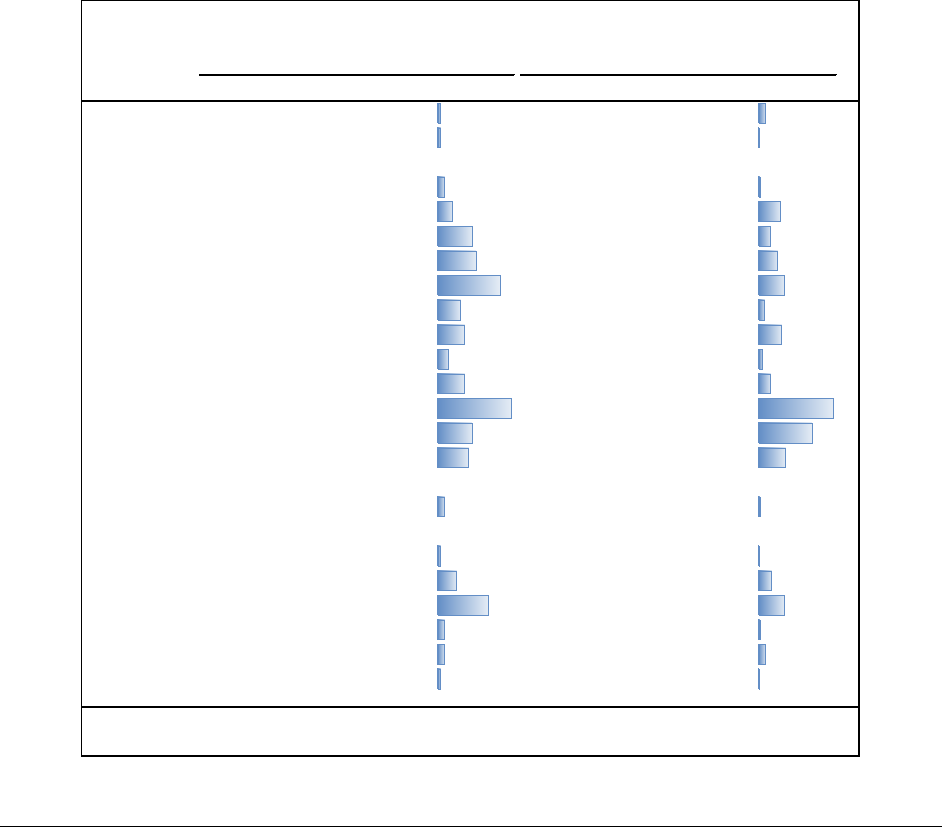
Juneau Visitor Circulator Study LSC Transportation Consultants, Inc.
City and Borough of Juneau Page 40
During the summer months of 2023, Capital Transit kept a running count of days, number of passengers,
and at which stops people were left behind by Capital Transit due to being over capacity. As shown in
Tables 12, 13, and 14, the following is true in regard to visitor impacts on Capital Transit during the busy
summery months:
• Days that experienced the greatest number of passengers being left behind were
Wednesdays (221 passengers or 41 percent) followed by Mondays (134 passengers or 25
percent).
• By time of day, the largest proportion of passengers left behind occurs in the 2:00 PM hour (a
total of 185 passengers over the survey period). As shown in Table 12, passengers are largely
left at the curb between 10:00 AM and 3:30 PM, with an additional smaller increase between
5:30 PM and 6:30 PM.
• As shown in Table 13, an analysis of high capacity (more than 10,000 cruise ship passengers)
days were compared against number of passengers being left behind at stops by Capital
Transit. While there were many high-capacity days that experienced a fair share of left
behind passengers, there were several high-capacity days that experienced very few left
behind passengers.
Rt 3 Rt 4 Rt 8 Total Rt 3 Rt 4 Rt 8 Total
8:00 0 0 1 1 0 0 12 12
8:30 0 0 1 1 0 0 2 2
9:00 0 0 0 0 0 0 0 0
9:
30 2 0 0 2 3 0 0 3
10:00 2 1 1 4 8 25 1 34
10:30 9 0 0 9 19 0 0 19
11:00 2 8 0 10 3 26 0 29
11:30 8 8 0 16 22 18 0 40
12:00 3 3 0 6 4 6 0 10
12:30 6 1 0 7 34 1 0 35
13:00 1 2 0 3 1 7 0 8
13:30 3 4 0 7 15 4 0 19
14:00 2 17 0 19 2 112 0 114
14:30 7 2 0 9 55 26 0 81
15:00 2 6 0 8 4 38 0 42
15:30 0 0 0 0 0 0 0 0
16:00 1 0 1 2 2 0 1 3
16:30 0 0 0 0 0 0 0 0
17:00 0 1 0 1 0 2 0 2
17:30 2 3 0 5 9 12 0 21
18:00 0 13 0 13 0 40 0 40
18:30 1 1 0 2 2 1 0 3
19:00 0 2 0 2 0 12 0 12
19:30 0 1 0 1 0 1 0 1
Source: LSC Transportation Consultants and ()
Note: Data date range May 8 - August 16, 2023
Number of Incidences
Total Number of Passengers
Half Hour
Starting
TABLE 12: Capital Transit Passengers Unserved by Time of Day

Juneau Visitor Circulator Study LSC Transportation Consultants, Inc.
City and Borough of Juneau Page 41
Date
# of Capital
Transit
Passengers Left at
Stop
Total Daily Cruise
Ship Capacity in
Port
Day of
Week
Ship
Capacity
Exceeds
10,000
5/8/2023 10 11,870 Monday Yes
5/12/2023 2 8,240 Friday
5/13/2023 1 9,455 Saturday
5/14/2023 31 6,182 Sunday
5/16/2023 10 15,618 Tuesday Yes
6/2/2023 12 9,250 Friday
6/5/2023 2 13,460 Monday Yes
6/7/2023 13 14,502 Wednesday Yes
6/19/2023 64 11,860 Monday Yes
6/20/2023 3 19,942 Tuesday Yes
6/27/2023 4 17,620 Tuesday Yes
6/30/2023 19 10,400 Friday Yes
7/8/2023 6 7,667 Saturday
7/10/2023 1 11,220 Monday Yes
7/11/2023 1 18,700 Tuesday Yes
7/12/2023 62 12,436 Wednesday Yes
7/13/2023 3 9,450 Thursday
7/14/2023 16 8,970 Friday
7/15/2023 4 8,206 Saturday
7/16/2023 5 9,071 Sunday
7/17/2023 5 11,160 Monday Yes
7/19/2023 65 14,502 Wednesday Yes
7/20/2023 11 10,604 Thursday Yes
7/21/2023 14 8,490 Friday
7/22/2023 1 9,507 Saturday
7/24/2023 29 11,160 Monday Yes
7/25/2023 3 14,620 Tuesday Yes
7/28/2023 8 8,040 Friday
7/29/2023 2 8,206 Saturday
7/30/2023 8 10,113 Sunday Yes
7/31/2023 23 11,160 Monday Yes
8/1/2023 1 16,860 Tuesday Yes
8/2/2023 21 13,512 Wednesday Yes
8/3/2023 2 8,392 Thursday
8/5/2023 1 7,355 Saturday
8/8/2023 4 15,618 Tuesday Yes
8/9/2023 26 13,426 Wednesday Yes
8/10/2023 7 12,500 Thursday Yes
8/15/2023 2 13,800 Tuesday Yes
8/16/2023 34 11,420 Wednesday Yes
Total 536
Source: Capital Transit Passenger Counts, Summer Months 2023
Table 13: Analysis of Passengers Unserved on Capital Transit
vs. Ship Capacity

Juneau Visitor Circulator Study LSC Transportation Consultants, Inc.
City and Borough of Juneau Page 42
For purposes of driver scheduling, it would be good to have a criteria that could be used to define in
advance when passenger overcrowding is expected to occur. To provide this, the data was analyzed to
assess the relationship between the total scheduled cruise ship capacity in port and the number of
passengers left behind. The lower this criteria, the more of the overcrowding problem is addressed but
the higher the cost of tripper service. On the other hand, if this criteria is set too high, much of the
overcrowding would not be addressed. As shown in Table 14, this analysis indicates that almost all of the
overcrowding (94 percent) was observed on days when a ship capacity of at least 7,000 beds were in
port.
Inconvenient Public Transit to Mendenhall Glacier
Capital Transit’s closest stop to the Mendenhall Glacier Visitors Center is at Dredge Lake Road /
Mendenhall Loop Road, which is a 1 ¼ mile walk (on a paved multipurpose path) to the Visitor Center.
While Capital Transit does not directly market to visitors, many visitors have discovered that the transit
program provides a much less expensive transportation option between the cruise ship docks to the
glacier than the private transportation services. Once at the glacier, however, some passengers find the
walk back to the transit stop to be too much of a challenge and ask the private firms for trips back to the
waterfront.
Based on Summer 2023 Data
Daily
Cruise
Ship
Capacity
in Port
# Passengers Left on
Days with More than
Identified Daily
Cruise Ship Capacity
in Port
Behind Passengers
Provided with Tripper
Service With
Specified Daily Cruise
Ship Capacity Criteria
# Days per Year
With More than
Identified Daily
Cruise Ship
Capacity
5,000 536 100% 40
6,000 536 100% 40
7,000 505 94% 39
8,000 498 93% 37
9,000 450 84% 30
10,000 428 80% 25
11,000 390 73% 22
12,000 224 42% 15
13,000 155 29% 13
14,000 104 19% 9
15,000 23 4% 6
16,000 9 2% 4
17,000 8 1% 3
18,000 4 1% 2
19,000 3 1% 1
Source: Capital Transit Passenger Counts, Summer Months 2023
Table 14: Analysis of Cruise Ship Capacity in Port Criteria
for Scheduling Tripper Buses

Juneau Visitor Circulator Study LSC Transportation Consultants, Inc.
City and Borough of Juneau Page 43
POTENTIAL ALTERNATIVES
The following are concepts identified as potentially addressing the needs discussed above. Each of these
concepts (except Option 5) will be analyzed and presented in the following chapters, including service
impacts and ridership potential.
Option 1: Downtown Circulator (Public Transit)
One ‘Downtown Circulator’ option would be a publicly run transit service. The service area would run as
far east as South Franklin Street, running north towards 6
th
Street and the Capital Building, before
heading down Main Street towards Egan Drive. This service could also run west towards the Museum,
Overstreet Park as well as the future site of the Huna Totem Dock. It would be a well-marketed, simple,
easy to use, and frequent service that would help in distributing locals and visitors throughout town for
increased economic development.
Option 2: Downtown Circulator (Private Transportation Providers)
Another ‘Downtown Circulator’ option worth exploring further would be a privately run transit service.
Just like Option 1, the circulator would run as far east as South Franklin Street, running north towards 6
th
Street and the Capital Building, before heading down Main Street towards Egan Drive.
Option 3: Capital Transit Tripper
A Tripper service would shadow existing Capital Transit Route 3 or 4 on peak summer season days to
provide addition service along runs that are inundated with visitor passengers. It would only run during
peak days and hours to allow additional service for local passengers. Routes being assisted by a tripper
bus would need clear signage showing that an additional bus is coming.
Option 4: Limited Capital Transit Service to Mendenhall Glacier
Limited Capital Transit service to a possible staging area approximately ¼ mile south from the Glacier Spur
Road Parking Lot could occur during the afternoons of peak season. This service would add about 5
minutes running time to the existing Route 8. By providing afternoon service only, the goal of this limited
service would be to retrieve visitors that had taken transit to Dredge Lake Road and walked to the Glacier,
without making the public transit access to the glacier so attractive that it significantly impacts the private
transportation firms and/or adds significantly to the impact that visitors are having on the Capital Transit
capacity.
Option 5: Full Circulator Service to the Mendenhall Glacier
Early in the study, it was determined that providing a convenient low-fare public transit option directly to
and from the Mendenhall Glacier would effectively out-compete the local private transportation firms
currently providing that same service. Furthermore, the anticipated demand would also be so great that it
would likely put multiple private firms out of business.
In addition, meeting such demand would require a large fleet of 15 buses or more. Even when
considering a very limited service (about 4 buses running every 15 minutes on a 1-hour loop) the service
would still be overwhelmed at peak times, with long lines and wait times to board, resulting in a poor
visitor experience.

Juneau Visitor Circulator Study LSC Transportation Consultants, Inc.
City and Borough of Juneau Page 44
Given that direct service to the Glacier would result possibly putting local private providers out of
business while providing either a very expansive service or a limited and less efficient service, a direct
circulator service to the Mendenhall Glacier was not considered further in the study.

Juneau Visitor Circulator Study LSC Transportation Consultants, Inc.
City and Borough of Juneau Page 45
Chapter 8
SERVICE ALTERNATIVES ANALYSIS
INTRODUCTION
Building upon previous chapters, this chapter details various possible options beginning with publicly and
privately operated downtown circulators, followed by the Capital Transit tripper service, and concluding
with limited service to the Mendenhall Glacier. The following options are all expected to serve the
passenger and tourist volumes experienced in Juneau during the peak summer season. For this reason,
we have used the August average daily passenger capacity from 2022 combined with the arrivals and
departures information presented earlier in the study. This information is summarized in Table 15 below
and expanded upon later in this Tech Memo. The occupancy rate of passengers versus capacity varies
from year to year; for planning purposes, we multiplied the maximum capacity for each ship by a factor of
0.90 to define the demand level of passengers.
DOWNTOWN CIRCULATOR
The general concept of a downtown circulator is to provide a short, simple, high-frequency transit service
connecting the dock areas with nearby visitor-oriented activities. The goals for this service would be to
better distribute visitors around the area to expand visitor spending, reduce pedestrian congestion in the
areas immediately around the docks, and enhance the visitor experience while in Juneau by improving
access to other cultural and historic sites. While it would focus on serving visitors, it would also help
residents and downtown workers to move around the area without adding to traffic and parking
problems. As discussed below, two route options were evaluated.
Average August Figures
Day of the Week
Passenger
Capacity
Expected Passenger
Volumes
Sunday 11,356 10,220
Monday 13,042 11,738
Tuesday 16,492 14,843
Wednesday 19,604 17,644
Thursday 7,084 6,375
Friday 8,582 7,724
Saturday 5,931 5,338
Source: Cruise Arrivals and Departures, August 2022
Table 15: Daily Cruise Capacity and Passengers by
Day of Week

Juneau Visitor Circulator Study LSC Transportation Consultants, Inc.
City and Borough of Juneau Page 46
Short Route Option
The Short Route Option is shown in Figure 11. As shown, it circulates in a counter-clockwise direction
running east along Egan Drive, north along South Franklin Street, turning left along 4
th
Street, and heading
south on Main Street towards the Downtown Transit Center (DTC). From the DTC, the service runs west
turning north along Willoughby Avenue before turning left on Whittier Street. After stopping at the Alaska
State Museum, the service turns back onto Egan Drive and begins the route again. Major stops include
the Downtown Transit Center, the Alaska State Capital, and the Alaska State Museum. Note that the route
does not extend south along Franklin Street beyond Marine Way to avoid adding to the congestion in this
area and getting excessively delayed.
As shown in Table 16, this route would require an estimated 15 minutes to operate (including passenger
loading and unloading time). Given this short time and considering the difficulties of keeping to a defined
schedule, it would not operate on a defined schedule but would rather simply operate continual loops.
On average, four round trips would be completed each hour.

Juneau Visitor Circulator Study LSC Transportation Consultants, Inc.
City and Borough of Juneau Page 47
Long Route Option
The longer Downtown Circulator is shown in Figure 12. Similar to the shorter route option, the route
circulates in a counter-clockwise direction running east along Egan Drive, north along South Franklin
Street, turning left along 4
th
Street, and heading south on Main Street towards the downtown transit
center. From the transit center, the service runs west turning north along Whittier Street to stop at the
Alaska State Museum. From there the service continues north along Whittier Street, turns left on
Willoughby Avenue stopping at the existing bus stop near Foodland Shopping Center before continuing
onto Glacier Avenue. The route then turns onto 10
th
Street, traveling onward to Overstreet Park before
returning along Egan Drive to begin the route again. Major stops include the Downtown Transit Center,
the Alaska State Capital, the Alaska State Museum, and Overstreet Park. This route requires 20 minutes
per loop to operate, including loading and unloading time. It would operate continually.
Stop
Miles From
Start
Total
Minutes
Short Route Option
Downtown Transit Center 0
Alaska State Museum 0.4 2
Egan & Willoughby (76 Egan) 0.6 5
Library/Marine Parking Garage 0.9 9
Front & Franklin 1.0 11
Seward & 4th 1.3 13
Downtown Transit Center 1.5 15
Cycles per Hour 4.0
Long Route Option
Downtown Transit Center 0
Alaska State Museum 0.3 2
9th & Glacier (Federal Building) 0.7 4
Overstreet Park 1.0 7
Egan & Willoughby (76 Egan) 1.7 10
Library/Marine Parking Garage 1.9 14
Front & Franklin 2.1 16
Seward & 4th 2.3 18
Downtown Transit Center 2.5 20
Cycles per Hour 3.0
Table 16: Example Downtown Circulator
Running Times
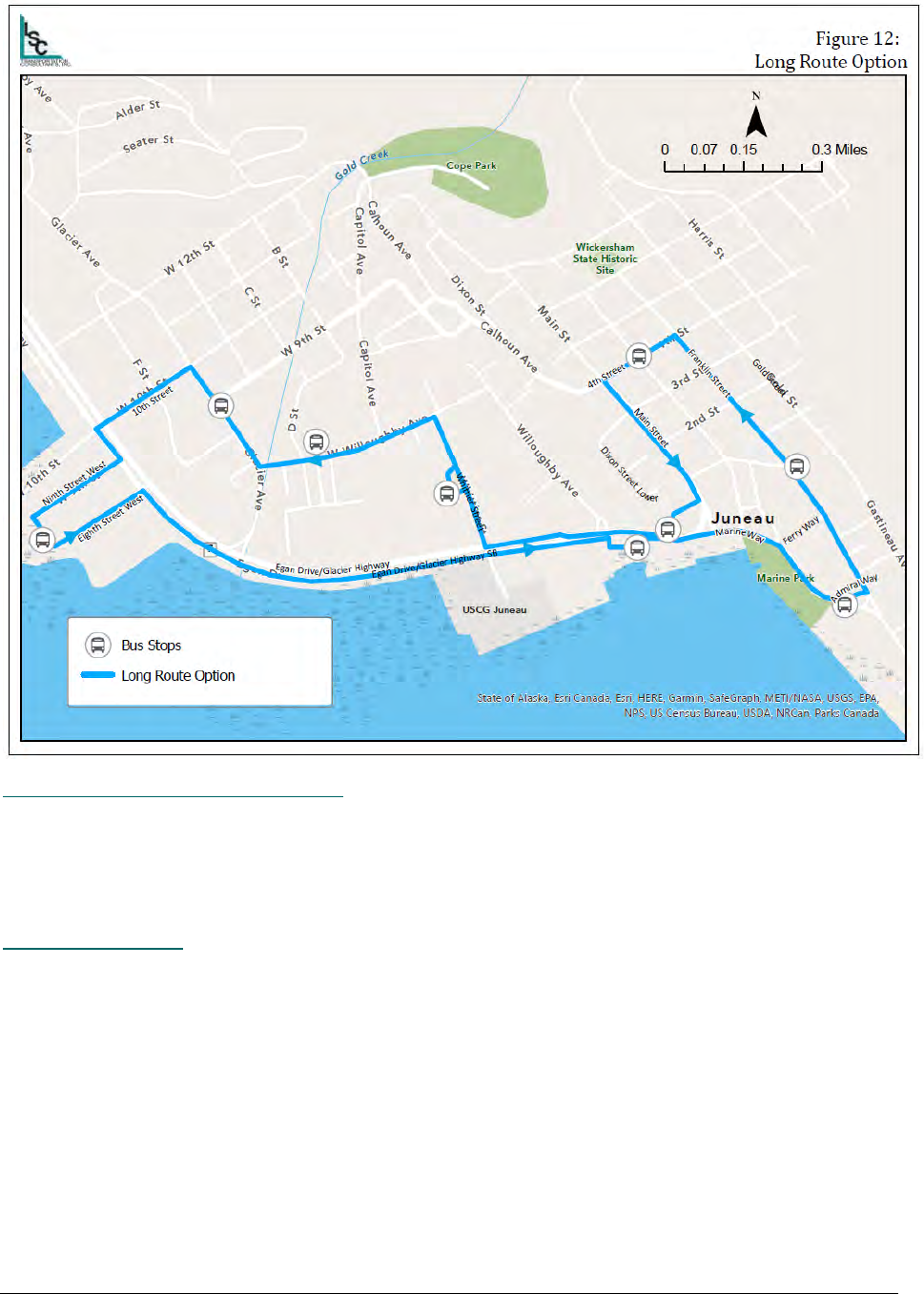
Juneau Visitor Circulator Study LSC Transportation Consultants, Inc.
City and Borough of Juneau Page 48
Other Route Options Considered
During the course of our analysis, we also considered a route that ran north of downtown along Calhoun
Avenue. This option proved to be too narrow for frequent transit service, with limited sight distance. As it
also did not serve very many additional visitor attractions, it was removed from further analysis.
Season of Service
As a basis for evaluating the length of the operating season, the total cruise ship capacity in Juneau was
plotted for the 2023 cruising season. Figure 13 shows how the daily total cruise ship capacity by day
varies dramatically from day to day, but the busy season generally extends from mid-May through mid-
September. Based on this, two scenarios were evaluated for the length of the season: a shorter season
from May 15 to September 20 (129 days) and a longer season from May 1 to October 3 (156 days).
Service would be operated seven days a week.
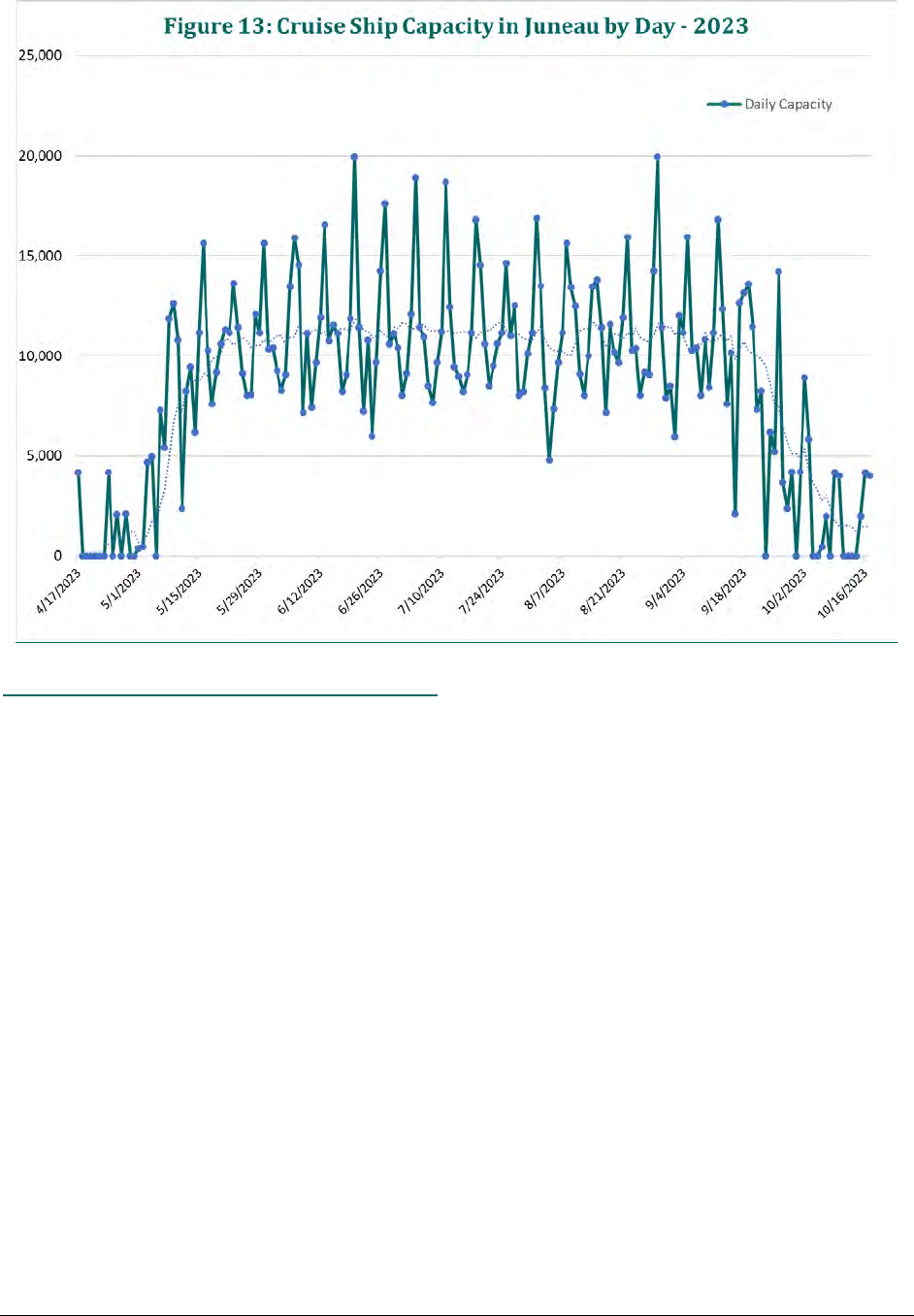
Juneau Visitor Circulator Study LSC Transportation Consultants, Inc.
City and Borough of Juneau Page 49
Projected Passenger Trips on a Busy Day
Potential daily ridership on a circulator service was estimated for a “design day” defined as the fifth
busiest day of the 2023 cruising season. This design level results in a system capacity that is adequate for
the large proportion of days, while avoiding additional costs that would only potentially be needed a few
days per year. It considered total passenger activity and assessed how various groups of passengers with
differing schedules of activities while in Juneau would use a circulator service. As shown in Table 17, the
analysis procedure consisted of the following steps:
• Figure 13 shows the anticipated cruise ship capacity for 2023 by day. The fifth highest value
was 17,600.
• A 90 percent occupancy factor was applied to identify 15,840 cruise ship passengers visiting
Juneau on the design day.
• It is reported that a small proportion of passengers choose to not leave the ship. Assuming a
five percent proportion, the number of passengers deboarding totals 15,000.
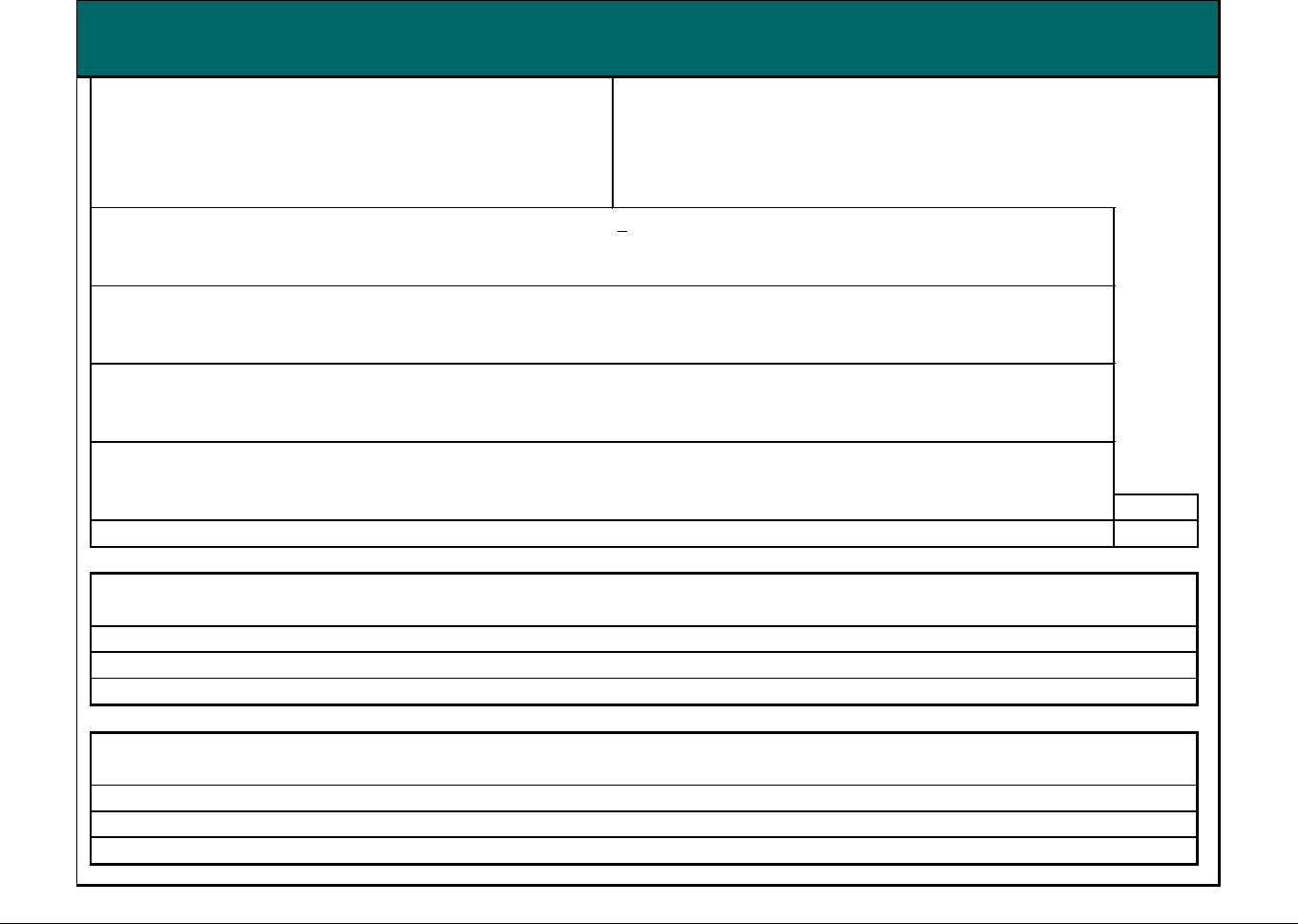
Juneau Visitor Circulator Study LSC Transportation Consultants, Inc.
City and Borough of Juneau Page 50
Table 17: Estimate of Daily Circulator Ridership on Design Day
Daily Ship Capacity - 5th Highest Day 17,600
Estimated Occupancy 90%
Daily Passengers 15,840
Percent Not Leaving the Ship 5%
Daily Ship Passengers on the Dock 15,000
Percent by Length of Stay
>
8 Hours < 8 Hours
93% 7%
14,000 1,000
Percent With Prebooked Excursion Yes No Yes No
60% 40% 75% 25%
8,400 5,600 750 250
Percent Without Prebooked Excursion Making Same Day Excursion Yes No Yes No
75% 25% 75% 25%
4,200 1,400 190 60
Percent Making an Excursion Returning to Ship 75% 75%
Percent Making a Second Excursion 25% 25%
2,100 1,400 Total
Total Potential Circulator Ridership 2,100 1,400 1,400 60 4,960
Shorter Route
Percent Choosing to Use Circulator 15% 15% 20% 20% TOTAL
Persons Using Circulator 315 210 280 10 815
One-Way Passenger-Trips per Person 1.5 1.5 1.5 1.5
Daily One-Way Circulator Passenger-Trips 470 320 420 20 1,230
Longer Route
Percent Choosing to Use Circulator 20% 20% 25% 25% TOTAL
Persons Using Circulator 420 280 350 20 1,070
One-Way Passenger-Trips per Person 1.75 1.75 1.75 1.75
Daily One-Way Circulator Passenger-Trips 740 490 610 40 1,880

Juneau Visitor Circulator Study LSC Transportation Consultants, Inc.
City and Borough of Juneau Page 51
• A passenger’s potential use of a circulator service depends on their overall length of stay in
Juneau, as those with a longer length of stay (defined as 8 hours or more) have a greater
opportunity to use the circulator as a “second excursion” over the course of their stay
(considering the time needed to deboard the boat, the required time to be back on the boat
before sailing and the typical length of time for an excursion). Total passengers were
therefore split into those with a longer stay versus a shorter stay. A review of cruise ship
arrival and departure times indicates that over the 2023 season, 93 percent of ships are in
Juneau for 8 hours or more, and 7 percent for less than 8 hours.
• For those passengers with a longer stay, it is estimated (based on discussions and
observations) that 60 percent arrive in Juneau with an excursion already pre-booked. Of the
remaining 40 percent, it is estimated that 75 percent arrange an excursion once they are on
the dock. In total, 90 percent of these passengers with longer stays take an excursion, while
10 percent choose to not take an excursion.
• Of those taking an excursion, it is estimated that 75 percent return to the ship either directly
from the excursion or after a visit to the immediate downtown shops and restaurants near
the docks, while 25 percent are interested in taking a “secondary excursion” further afield
and are thus potential circulator riders. Applying this factor to those passengers with a longer
stay taking an excursion, a total of 3,500 potential circulator riders consists of passengers
with a longer stay taking an excursion.
• The 10 percent of longer-stay passengers not taking an excursion (1,400 passengers) also are
potential circulator riders.
• For those 1,000 passengers per day with a relatively short stay in Juneau, anecdotal
information indicates that 75 percent arrive with a pre-booked excursion and an additional
75 percent of the remainder book an excursion on the dock. This yields 60 additional
passengers that are potential circulator passengers. In total, 4,960 passengers were potential
circulator passengers over the course of the design day.
• Given this level of potential ridership, a key factor is the proportion of passengers that choose
to use the circulator service. One source of guidance is provided in the Transportation
Planning Process for Transit in Federal Land Management Areas (US DOT Federal Transit
Administration, April 2008). This indicates a typical transit use rate of 20 percent among
recreational travelers. Based on discussions with local staff and tour operators as well as
LSC’s observations, this is a reasonable base figure, given a $ 5-day pass fare level. This is
applied to the longer route option for those passengers using the circulator as a secondary
excursion (with relatively short available time). For those not making another excursion (and
therefore having additional available time) a higher proportion of 25 percent is assumed. The
shorter route is expected to be less popular, in particular given the high level of awareness of
Overstreet Park. A 15 percent factor is applied for those who make another excursion and 20
percent for those who do not make another excursion.
• Applying these factors, a total of 815 people are forecast to use the shorter circulator option
over the design day, and 1,070 are forecast to use the longer circulator option.
• Some passengers will choose to use the circulator for one one-way trip, either choosing to
walk back from their destination or simply riding the service without stopping. For the shorter
option, if 50 percent choose to walk back, the number of boardings per pass purchasers per

Juneau Visitor Circulator Study LSC Transportation Consultants, Inc.
City and Borough of Juneau Page 52
day would be 1.5. Given the longer walking distance, a higher 1.75 passenger-trips per person
is used for the longer route option.
• Applying these factors, total design day ridership is estimated to be 1,230 for the shorter
route option and 1,880 for the longer route option.
Hourly Ridership and Vehicle Requirements
It is important to estimate hourly ridership to assess the required vehicle capacity and the need for
additional vehicles in operation. Table 18 provides an analysis of hourly circulator ridership by hour of day
for both the short and long routes. The pattern of ship arrivals and departures by hour was drawn from
Table 2 of Chapter 2. Adjusted for one hour to exit the boat and the need to be back onboard one hour
before sailing yields the overall passenger capacity off of the ships at any one time. This is then used to
identify the proportion of circulator riders not taking other excursions in any one hour. For those using
the circulator as a “secondary” trip (also taking another excursion), it is estimated that 90 percent take
their primary excursion first (and therefore would tend to use the circulator later in the day) and the
remaining 10 percent have a later primary excursion and thus would use the circular earlier in the day.
This yields the variation in ridership by the hour for these secondary circulator riders. The resulting
ridership by hour reaches a peak of 148 for the shorter route option and 226 for the longer route option,
both at 4:00 PM. Ridership is relatively high from 2:00 PM through 8:00 PM, and relatively low in the
morning hours and 9:00 PM.
The passenger loads are estimated by applying two factors. First, the number of cycles per hour is
considered. As shown in Table 16, above, the shorter route option has a cycle length of 15 minutes,
indicating that 4 cycles can be operated each hour, while the longer route option requires 20 minutes
thus operating 3 cycles per hour. Secondly, not all passengers will be onboard at any one point around
the route. Based on the distribution of trip generators and the variation in demand by hour, a maximum
of 80 percent of ridership is assumed to be onboard at any one point. For the shorter route option, a
maximum passenger load of 30 is estimated, indicating that a bus with a 30-passenger capacity would be
sufficient. For the more popular longer route, a peak passenger load of 60 is estimated, indicating that
two 30-passenger capacity vehicles would be needed. As shown in the bottom of Table 18, yielding a
maximum passenger load of 30 passenger-trips on the longer route requires 2 vehicles in operation
between 2 PM and 9 PM.
Operational Costs
To explore variations in service based on season length and daily hours of service, several scenarios were
evaluated. It should be noted that a majority (78 percent) of Capital Transit’s funding comes from the
General Fund. With this in mind, the following scenarios were considered in the circulator analysis:
• Considering the daily variation in ship capacity (shown in Figure 13, above), a short season
was defined (the 129 days between May 15 and September 20) as well as a long season (the
156 days from May 1 to October 3).
• Considering the hourly variation in circulator passenger demand, a short span of service (11
AM to 9 AM) and a long span of service (9 AM to 9 PM) were defined
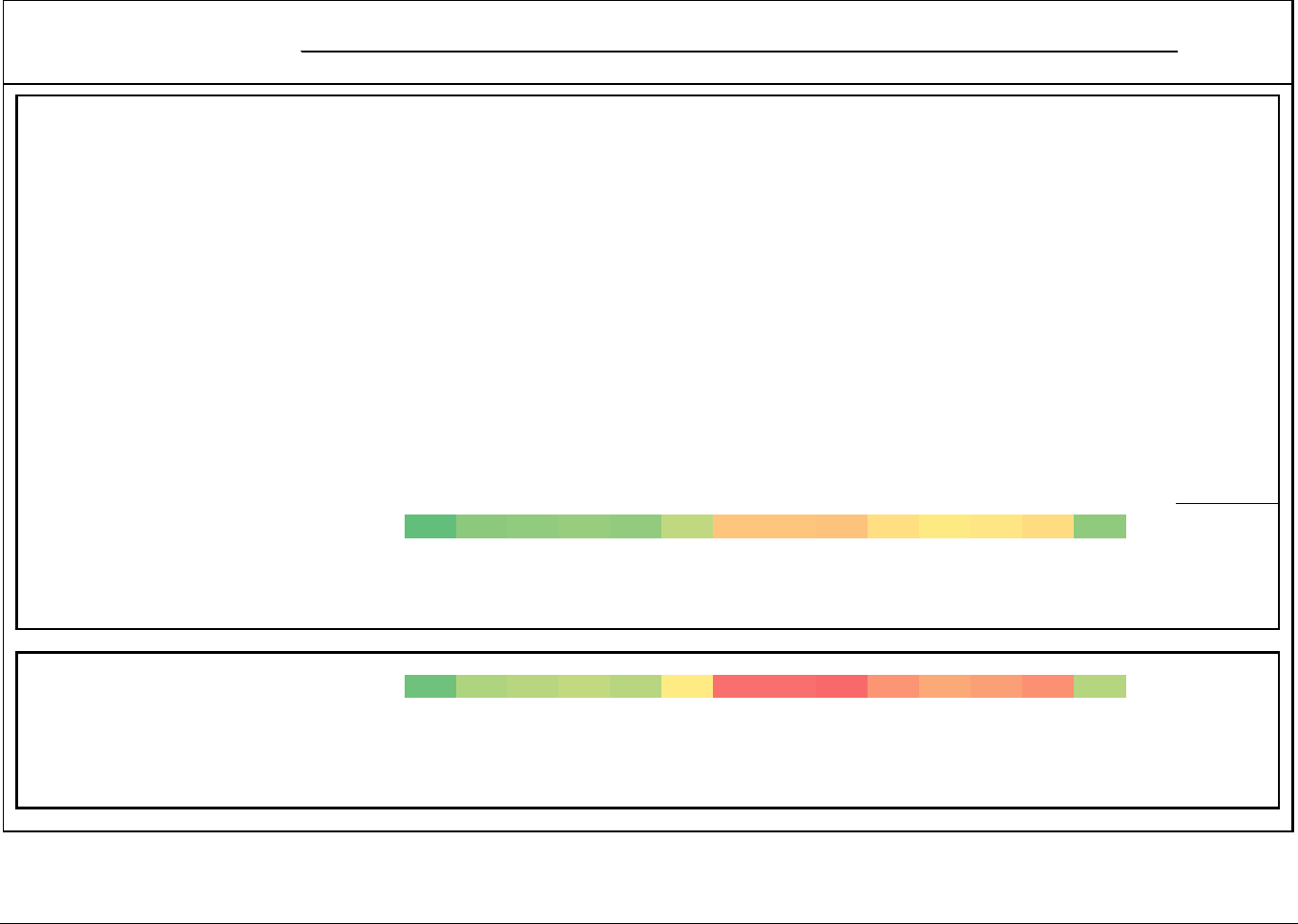
Juneau Visitor Circulator Study LSC Transportation Consultants, Inc.
City and Borough of Juneau Page 53
Table 18: Analysis of Hourly Circulator Ridership and Peak Load
Total 6 AM 7 AM 8 AM 9 AM 10 AM 11 AM NOON 1 PM 2 PM 3 PM 4 PM 5 PM 6 PM 7 PM 8 PM 9 PM 10 PM
SHORTER ROUTE
Primary Circulator Riders (Do Not Take Other Tour)
Average Capacity Arriving in Port 2,767 4,564 610 740 406 248 629 2,429 0 700 0 0 0 0 0 0 0
Average Capacity Departing Port 0 0 0 0 0 0 0 1,110 332 1,377 0 1,758 851 115 732 3,723 2,933
Capacity Arriving on the Dock 2,767 4,564 610 740 406 248 629 2,429 0 700 0 0 0 0 0
Capacity Departing Back to the Ship 1,110 332 1,377 0 1,758 851 115 732 3,723 2,933 700
Total Capacity on the Dock 0 0 2,767 7,332 7,942 8,682 7,978 7,894 7,146 9,574 7,816 7,666 7,551 6,819 3,096 163 0
% Capacity on the Dock 0% 0% 3% 8% 9% 9% 9% 9% 8% 10% 8% 8% 8% 7% 3% 0% 0%
Percent by Hour 3% 8% 9% 9% 9% 9% 8% 10% 8% 8% 8% 7% 3% 0%
Total Primary Circulator Riders 440 13 35 38 41 38 38 34 46 37 36 36 32 15 1
Secondary Circulator Riders (Do Take Other Tour)
Capacity Arriving on the Dock 2,767 4,564 610 740 406 248 629 2,429 0 700
Capacity Departing Back to the Ship 1,110 332 1,377 0 1,758 851 115 732 3,723 2,933
Total Capacity on the Dock 1,657 5,890 5,123 5,863 4,511 3,908 4,422 6,118 2,396 163
% Capacity on the Dock 4% 15% 13% 15% 11% 10% 11% 15% 6% 0%
Total Secondary Riders 790
-- Take Circulator Trip Second 711 0 0 0 0 0 29 105 91 104 80 69 78 109 43 3
-- Take Circulator Trip First 79 2 6 7 7 7 7 6 8 7 7 6 6 3 0 Short Long
Total Riders 1,230 16 41 45 49 45 74 145 145 148 123 112 117 126 43 1,126 1,212
Buses in Operation 1 1 1 1 1 1 1 1 1 1 1 1 1 1
Cycles per Hour 4 4 4 4 4 4 4 4 4 4 4 4 4 4 4
% at Peak Location 80%
Peak Load 3 8 9 10 9 15 29 29 30 25 22 23 25 9
LONGER ROUTE
Total Riders 1,880 24 63 68 75 68 113 221 221 226 188 171 179 193 66 1,721 1,852
Buses in Operation 1 1 1 1 1 1 2 2 2 2 2 2 2 1
Cycles per Hour 3 3 3 3 3 3 3 6 6 6 6 6 6 6 3
% at Peak Location 80%
Peak Load 6 17 18 20 18 30 29 29 30 25 23 24 26 18
Ridership By
Span

Juneau Visitor Circulator Study LSC Transportation Consultants, Inc.
City and Borough of Juneau Page 54
Table 19 summarizes costs by both the Short and Long Route Options and for the various combinations of
season and span options. The total season hours and miles were calculated. It was determined that the
second bus required at peak times under the longer route option is only needed on days with a cruise
ship capacity of 9,000 or more (99 days over the shorter season and 104 days over the longer season).
Using the cost factors discussed in Technical Memorandum One, the consideration of fully allocated costs
is recommended for the implementation of a circulator route to move forward.
Fully allocated costs include the marginal costs (the direct costs associated with service such as driver
salaries and fuel) and also include a “fair share” of the many fixed costs (which do not vary depending on
service levels) needed to operate a transit service, such as administrative salaries/benefits, dispatcher
salaries/benefits, facility costs, accounting/legal staff, etcetera).
Given that the majority of Capital Transit funding comes from local General Funds, including allocated
overhead costs is important to avoid the need for General Funds to support any new visitor-related
service. These costs are allocated based on an additional cost per vehicle-hour of service of $68.51. Fully
allocated costs range from a low of $229,200 per year up to $471,900 per year.
Fare Analysis
To assess seasonal fare revenue, it is first necessary to estimate total seasonal ridership, in terms of both
total boardings and total individuals purchasing passes. As shown in Table 20, the daily ship capacity data
were evaluated to identify a factor of 0.63 reflecting the average capacity over the 5
th
highest (design
day) capacity. This is applied to the design day ridership (during the assumed span of service) and
multiplied by the days per season to yield the total seasonal ridership (1-way passenger-trips).
This is estimated to range from 91,100 for the most limited option up to 181,200 for the most extensive
option. These figures can then be divided by the average boardings per individual to yield the total annual
individual ridership, which ranges from 60,700 to 120,800. With the allocated total operating costs of the
service in consideration, it is recommended that this circulator service be offered to passengers for a daily
pass cost of $5.00 (with free boarding for children aged 5 and younger). This would allow free reboarding
Table 19: Downtown Circulator Operating Costs
Assuming Capital Transit Unit Costs
Season Option
Route Length Option
Daily Span Option
11AM-9PM 9AM-9PM 11AM-9PM 9AM-9PM 11AM-9PM 9AM-9PM 11AM-9PM 9AM-9PM
Bus 1 Hours per Day 10 12 10 12 10 12 10 12
Bus 1 Days per Year 129 129 129 129 156 156 156 156
Bus 2 Hours per Day 0 0 7 7 0 0 7 7
Bus 2 Days per Year 0 0 99 99 0 0 104 104
Bus 1 Daily Vehicle-Miles 59 71 75 90 59 71 75 90
Bus 2 Daily Vehicle-Miles -- -- 53 53 -- -- 53 53
Annual Vehicle-Hours 1,290 1,548 1,983 2,241 1,560 1,872 2,288 2,600
Annual Vehicle-Miles 7,637 9,164 14,873 16,808 9,235 11,082 17,160 19,500
Fully Allocated Operating Costs $229,200 $274,900 $359,800 $406,700 $277,100 $332,500 $415,200 $471,900
Allocated Overhead Cost per Hour $68.51
Note: Fixed costs allocated by vehicle-hours.
Shorter Route Option
Longer Route Option
Shorter Route Option
Longer Route Option
Long: May 1 to October 3
Short: May 15 to Sept 20

Juneau Visitor Circulator Study LSC Transportation Consultants, Inc.
City and Borough of Juneau Page 55
over the course of a day
3
. At a pass cost of $5 per individual, total fare revenue ranges from $303,500 up
to $604,000.
Operating Cost/Fare Revenue Balance
Unusual for public transit services, the passenger fare revenues shown in Table 20 exceed the operating
cost estimates shown in Table 19, yielding a net positive operating balance as shown at the bottom of
Table 20. If allocated fixed costs are included, this positive balance on a fully allocated basis ranges from
$74,300 up to $132,100. Note that the operating costs do not include marketing or capital costs, as
discussed below.
Institutional Implementation Options
There are two institutional options to be considered in the implementation of this service. These options
are discussed in detail below.
Direct Capital Transit Operation
The discussion above assumes that Capital Transit (CBJ) staff directly provides a circulator service, at
existing Capital Transit costs. Directly operating service is one option, with both advantages and
disadvantages:
Advantages
• Allows the service to be more easily monitored and modified.
• Can ensure a higher quality of service.
3
One option would be to also offer a season pass for a significant discount, such as $20 per season. This would allow
Juneau residents (particularly those living in the downtown area) to use the circulator at a nominal price per trip
while still generating the same fare revenue by cruise passengers.
Table 20: Downtown Circulator Fare Revenue Analysis
Season Option
Route Length Option
Daily Span Option
11AM-9PM 9AM-9PM
11AM-
9PM
9AM-9PM
11AM-
9PM
9AM-9PM
11AM-
9PM
9AM-9PM
Design Day Ridership 1,126 1,212 1,721 1,852 1,126 1,212 1,721 1,852
Average Cruise Visitors in Service Season 11,039 11,039 11,039 11,039 10,123 10,123 10,123 10,123
Design Day Cruise Visitors 17,600 17,600 17,600 17,600 17,600 17,600 17,600 17,600
Ratio of Avg/5th Highest 0.63 0.63 0.63 0.63 0.63 0.63 0.63 0.63
Average Daily Ridership Over Service Season 706 760 1,079 1,162 706 760 1,079 1,162
Number of Days in Season 129 129 129 129 156 156 156 156
91,100 98,000 139,200 149,800 110,200 118,500 168,400 181,200
Total Annual Individual Riders 60,700 65,300 92,800 99,900 73,500 79,000 112,300 120,800
Base Fare - Day Pass 5.00$
$303,500 $326,500 $464,000 $499,500 $367,500 $395,000 $561,500 $604,000
Assuming Fully Allocated Costs
Fully Allocated Operating Costs $229,200 $274,900 $359,800 $406,700 $277,100 $332,500 $415,200 $471,900
Total Operating Net Balance $74,300 $51,600 $104,200 $92,800 $90,400 $62,500 $146,300 $132,100
Fare Revenue
Short: May 15 to Sept 20
Long: May 1 to October 3
Shorter Route Option
Longer Route Option
Shorter Route Option
Longer Route Option
Total Annual Ridership (1-Way Psgr-Trips)

Juneau Visitor Circulator Study LSC Transportation Consultants, Inc.
City and Borough of Juneau Page 56
Disadvantages
• CBJ may have more difficulty staffing a seasonal service, given personnel rules and limited
driver pool.
• Capital Transit does not have the physical capacity at the operations center to house
additional vehicles.
Contracted Operation
Another option, particularly for a new seasonal program, would be to contract for service. CBJ would
develop and release a Request For Proposal (RFP) that would be the basis of a competitive bidding
process. This RFP would need to include the following:
• A clear description of the scope of services (hours, number of vehicles, etc.).
• Minimum specifications for vehicles (including a backup vehicle).
• Performance measures, including service quality, minimum driver requirements (drug and
alcohol testing, ADA training, driver licensing, and experience).
• Reporting requirements.
• Insurance requirements.
• Requirements to brand the vehicle.
• Requirements regarding fare handling.
• Payment basis (typically a fixed cost per month plus an additional cost per vehicle-hour of
service)
• A clear description of the selection process
Through this RFP process, an operator would be selected. CBJ staff would still be responsible for
reviewing reports, contract conformity and payment, marketing, ticketing, and addressing any public or
passenger complaints. Fares would be the property of CBJ (rather than the operator).
Advantages
• A contractor may be able to staff the program more expeditiously.
• Allows the service to be modified or terminated without impacting CBJ staff.
• May result in a lower cost.
• Significantly, vehicles can be stored and maintained without impacting the capacity of the
Capital Transit operations center.
Disadvantages
• Addressing operational complaints can be more complicated by the contractual relationship.
• Vehicle quality may be more uncertain.
• Requires an RFP process and ongoing CBJ administration.
Transit programs often use contracting for the initial years of a new demonstration program, transitioning
to in-house service once the service plan and staffing requirements have been clearly defined through
experience. One strategy is to undertake an RFP process and have the public transit entity effectively
submit a bid. This can provide detailed information on which to base the decision to contract, and if so,

Juneau Visitor Circulator Study LSC Transportation Consultants, Inc.
City and Borough of Juneau Page 57
which is the appropriate contractor. Note that under this option the CBJ would still incur costs for the
administrative and monitoring process, which are not included in the operating costs presented above.
Vehicle Requirements and Costs
As presented in Table 18 (above), one vehicle would be operated on the shorter route alternative, and
two vehicles on the longer route alternative. A backup vehicle would also be needed to cover the time
during which vehicles are out of service for repairs. Optimally, all vehicles would be branded with a
unique wrap (as part of the marketing strategy).
Considering the expected passenger loads and the constrained streets in the downtown area, the optimal
vehicle would be 30 feet to 35 feet in length, accommodating approximately 30 seated passengers. It
would need to be wheelchair accessible. While a trolley replica bus would be viable, it is not a necessity.
Vehicle costs vary widely depending on the manufacturer and propulsion. A medium diesel bus currently
runs on the order of $800,000, while battery electric buses are approximately $200,000 to $250,000
more at around $1 million a vehicle.
If circulator service is contracted, vehicles could be provided through the contractor. If the service is
provided by Capital Transit, additional vehicles would be needed. This could be through a lease in the
short term until funds can be assembled for purchase. In either scenario, the vehicles would need to be
stored off-site from Capital Transit’s maintenance yard.
Fuel Type
The vehicles would optimally use zero-emission Battery Electric Bus (BEB) technology, for both the air
emission benefits as well as the reduced noise impact on downtown streets. The daily vehicle mileage
shown in Table 19 is well within the daily operational range of BEB vehicles (even considering the
additional energy requirements of climbing up to 4
th
Street) without the need for route charging or
switching out vehicles mid-day. In the short term (over the next two to three years), however, BEB
propulsion is not a viable option given the time required for grant application and installation of charging
equipment as well as the lack of the necessary space at the Capital Transit operations center for the
vehicles and equipment.
Moreover, the first few years of operation will likely lead to adjustments in the operating plan that could
change the vehicle needs of the service. It is recommended that CBJ initially implement this service using
diesel buses (preferably with more recent and lower emission engines) and also start pursuing grants
(such as the Federal Transit Administration 5339(c) Low or No Emission Grant Program) for purchase of
two to three BEB vehicles as well as charging equipment.
Circulator Stops and Recommended Improvements
Stop improvements would depend on the route length option chosen. Except for one stop (Egan &
Willoughby), all stops are already in place. These bus stop improvements are further discussed below.
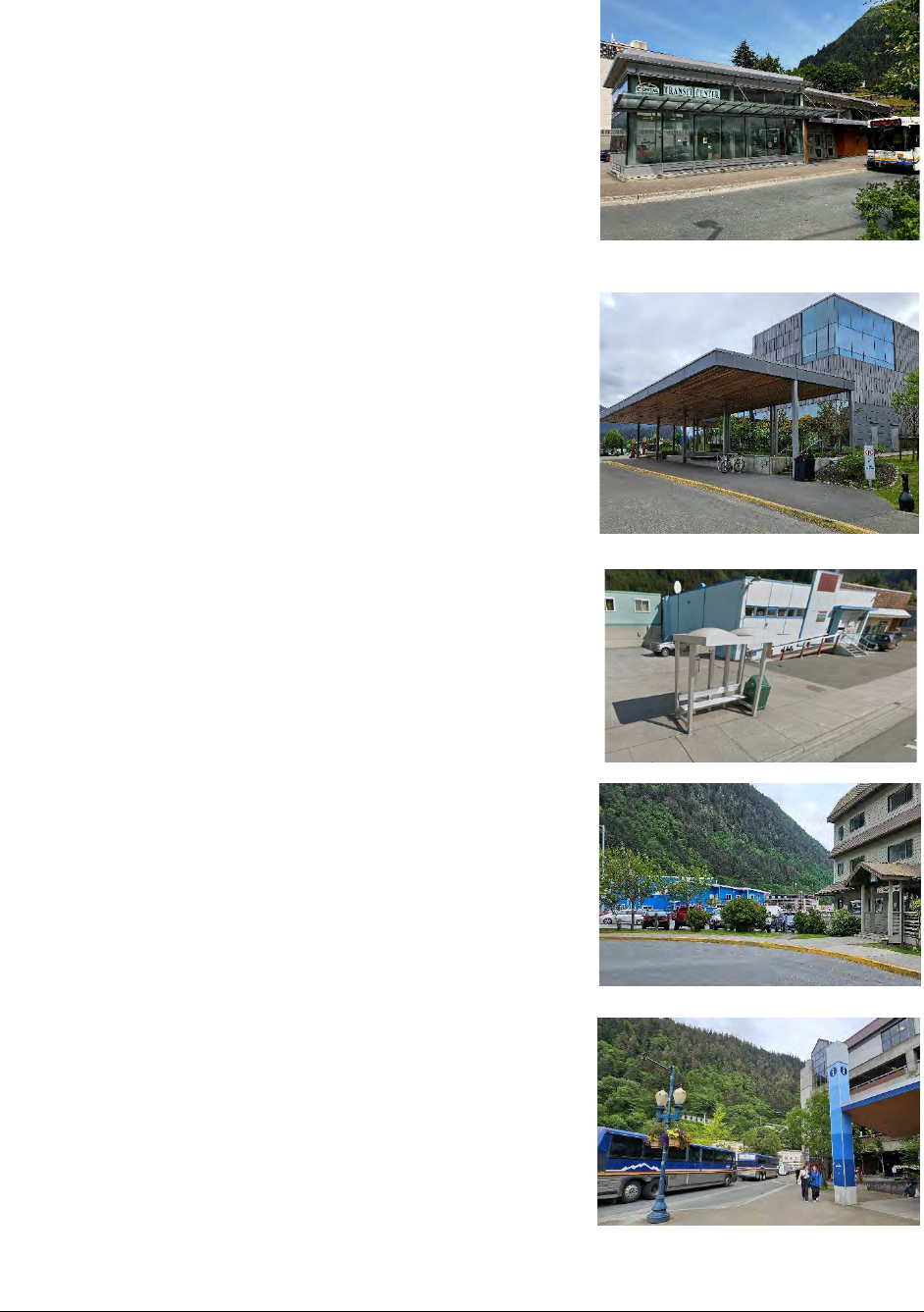
Juneau Visitor Circulator Study LSC Transportation Consultants, Inc.
City and Borough of Juneau Page 58
Shorter Route Option Stops
The Downtown Transit Center is already an established transit
stop at the heart of Downtown Juneau. To create a stronger
presence of the circulator service, clear signage would be posted
to indicate it as a part of the service.
The Alaska State Museum stop already includes a larger overhang
and seating area. It would only require signage indicating its
inclusion in the service.
The stop located at the Foodland Shopping Center on Willoughby is
already an established bus stop with a shelter and bench. We
would recommend this stop have additional signage related to the
Circulator service specifically.
The stop located at Egan & Willoughby (76 Egan) would require
signage as well as a shelter and pad as it is not currently a bus
stop. There is an area near the east end of the current driveway
(as shown) that could accommodate a shelter. This would require
an agreement with the current owners.
The Library/Marine Parking Garage is an established Capital
Transit stop. It includes shelter and benches. To create an obvious
stop along the circulator this location would also require signage.

Juneau Visitor Circulator Study LSC Transportation Consultants, Inc.
City and Borough of Juneau Page 59
The stop at Front Street & Franklin Avenue would require both
signage and benches. It will also need enforcement of a bus-only no
parking zone.
Similar to the Front and Franklin the stop at Seward Street & 4
th
would require both signage and benches.
Additional Stops on Longer Route Option
The 9th & Glacier (Federal Building) stops already have an
impressive shelter with benches. The only improvement needed is
signage.
As Overstreet Park is also an existing stop with a good shelter and
benches, the only improvements needed are signage.
The costs of these improvements would total to be between $64,000 to $73,000 depending on whether
the short or long route is implemented, as shown in Table 21. A total capital cost table for each route that
includes vehicle costs as well are presented in Table 22. As shown, costs for the shorter route would be
approximately $2.1 million while the longer route would cost closer to $3.2 million. This is merely an
estimate based on current costs of construction and material as well as the desire to purchase battery
electric vehicles over diesel.
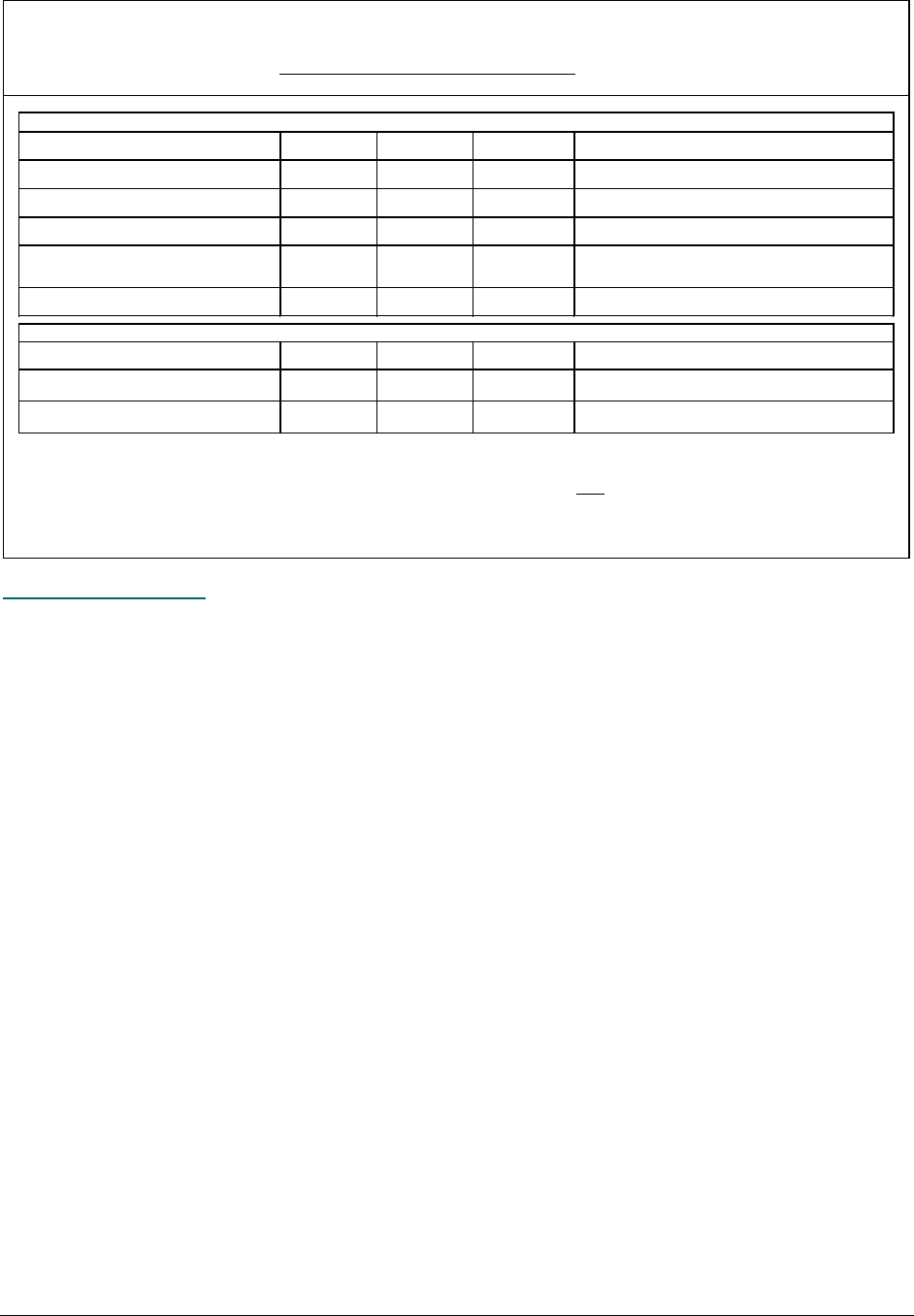
Juneau Visitor Circulator Study LSC Transportation Consultants, Inc.
City and Borough of Juneau Page 60
Traffic Assessment
Traffic operations associated with the circulator route can be considered in two ways: the traffic
operational ability for the buses to operate, and the impact on overall traffic operations. Regarding the
first consideration, the two circulator route options were designed to avoid difficult traffic movements. As
discussed above, options that use any of the narrow streets with sharp intersection angles in the upper
portions of downtown (such as Calhoun Avenue) were dismissed as infeasible. Left turn movements onto
particularly busy streets (such as Egan Drive, with 11,000 vehicles per day) would only be made at
signalized locations: at Whittier Street on the shorter option and West 10
th
Street on the longer option.
The necessity of using a signalized intersection for left turns onto Egan Drive is one reason that the
western portion of the longer route option operates in the counterclockwise direction, as there is no
ability to use a signal to egress the Overstreet Park area. Given these considerations and the fact that
existing Capital Transit buses operate adequately around the Marine Way / Franklin Street / 4
th
Street /
Seward Street loop, it is concluded that traffic conditions will not unduly delay bus operations.
Regarding the impact of bus operations on general traffic conditions, the service would only add up to 4
vehicles per hour, which would constitute a small proportional increase. As an example, Marine Way
carries approximately 3,400 vehicles per day per AKDOT data, which indicates approximately 340 vehicles
in the peak hour. 4 additional buses per hour is equal to just over a 1 percent increase in total traffic
activity in the peak hour. Another consideration is whether buses stopping in traffic lanes at bus stops
would unduly impede traffic.
Table 21: Circulator Bus Stop Improvement Costs
Stop Signage Benches Shelter & Pad Notes
Shorter Route Option
Downtown Transit Center R * *
Alaska State Museum R * *
Egan & Willoughby (76 Egan) R * R
Library/Marine Parking Garage R * *
Front & Franklin R R *
Increased enforcement of No Parking in Bus Bay needed.
Benches will require minor grading and paving. ($5,000)
Seward & 4th R R * Benches on existing Sidewalk. ($1,000)
Longer Route Option (Additional Stops)
Willoughby and D St.(Foodland Shopping Center
R * *
Already an existing bus stop with shelter and bench
9th & Glacier (Federal Building) R * *
Overstreet Park R * *
Total Units - Short Route 6 2 1
Total Units - Long Route 9 2 1
Unit Cost $3,000 See Notes $40,000 Total
Total Cost - Short Route $18,000 $6,000 $40,000 $64,000
Total Cost - Long Route $27,000 $6,000 $40,000 $73,000
Recommended Improvements

Juneau Visitor Circulator Study LSC Transportation Consultants, Inc.
City and Borough of Juneau Page 61
All of the bus stops would allow the bus to pull out of the traffic lane (assuming adequate enforcement of
no parking regulations), except for the 4
th
Street stop. 4
th
Street in this location carries 1,200 vehicles per
day. With 10 percent in the peak hour and over the two directions, this is equal to an average of 60
vehicles per hour per direction or 1 vehicle per minute per direction in the peak hour. While individual
drivers or two will be delayed during bus boarding on 4
th
Street, this would overall only be a minor
inconvenience. In sum, either circulator option could be operated without any substantial traffic impacts.
Benefits to Visitors and Residents
As identified early on in the study, there were challenges associated with the congestion of tourists
located along South Franklin Street and Marine Way. Business owners indicated that they would prefer
visitors to have the opportunity to make their way further north into the downtown area of Juneau. The
circulator as proposed here aims to distribute visitors further north than the immediate South Franklin
Street area while also allowing an opportunity to visit the Capital Building, State Museum, and Overstreet
Park.
The key benefit to residents is primarily seen in its impacts to more locally-owned businesses in the
downtown Juneau area, however, residents would also be able to ride this circulator for a reduced fair. As
an added benefit, this service could also be operated on an as-needed basis for residents for events such
as the Juneau Folk Festival, Gold Medal Basketball Tournament, and the Sealaska Heritage Celebration
events.
Unit Unit Cost Total
Shorter Route
Signage 6 $3,000 $18,000
Benches 2 See Table 7 $6,000
Shelter & Pad 1 $40,000 $40,000
Buses 2 $1,050,000 $2,100,000
$2,164,000
Longer Route
Signage 9 $3,000 $27,000
Benches 2 See Table 7 $6,000
Shelter & Pad 1 $40,000 $40,000
Buses 3 $1,050,000 $3,150,000
$3,223,000
Item
Total
Total
Table 22: Circulator Service - Capital Costs

Juneau Visitor Circulator Study LSC Transportation Consultants, Inc.
City and Borough of Juneau Page 62
Marketing Campaign and Costs
Both short and long-route Downtown Circulator options would require a strong marketing effort. A
marketing campaign could be organized internally or outsourced to a marketing agency through an RFP. A
successful marketing campaign would focus on target audiences, through several strategies as described
in additional detail below.
Goals and Objectives
The major goals and objectives that should be accomplished through a Downtown Circulator marketing
campaign should include:
• Raising Awareness/Education: Creating awareness and improving local knowledge of the
Downtown Circulator.
• Increasing On-Shore Activities: Cultivating a diverse selection of on-shore activities for cruise
ship passengers.
• Increasing Tourist Presence throughout Downtown: Encouraging visitors to venture deeper
into Downtown and further north than the immediate Franklin and Egan Street corridor.
• Building Relationships with the Downtown Business Association: Coordinating collaborative
partnerships amongst business owners in the downtown area.
Overview of Marketing Strategies
The marketing campaign could feature the following strategies:
• Target Audiences: Marketing materials, radio ads, and/or TV commercials should target the
audience and general messaging for such marketing materials and commercials.
• Brand Identity: The service would want to stand alone and be fully branded with a distinct
name, logo, and color scheme. It may require its own website or at least a distinct page
within an existing website.
• Community Gatekeepers: Building on the list of stakeholders and community members
identified during this study, a list of key gatekeepers should be identified, as well as
appropriate means and timing for contacting them about the circulator service. These
gatekeepers include downtown business owners and employees, cruise ship liaisons,
government agencies, and other major tourism community leaders. Their role would be to
distribute marketing materials to raise awareness about the service within the community as
well as amongst tourists.
• Marketing Materials: Several mediums of marketing materials should be developed for
outreach. The following materials could be provided in English as well as other languages for
distribution through the near community and cruise ship coordinators.
o Press releases to the local Chamber of Commerce and City and Borough of Juneau.
o Printed flyers, visitor guides, etcetera
o News Media Print and Web Ads.
o Social media platforms and posts such as Facebook, Instagram, and Twitter.

Juneau Visitor Circulator Study LSC Transportation Consultants, Inc.
City and Borough of Juneau Page 63
• Website Updates: All related websites should be updated with clear information regarding
the new service. This could include Travel Juneau, Capital Transit, Juneau.org, etc.
• Suggestions for Promotional Events: A few pop-up promotional events could introduce the
service to potential passengers.
CAPITAL TRANSIT TRIPPER SERVICE
One impact of the growth in cruise ship activity is the sporadic overloading of Capital Transit buses by
cruise ship passengers, largely as they travel to and from Mendenhall Glacier. This is increasingly resulting
in local resident passengers being left at the curb as buses reach their passenger capacity. During the
summer of 2023, Capital Transit staff is collecting data that includes when buses reached capacity and at
which bus stops they were unable to serve local passengers as a result. It should be noted that at the time
of this data collection, permits held by private tour companies to visit the Glacier had run out, causing
more tourists to seek alternative ways to visit Mendenhall. Below provides a summary of the data
collected thus far for the period between May 8
th
and July 20
th
:
• A total of 384 passengers have been left behind at bus stops so far during the summer season
of 2023, 7 of which were passengers using a wheelchair.
• Passengers were left behind on a total of 20 days (27 percent of all days), consisting of 5 days
in May, 7 days in July, and 15 days (out of 20) in July.
• These overcrowded runs are occurring on Routes 3 and 4, except for 3 instances on Route 8
Express.
• 44 percent of passengers, or 168 passengers, of those being left at stops due to over-capacity
occurred on Wednesdays. This was followed by 21 percent (82 passengers) being left behind
on a Monday. It should be noted that Wednesday is also the busiest average day for cruise
ship activity.
• 51 percent of passengers (or 194 passengers) being left at bus stops due to over-capacity
occurred between noon and 4 PM. This was followed by 35 percent (133 passengers) of these
observed cases occurring between 8 AM and noon.
• In no particular order, the most common locations where passengers are being left on the
curb are at SEARHC, Western Auto, Downtown Transit Center, the Federal Building, and Floyd
Dryden Middle School. Between 20 and 29 passengers have been left behind at all of these
locations.
Given the sporadic pattern of capacity problems, it is not effective to address this issue by increasing the
scheduled frequency of service. Rather, transit systems facing this type of issue typically operate “tripper
service,” consisting of additional buses dispatched as needed. These additional bus runs are not shown on
the schedule.
Under this alternative, Capital Transit would schedule drivers to be available on standby (either in the
downtown area or at the operations center, depending on specific times of day and use patterns) for
specific days and times along Routes 3 and 4. The drivers would be dispatched as route drivers report
overcrowding is occurring. Buses being assisted by a tripper bus would need clear signage showing that
an additional bus is coming.

Juneau Visitor Circulator Study LSC Transportation Consultants, Inc.
City and Borough of Juneau Page 64
Operational Costs
While additional data will need to be gathered during the peak summer of 2023 to better define when
overcrowding is occurring and how it relates to total cruise ship capacity in port, it is useful to review
potential costs associated with running the Tripper Service. As shown in Table 23, estimates were
calculated for 4 to 8 hours per day and for 30 to 90 days per season, assuming that half of the runs during
the standby tripper periods would be operated (generating vehicle-miles). The total allocated operating
cost ranges from $23,800 to $143,000 depending on the days of operation per season and the hours per
day the service is being provided.
Fare Revenue
The additional ridership served by the tripper runs can be calculated using data regarding the observed
passengers left behind (Table 12) and the daily cruise capacity in port. With this in mind, an estimated
additional 700 passenger-trips would be served each season, which would generate an increase in fare
revenue of $1,200. These figures could vary significantly depending on cruise activity and changes in
private shuttle access to the glacier.
Benefits to Visitors and Residents
The tripper bus alternative as described above is meant to directly benefit local residents who currently
use Capital Transit services. Over the course of this study, it was mentioned several times that drivers
were having to leave local resident passengers behind due to overcrowding along existing fixed route
services. As discussed in Chapter 7, an informal version of this service was deployed during the summer
of 2023 when Capital Transit observed higher over-capacity rates than usual.
EXPANDED CAPITAL TRANSIT SERVICE TO MENDENHALL GLACIER
The current Capital Transit services provide a low level of public access to Mendenhall Glacier. The closest
stop (Mendenhall Valley Road/Dredge Lake Road is served by three routes (3, 4, and 8) that together
serve the stop up to 35 times per day. Travel time to and from downtown is approximately 45 minutes
and a fare of $2 ($1 for youth) is required per one-way trip. This fare is only 10 percent of the costs of a
private sector tour. While frequent, relatively inexpensive, and reasonably quick, accessing the glacier
through public transit currently requires a 1.5-mile walk in each direction along a multipurpose paved
trail. As a result (in large part from the overall need to walk 3 miles round trip), cruise passenger use of
public transit is currently moderate. Even so, it can result in overcrowding on the buses as discussed
above.
Table 23: Example Tripper Bus Costs
Days per Year
Hours per Day 4 6 8 4 6 8 4 6 8
Annual Vehicle-Hours 120 180 240 240 360 480 360 540 720
Annual Vehicle-Miles 1,740 2,610 3,480 3,480 5,220 6,960 5,220 7,830 10,440
Total Allocated Operating Costs $23,800 $35,700 $47,600 $47,600 $71,600 $95,400 $71,600 $107,300 $143,000
30
60
90
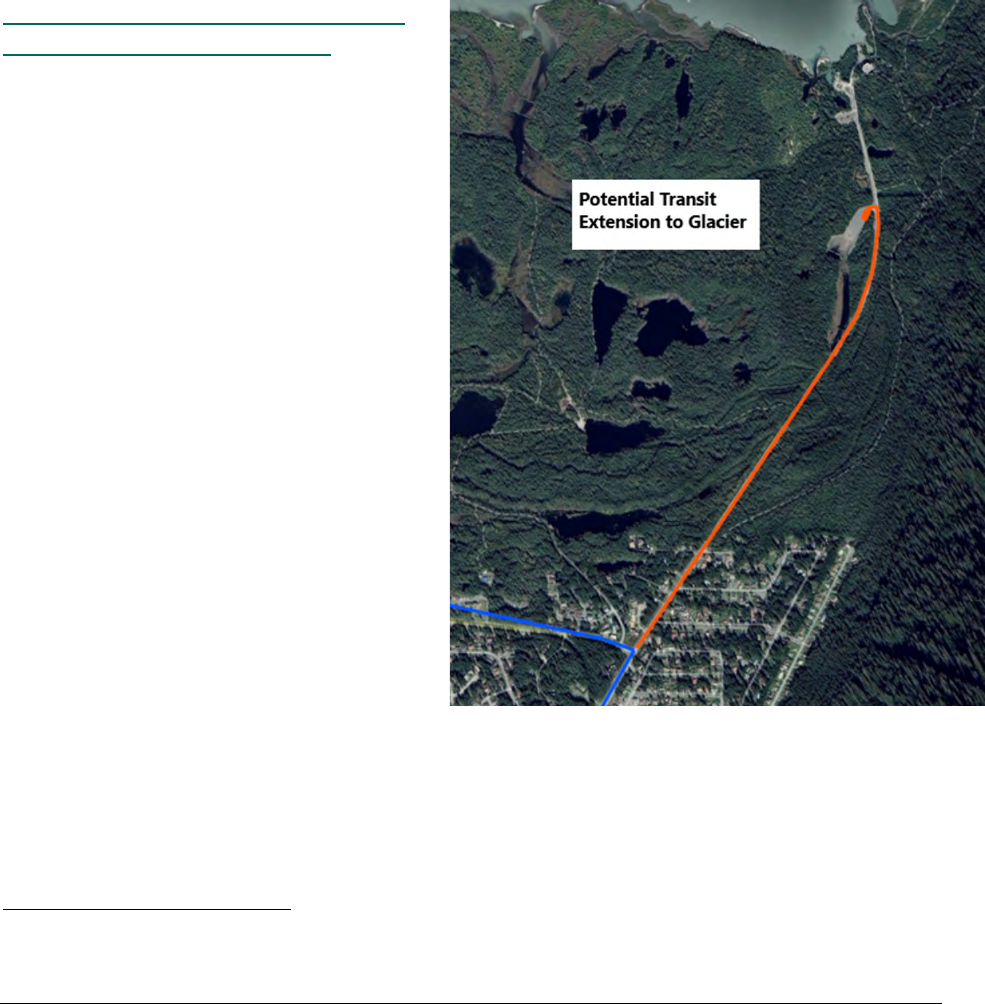
Juneau Visitor Circulator Study LSC Transportation Consultants, Inc.
City and Borough of Juneau Page 65
Improving public transit access to Mendenhall Glacier is a challenging public policy question, focusing on
the role of the public and private sectors. On one hand, providing better public access to a popular public
lands attraction is a benefit to the public at large. However, the private sector tour operators are in large
part doing an effective job providing access (at a market rate price) to the glacier. Greatly enhancing
public transit access, such as by providing direct access to the visitor center parking lot at the current
fares, would also greatly increase cruise passenger demand on Capital Transit. As a result, (1) visitors
would effectively use all existing capacity on the key routes at peak times thereby markedly reducing
mobility among Juneau residents or (2) Capital Transit would need to greatly expand capacity between
downtown and the Glacier, effectively replacing the existing private fleets with a publicly subsidized
option. Due to these impacts, it is clear that a comprehensive expansion of public transit is not feasible
and is therefore not considered further.
Limited Expansion of Capital Transit
Service to Mendenhall Glacier
One option was evaluated that would provide a
limited improvement to Capital Transit service
to Mendenhall Glacier that would improve
public access without greatly impacting the
current balance between private and public
services. Specifically, this would consist of
extending the existing Route 8
4
afternoon five
runs per day (Monday to Friday only) to the
staging area approximately 0.3 miles south of
the Glacier Spur Road Parking Lot during the
peak season. This extension is shown in Figure
14.
This service would add about 2.5 miles and 5
minutes of running time to the existing Route 8.
By providing afternoon service only, the goal of
this limited service would be largely to retrieve
visitors that this service would add about 2.5
miles and 5 minutes of running time to the
existing Route 8. By providing afternoon service
only, the goal of this limited service would be
largely to retrieve visitors that had taken transit
to Dredge Lake Road and walked to the Glacier,
without making the public transit access to the glacier so attractive that it significantly impacts the private
transportation firms and/or adds significantly to the impact that visitors are having on the Capital Transit
capacity.
4
Routes 3 and 4 do not have sufficient available running time to accommodate this route extension.
Figure 14: Route 8 Extension to Mendenhall Bus Staging Area
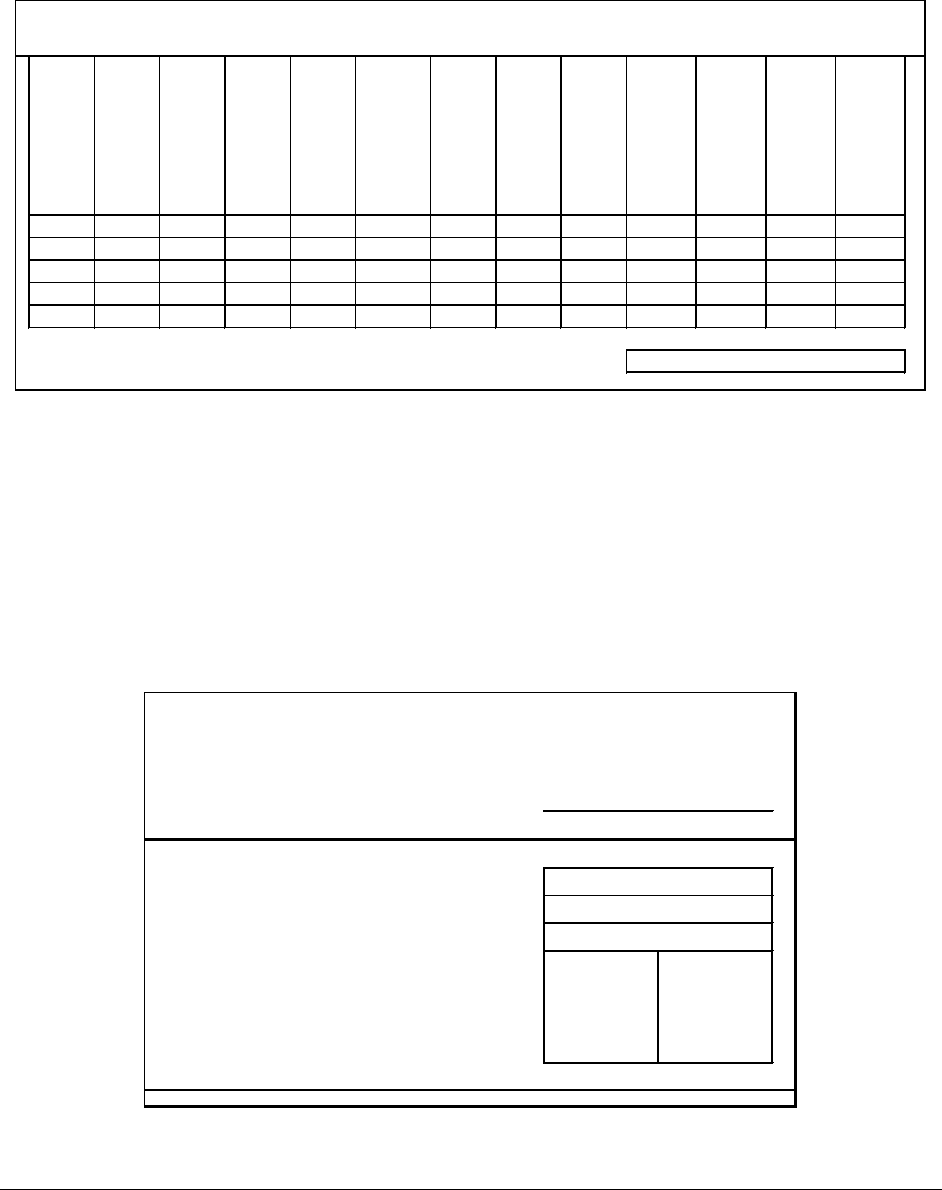
Juneau Visitor Circulator Study LSC Transportation Consultants, Inc.
City and Borough of Juneau Page 66
Table 24 presents an example schedule showing service times at the Mendenhall bus staging lots. As
shown, the stop would be served every half hour from 3:08 PM to 5:08 PM. This does provide the
opportunity for visitors to make a short afternoon trip to visit the glacier, perhaps after conducting
another tour earlier in the day. While the driver break at the Valley Transit Center would be reduced from
18 minutes to 13 minutes, this is still a sufficient break.
Operational Costs
For the first three runs, additional vehicle-miles would be generated but driver hours would not be
increased. For the last two runs that go out of service at the Valley Transit Center (shown in blue in Table
24), the runs would need to be extended to the DTC, adding additional vehicle-hours as well as vehicle-
miles. As shown in Table 25, this results in 31 additional vehicle-miles and 1.22 additional vehicle-hours
per day. Over the course of a shorter season from May 15 to September 20, the total annual operating
costs would equal $25,300 on a total allocated basis. For a longer season from May 1
st
through October
3
rd
, the total allocated costs would equal $30,500.
Downtown Transit
Center
Federal Building
Glacier Hwy / Anka St
Fred Meyer
Dep. Valley Transit
Center
Mendenhall Bus
Staging Lot
Dredge Lake Road
Auke Bay
Arr: Valley Transit
Center
Dep. Valley Transit
Center
Fred Meyer
Glacier Hwy / Anka St
Downtown Transit
Center
2:35 PM 2:38 PM 2:47 PM 2:52 PM 3:00 PM 3:08 PM 3:11 PM 3:18 PM 3:25 PM 3:38 PM 3:43 PM 3:46 PM 4:01 PM
3:05 PM 3:05 PM 3:05 PM 3:05 PM 3:05 PM 3:38 PM 3:41 PM 3:48 PM 3:55 PM 4:08 PM 4:13 PM 4:16 PM 4:31 PM
3:35 PM 3:35 PM 3:35 PM 3:35 PM 3:35 PM 4:08 PM 4:11 PM 4:18 PM 4:25 PM 4:38 PM 4:43 PM 4:46 PM 5:01 PM
4:05 PM 4:05 PM 4:05 PM 4:05 PM 4:05 PM 4:38 PM 4:41 PM 4:48 PM 4:55 PM 4:57 PM 5:02 PM 5:05 PM 5:20 PM
4:35 PM 4:35 PM 4:35 PM 4:35 PM 4:35 PM 5:08 PM 5:11 PM 5:18 PM 5:25 PM 5:27 PM 5:32 PM 5:35 PM 5:50 PM
Table 24: Route 8 Sample Afternoon Schedule Serving Mendenhall Glacier
New Partial Runs
Short Long
Number of Daily Runs
Additional Daily Vehicle Miles
Additional Daily Vehicle Hours
Days in Season (Mon-Fri) 92 111
Annual Vehicle-Miles 2,852 3,441
Annual Vehicle-Hours 112 135
Annual Total Allocated Operating Cost $25,300 $30,500
Length of Season
Table 25: Estimated Incremental Operational
Costs of Route 8 Service to Mendenhall Glacier
5
31
1.22
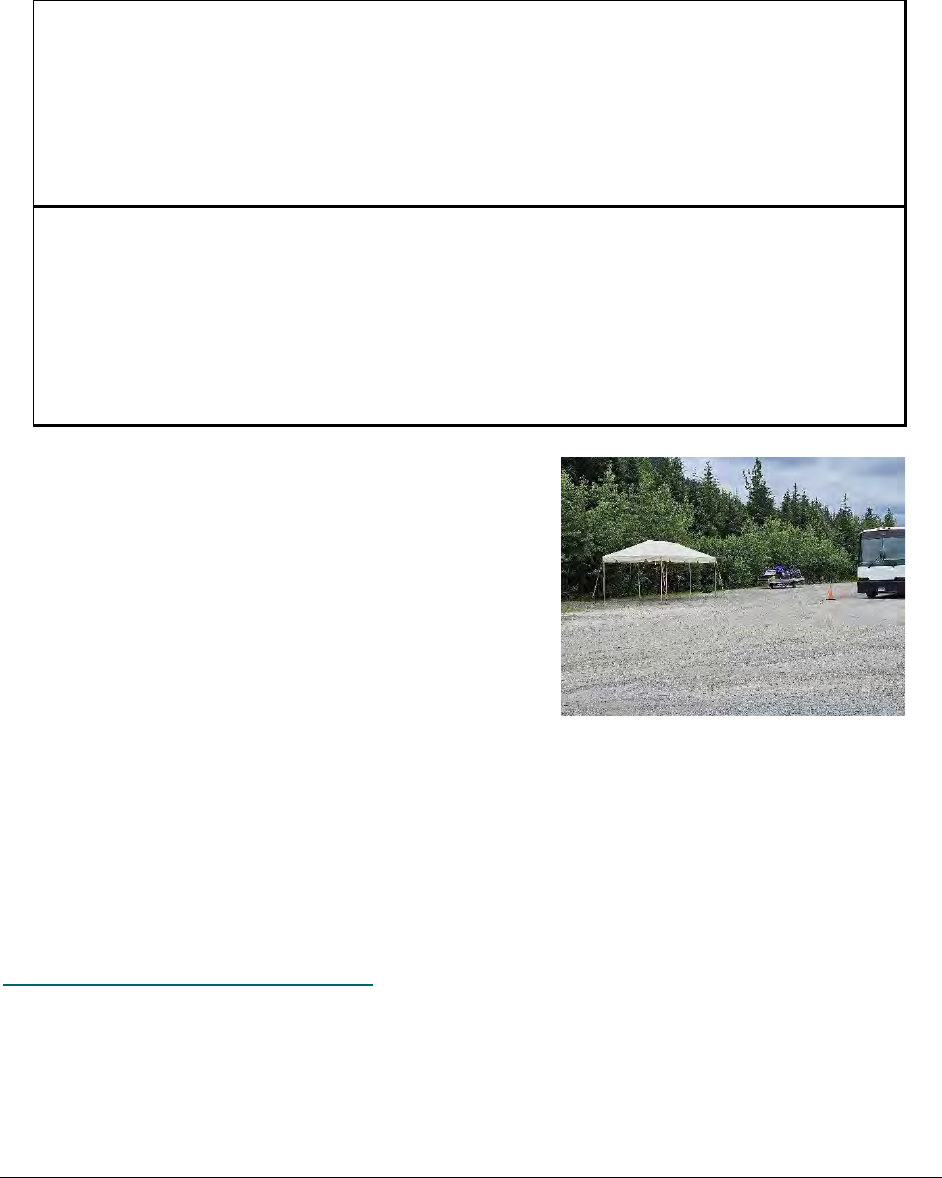
Juneau Visitor Circulator Study LSC Transportation Consultants, Inc.
City and Borough of Juneau Page 67
Projected Passenger Trips
A reasonable estimate is that this service improvement would expand daily ridership by 50 passenger-
trips per day (including more passengers making outbound trips on earlier runs). This would result in
between 9,675 and 11,700 additional one-way passengers per year depending on seasonal length of
service (Table 26).
Capital Requirements
This option would not require additional vehicles. However,
a bus stop would need to be provided at the bus staging
area, generally where the canopy is shown in the adjacent
photo. Providing this stop and its specific design and location
would need to be negotiated with the US Forest Service. A
reasonable budget for stop improvements would be
$10,000.
Implementation
The approval process for a public transit stop on Forest Service land is currently uncertain, including
whether annual fees would be required. This would require further discussions with the Forest Service
(including consideration regarding the overall Mendenhall Glacier Recreation Area Master Plan) prior to
implementation. At the Public Works and Facilities Committee (PWFC) meeting on January 29
th
, 2024 it
was decided that this particular recommendation would not be moved forward for Assembly Approval.
Benefits to Visitors and Residents
This alternative would provide benefits to both visitors and residents by providing limited services to the
Mendenhall Glacier. The intention of this alternative is to provide additional service to and from the
Glacier, thus lessening overcapacity issues along Capital Transit.
Shorter
Season
Longer
Season
Total Estimated Daily Passengers 50 50
Total Estimated Annual Passengers 4,600 5,550
Longer Season
Projected Fare Revenue $7,600 $9,200
Projected Operating Subsidy -- Fully Allocated Basis $17,700 $21,300
Table 26: Route 8 Extension to Mendenhall Glacier -
Projected Passengers and Fare Revenue

Juneau Visitor Circulator Study LSC Transportation Consultants, Inc.
City and Borough of Juneau Page 68
CONCLUSIONS
The discussion above describes the opportunities, advantages, disadvantages, and issues associated with
transit options to address visitor mobility issues. Based on this analysis, the Consultant Team has the
following recommendations:
• A Tripper service is needed at peak times to assist with the over-capacity scenarios Capital
Transit is currently experiencing. This alternative should be implemented on a near-term
basis. The full extent of the periods when drivers should be scheduled will depend on further
data analysis.
• The circulator service is also recommended for implementation immediately, as it can
provide a net benefit to the downtown economy while improving the visitor experience. The
longer route option is the better of the two route options as it would serve the popular
Overstreet Park, provides a better value for the cost of the fare, could serve future
improvements to the Hoonah Totem projects, and does not require additional bus stop
requirements over those of the shorter option. Contracting this service would be a logical
first step of implementation. At least initially, contracted service would have fewer challenges
to implement due to the advantages listed above. A monitoring program (including passenger
surveys) would be beneficial to assess the service and define any appropriate modifications.
• Limited improvement in Capital Transit service to Mendenhall Glacier can be accomplished
with only a relatively modest cost and without significantly impacting the private sector tour
operators. It would be a logical step in balancing public access without greatly impacting
either the public transit or private tour services.
This, however, will require additional
discussions with the Forest Service and is a longer-term recommendation. As noted earlier,
while this service was analyzed and will be included in the study for future possible
consideration, it is not formally being recommended by the PWFC at this time.

Juneau Downtown Circulator Study LSC Transportation Consultants, Inc.
City and Borough of Juneau Page 69
Chapter 9
POTENTIAL FUNDING SOURCES
INTRODUCTION
This chapter presents an overview of potential funding sources that could be used to fund any of the
above-discussed options. This information is presented at a high level, and additional analysis would be
needed to determine political feasibility.
Note that this discussion excludes federal operating funding sources for expanded services. Juneau is
not an urbanized area as defined for purposes of Federal Transit Administration grant programs, which
limits federal operating funding. As the available funds are already fully utilized, funding the options
considered in this study with federal funding would reduce funds available for other important existing
transit services. Other sources would be needed, as discussed below.
POTENTIAL FUNDING SOURCES
Marine Passenger Fee
Juneau collects a $5 per passenger fee on every arriving cruise ship passenger, and those funds can be
used to fund projects that enhance the tourism experience and offset community impacts created by the
cruise ship industry. Those funds could potentially be used to fund seasonal summertime service
improvements such as a downtown circulator service provided that such service provides a direct benefit
to cruise ship passengers or mitigates problems caused by the industry.
Taxes and Fees Imposed on Visitors
Most local governments, not surprisingly, prefer to implement taxes and fees that are paid by visitors
rather than their residents. Two common ways in which this is done are through hotel taxes and rental
car fees, which are set at varying rates.
Fuel and Vehicle Taxes
In Alaska, local governments can enact registration taxes based on vehicle value or age and the proceeds
can be used for any purpose. Local governments can also enact fuel taxes, and while most are used for
road purposes, they could also be used for transit purposes such as providing additional services.

Juneau Downtown Circulator Study LSC Transportation Consultants, Inc.
City and Borough of Juneau Page 70
This page left intentionally blank.

Juneau Downtown Circulator Study LSC Transportation Consultants, Inc.
City and Borough of Juneau Page 71
Chapter 10
RECOMMENDED VISITOR CIRCULATION PLAN
INTRODUCTION
Building on the detailed discussion and evaluations presented in previous chapters, this chapter first
provides a brief overview of the existing conditions and challenges. It concludes with the final
recommended plan, including service, capital, marketing, management, and implementation plans. This
plan chapter was reviewed by both the Juneau Counsel on Sustainability as well as the Juneau Downtown
Business Association. Their comment letters can be found under Appendix B with their input and
feedback incorporated into this chapter.
EXISTING CONDITIONS AND CHALLENGES
In the initial stages of the Circulator Study, LSC Transportation Consultants worked closely with Juneau
staff, Capital Transit representatives, and current transit providers in gathering information relating to
visitor volumes, transportation ridership, and crowding not only within the downtown Juneau area and
docks but also along Capital Transit routes. During this phase of the study, we discovered the following
major findings:
• Downtown Juneau Visitor Congestion: The high levels of summer cruise ship passenger
activity combined with the very constrained geography of downtown Juneau leads to a
concentration of visitors in the immediate dock area, particularly along South Franklin Street
and Marine Way. This results in a variety of issues:
o Traffic congestion.
o A limited ability for visitors (particularly those with mobility limitations) to explore the
downtown area more than a block or two beyond the waterfront. This results in a
diminishment in the quality of a Juneau visit, congestion on the sidewalks and in the
stores, and a reduction in business activity in the outlying areas such as north of 3
rd
Street.
o Reduced visitation levels at facilities outside of the immediate downtown/dock area such
as the Alaska State Museum and the Wickersham State Historic Site.
• Visitor Impact on Capital Transit Capacity: The growth in cruise passenger activity levels has
resulted in times during peak summer days when visitors (largely traveling to and from
Mendenhall Glacier) have filled Capital Transit buses leaving and returning to downtown
Juneau. This in turn can result in Juneau residents being precluded from being able to
accomplish their transit trip due to the lack of capacity on the buses. For trips such as medical
appointments or employment, this can have a substantial impact on individuals, indicating a
need for additional transit capacity. Weekdays that experienced the highest instances of “left
behind” passengers were Mondays and Tuesdays.
o Days that experienced the greatest number of passengers being left behind were
Wednesdays (221 passengers or 41 percent) followed by Mondays (134 passengers or 25
percent).
o An analysis of high-capacity (more than 10,000 cruise ship passengers) days revealed that
though many high-capacity days experienced a fair share of left-behind passengers,

Juneau Downtown Circulator Study LSC Transportation Consultants, Inc.
City and Borough of Juneau Page 72
several high-capacity days experienced very few left-behind passengers. The large
majority of capacity problems occurred on days with more than 7,000 cruise ship
passengers.
• Inconvenient Public Transit to Mendenhall Glacier: Capital Transit’s closest stop to the
Mendenhall Glacier Visitors Center is at Dredge Lake Road / Mendenhall Loop Road, which is
a 1 ¼ mile walk (on a paved multipurpose path) to the Visitor Center. While Capital Transit
does not directly market to visitors, many visitors have discovered that the transit program
provides a much less expensive transportation option between the cruise ship docks to the
glacier than the private transportation services. Once at the glacier, however, some
passengers find the walk back to the transit stop to be too much of a challenge and ask the
private transportation providers for trips back to the waterfront.
RECOMMENDED SERVICE AND OPERATIONS PLAN
The following three services were recommended to the PWFC to alleviate the pedestrian congestion
within downtown Juneau and address challenges related to Mendenhall Glacier access and overcrowding
along Capital Transit. While an overview of each service and its operation plan is included in Table 27 and
Figure 15 below, the committee recommended service recommendations 1 and 2 for further approval
from the City and Borough of Juneau Assembly. The following presents a summary of all three
recommendations, though the reader is encouraged to refer to previous chapters of this report for
additional discussion.
Service Recommendation 1: Downtown Circulator Service
A Downtown Circulator service should be initiated, following the route shown in Figure 15. The route
circulates in a counterclockwise direction running east along Egan Drive, north along South Franklin
Street, turning left along 4
th
Street, and heading south on Main Street towards the Downtown Transit
Center. From the transit center, the service runs west and turns north along Whittier Street to stop at the
Alaska State Museum.
Service Description
Dates/
Season
Days of
Week
Time of
Day
Downtown Circulator - Long
Route Option
Frequent service from Downtown
Juneau to Overland Park.
May 1st -
October 3rd
Daily
9:00 AM -
9:00 PM
Capital Transit Tripper
Occasional service to accommodate
high demand periods on Capital Transit
routes
May 1st -
October 3rd
Daily* Varies
Limited Capital Transit Service
to Mendenhall Glacier
Limited afternoon return service from
the Mendenhall Glacier staging area.
May 1st -
October 3rd
Daily
3:00 PM -
5:00 PM
Table 27: Recommended Service and Operations Plan
* Note: Capital Transit Tripper is only be run on days where cruise ship port capacity exceeds 7,000 passengers.
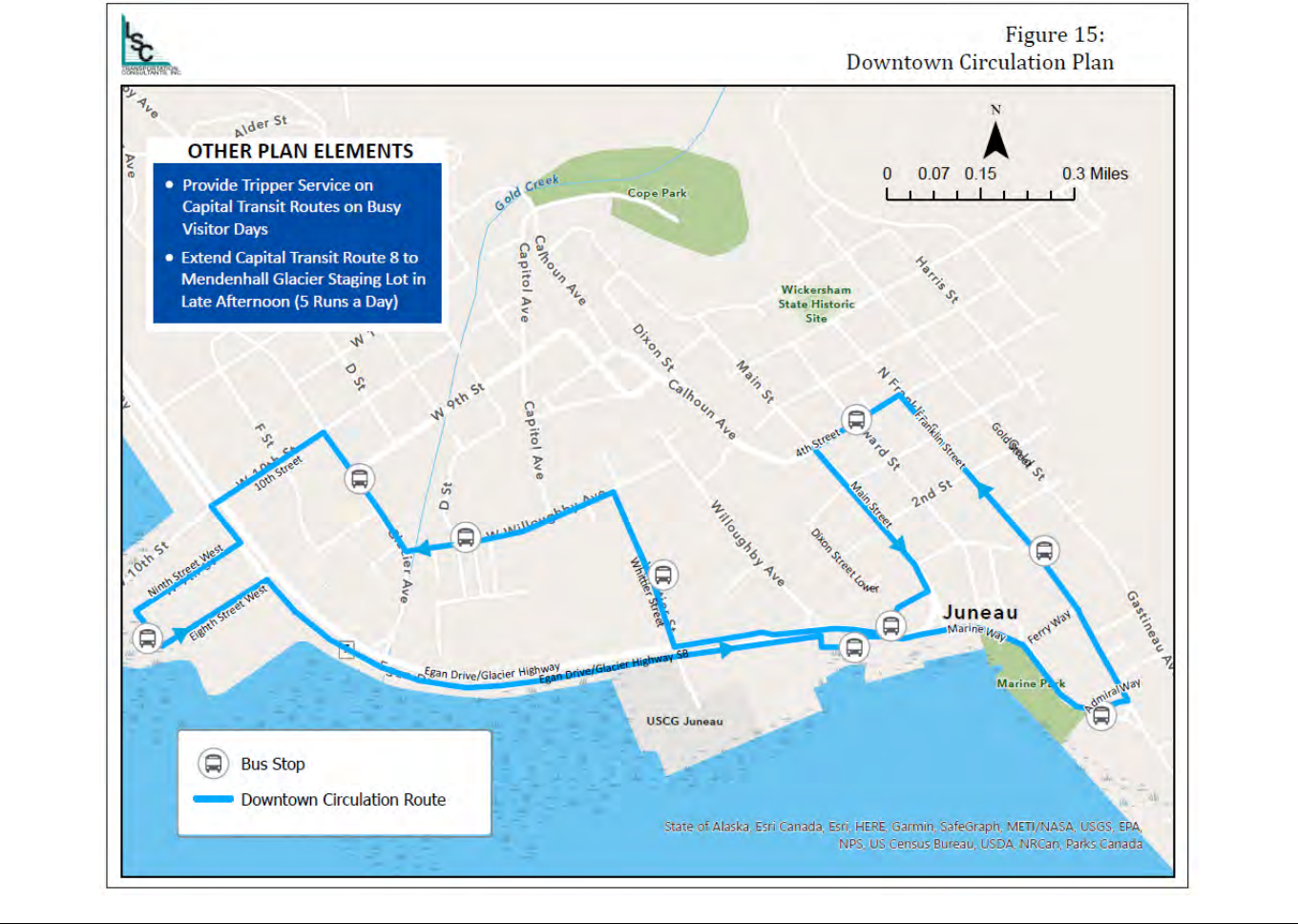
Juneau Downtown Circulator Study LSC Transportation Consultants, Inc.
City and Borough of Juneau Page 73

Juneau Downtown Circulator Study LSC Transportation Consultants, Inc.
City and Borough of Juneau Page 74
From there the service continues north along Whittier Street, turns left on Willoughby Avenue stopping
at the existing bus stop near Foodland Shopping Center before continuing onto Glacier Avenue. The route
then turns onto 10
th
Street, traveling onward to Overstreet Park before returning along Egan Drive to
begin the route again.
Stops consist of the following:
• Library/Marine Parking Garage
• Front Street & Franklin Avenue
• Seward Street & 4
th
Street
• Downtown Transit Center
• Alaska State Museum
• Foodland
• 9
th
& Glacier (Federal Building)
• Overstreet Park
• Egan & Willoughby (76 Egan)
This route requires 20 minutes per loop to operate, including loading and unloading time. It would
operate continually, rather than on a set schedule.
Seasonal Schedule and Hours of Operation
Based on passenger data, service should be operated 7 days a week from early May through early
October. The daily span of service should run from 9:00 AM to 9:00 PM. (Extending to 9:00 PM provides
more opportunity to serve passengers having dinner on shore.) On busier days (approximately 104 days
of the total 156-day operating season), one vehicle should be operated from 9:00 AM to 2:00 PM and two
vehicles should be in operation from 2:00 PM to 9:00 PM (providing service roughly every 10 minutes).
Fare
A day pass should be offered for $5.00, providing the opportunity for multiple hop-on/hop-off trips over
the course of a day. In addition, persons showing a valid Capital Transit monthly pass should be allowed
to board for free. For residents who do not purchase monthly passes, a season pass should be offered for
$20 per year.
Regarding fare collection, all fares collected would be considered property of CBJ. The contractor would
collect fares, counts, and reconcile revenue, then deposit all fare revenue with CBJ or a CBJ bank account.
Service Operator
For at least the initial two years of implementation, it is recommended that a transit contractor be used
to operate the service, provide the vehicles, and maintain the vehicles. Using a contractor allows the
service to be implemented faster and provides greater flexibility to adapt services (and staffing levels) as
real-world experience with the service is gained. This also addresses the fact that the existing Capital
Transit facility does not currently have the space to store additional vehicles. Though the day-to-day
operation of the service would be the responsibility of the contractor, CBJ would still be responsible for
other tasks as discussed in the Management Plan, below.
Under this arrangement, the contractor would propose their fixed costs (management, share of facility
utilities, insurance, providing the vehicles, etc.) into a monthly cost, and the variable costs of service
(driver wages/benefits, fuel, maintenance, etc.) into the hourly fee to be paid by CBJ.
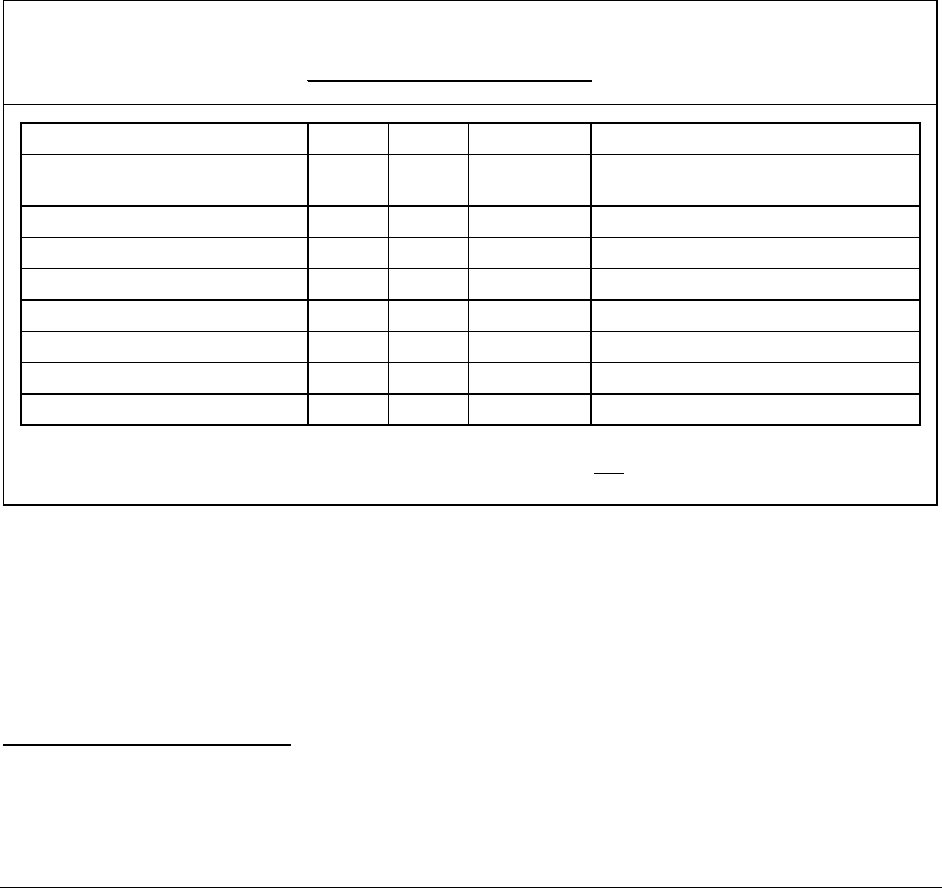
Juneau Downtown Circulator Study LSC Transportation Consultants, Inc.
City and Borough of Juneau Page 75
Capital Needs
Two vehicles will be needed for peak operations. An additional vehicle should be available as a spare, for
a total of three. For the initial implementation, vehicles should be provided by the service contractor.
Specifications regarding the vehicles (including the age and condition, as well as emission technologies)
should be defined in the RFP. Over the longer term, zero-emission battery electric buses would be
appropriate. This, however, needs to be an element in a broader zero-emission strategy for Capital
Transit.
A small transit bus (capacity of approximately 30 passengers) would optimally be operated. This could be
a traditional bus or a trolley replica. Vehicles (including the spare vehicle) should be branded in a distinct
paint and logo schedule. Optimally, vehicles would be wrapped, though it may be necessary for initial
service to rely on large magnetic signage to designate the circulator buses. Vehicles will need to be
wheelchair accessible. The nine bus stops should be distinctively signed as Circulator stops. As shown in
Table 28, new benches are recommended at three stops, along with a shelter (with bench) at Egan &
Willoughby.
5
Potential Future Enhancements
Once the Downtown Circulator has been established and is running frequently, the resources could be
used to provide additional services outside of its regular summer schedule. This may include services for
special events in the downtown area, as well as seasonal services to other nearby activity centers such as
Eaglecrest Ski Area.
5
The stop at the Alaska State Museum would optimally be in the Museum’s drop-off area (rather than on the east
side of Whittier Street, if the Museum would allow it.
Table 28: Circulator Bus Stop Improvement Costs
Stop Signage Benches Shelter & Pad Notes
Library/Marine Parking Garage R * *
Front & Franklin R R *
Increased enforcement of No Parking in Bus Bay
needed. Benches will require minor grading and
paving. ($5,000)
Seward & 4th R R * Benches on existing Sidewalk. ($1,000)
Downtown Transit Center R * *
Alaska State Museum R R *
Willoughby and D St.(Foodland Shopping Center
R * *
Already an existing bus stop with shelter and bench
9th & Glacier (Federal Building) R * *
Overstreet Park R * *
Egan & Willoughby (76 Egan) R * R
Total Units 9 2 1
Unit Cost $3,000 See Notes $40,000 Total
Total Cost $27,000 $8,000 $40,000 $75,000
Recommended Improvements

Juneau Downtown Circulator Study LSC Transportation Consultants, Inc.
City and Borough of Juneau Page 76
Service Recommendation 2: Capital Transit Peak Season Tripper Service
A “tripper” service is recommended to continue shadowing existing Capital Transit Routes 3 and/or 4 on
peak summer season days to provide additional service along runs that are overloaded with visitor
passengers. It would only run during peak days and hours to allow additional service for local passengers.
This additional service should not be shown on the schedule. Rather, Capital Transit drivers should be on
standby (on the payroll) to operate along routes as needed when passengers are left at the curb.
It is recommended that Capital Transit set service criteria to accommodate 95 percent of the existing
observed left-behind passengers (as shown in Table 14). The Tripper service should be scheduled for days
when cruise ship capacity in port is forecasted to exceed 7,000 passengers. Based on 2023’s cruise port
capacity calendar, this criteria would require bus tripper service to be scheduled 39 days during the cruise
ship season. On each day, drivers should be scheduled for an 8-hour shift. Existing data (shown in Table
12) indicates that a work shift from 10:00 AM to 6:30 PM with a lunch break could best add capacity
when needed, though this may vary based on the specific annual cruise ship port capacity calendar. As
this tripper service can be provided using the existing Capital Transit fleet, there are no capital needs
associated with this strategy.
Service Recommendation 3: Limited Capital Transit Service to Mendenhall Glacier
It was originally recommended that limited Capital Transit service be provided to the staging area
approximately ¼ mile south of the Glacier Spur Road Parking Lot during the afternoons of peak season.
This should consist of five runs of Route 8 (half-hourly from 3:08 PM to 5:08 PM). This service would
potentially add about 2.5 miles and 5 minutes of running time to the existing Route 8. It can be
accommodated without significant changes to the transit schedules.
By providing afternoon service only, the goal of this limited service would be largely to retrieve visitors
who had taken transit to Dredge Lake Road and walked to the Glacier, without making the public transit
access to the glacier so attractive that it significantly impacts the private transportation firms and/or adds
significantly to the impact that visitors are having on Capital Transit capacity.
Implementing this strategy would require the approval of the US Forest Service. As they are in the
process of finalizing the environmental review of access improvements, it may be several years or more
before this strategy can be negotiated and implemented. While this service recommendation is not being
taken to the Assembly for further action, it is recommended that CBJ staff continue to coordinate with
the USFS in planning for the staging area lot.
Seasonal Schedule and Hours of Operation
The Mendenhall Glacier stop would only be served every half hour from 3:08 PM to 5:08 PM. This would
provide the opportunity for visitors to make a short afternoon trip to visit the glacier, perhaps after
conducting another tour earlier in the day. An example schedule is provided in Table 24 in Chapter 8.

Juneau Downtown Circulator Study LSC Transportation Consultants, Inc.
City and Borough of Juneau Page 77
Capital Improvements
While this strategy does not require additional vehicles, a stop will need to be established at the staging
area, including a shelter and concrete pad. This could be a stand-alone structure or integrated into a
larger USFS facility. A budget of $40,000 has been identified for this improvement.
Marketing Plan
The Downtown Circulator options would require a strong marketing effort. A marketing campaign could
be organized internally or outsourced to a marketing agency through an RFP. A successful marketing
campaign would focus on target audiences, through several strategies as described in additional detail
below. The following was created based on goals and objectives, outlining the strategies and techniques
necessary to meet these goals.
Goals and Objectives
The major goals and objectives that should be accomplished through a Downtown Circulator marketing
campaign should include:
• Raising Awareness/Education: Creating awareness and improving local knowledge of the
Downtown Circulator.
• Increasing On-Shore Activities: Cultivating a diverse selection of on-shore activities for cruise
ship passengers.
• Increasing Tourist Presence throughout Downtown: Encouraging visitors to venture deeper
into Downtown and further north than the immediate Franklin and Egan Street corridor.
• Building Relationships with the Downtown Business Association: Coordinating collaborative
partnerships amongst business owners in the downtown area.
Overview of Marketing Strategies
The marketing campaign for the Downtown Circulator should feature the following strategies:
• Target Audiences: Marketing materials, radio ads, and/or TV commercials should target the
audience and general messaging for such marketing materials and commercials.
• Brand Identity: The service would want to stand alone and be fully branded with a distinct
name, logo, and color scheme. It may require its own website or at least a distinct page
within an existing website.
• Community Stakeholders: Building on the list of stakeholders and community members
identified during this study, a list of key community stakeholders should be identified, as well
as appropriate means and timing for contacting them about the circulator service. This group
would include members of the downtown business owners and employees, cruise ship
liaisons, government agencies, and other major tourism community leaders. Their role would
be to distribute marketing materials to raise awareness about the service within the
community as well as amongst tourists.

Juneau Downtown Circulator Study LSC Transportation Consultants, Inc.
City and Borough of Juneau Page 78
• Marketing Materials: Several mediums of marketing materials should be developed for
outreach. The following materials could be provided in English as well as other languages for
distribution through the near community and cruise ship coordinators.
• Press releases to the local Chamber of Commerce and City and Borough of Juneau.
• Printed flyers, visitor guides, etcetera
• News Media Print and Web Ads.
• Social media platforms and posts such as Facebook, Instagram, and Twitter.
• Website Updates: All related websites should be updated with clear information regarding
the new service. This could include Travel Juneau, Capital Transit, Juneau.org, etc.
• Suggestions for Promotional Events: A few pop-up promotional events could introduce the
service to potential passengers.
Raising Community Awareness
Community engagement is the core emphasis in the rolling out of the Downtown Circulator. Identifying
who needs to be notified of the service is essential in creating an outreach effort that is effective and all-
encompassing.
Community Stakeholders
Another essential part of reaching these specific subgroups of riders is the coordination and inclusion of
community stakeholders throughout the implementation of new services. The CBJ should have two
approaches when marketing new routes and services to the public and visitors: 1) sharing information
when the public and visitors seek it and 2) going to the public and visitors to share information. The first
approach will include updating all current means of providing information (transit guides, maps, website,
etc.) to include the Circulator service alongside other forms of regional transportation. For the second
strategy, identifying and engaging community stakeholders who have access to potential passengers will
be critical.
A coordinated effort to keep these stakeholder contacts aware of current services, changes to services,
and updated marketing materials should continue to go on before, during, and after Downtown Circulator
services have been implemented.
MARKETING STRATEGIES
The following section deals with the other four marketing strategies: marketing materials, website
updates, promotional events, and marketing timelines. This section concludes with a sample schedule for
rolling out the new services campaign.
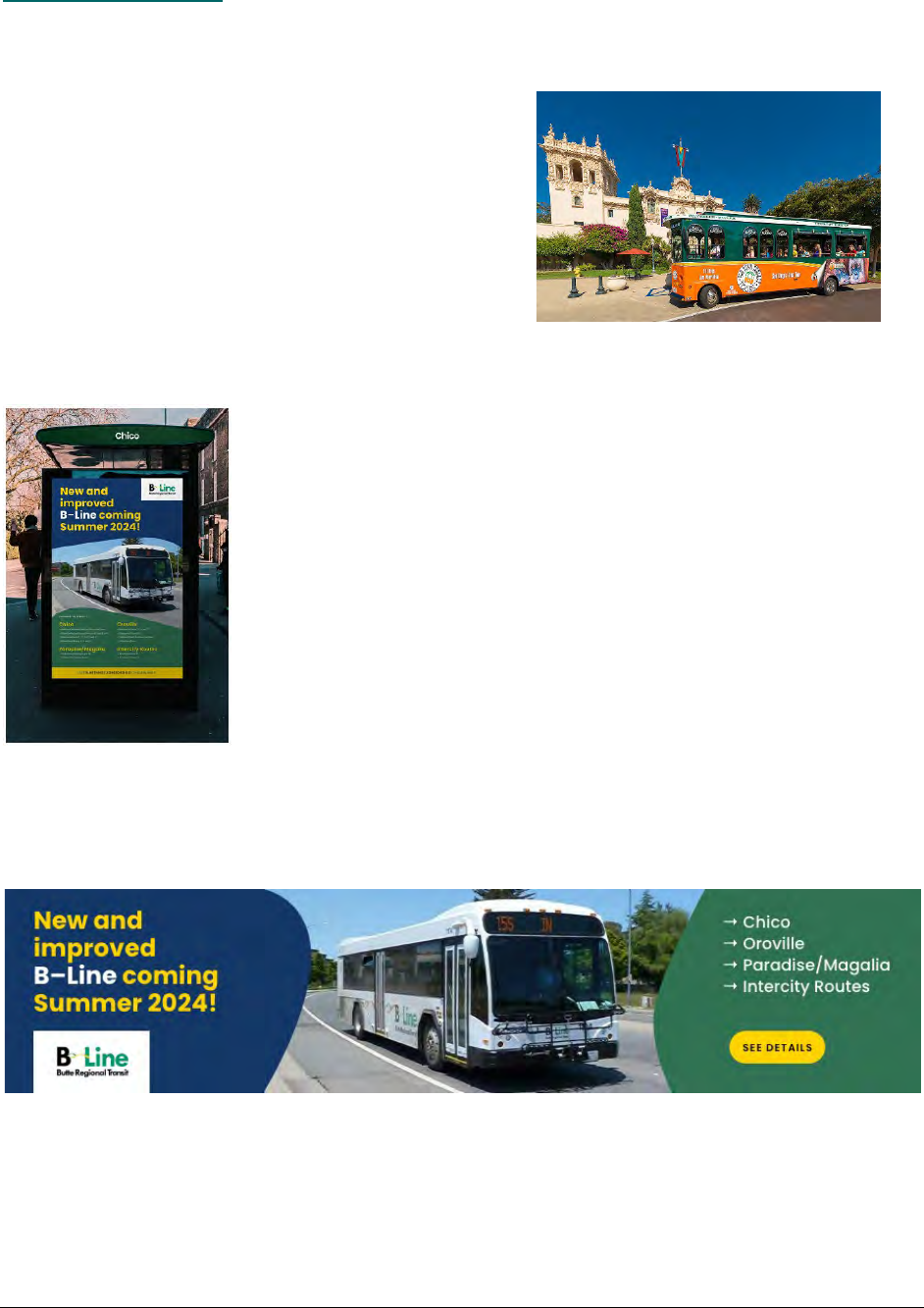
Juneau Downtown Circulator Study LSC Transportation Consultants, Inc.
City and Borough of Juneau Page 79
Marketing Materials
Photography
It is important to create a library of high-resolution
photography for use in press releases, print and web ads,
and social media posts to help guide and raise awareness
of transit services. In the early stages of the circulator
service, a photographer should be hired for a photo shoot
of the circulator bus, drivers, passengers, and the circulator
at iconic places such as Overstreet Park. Having a library of
high-resolution photography lends itself to having better
marketing materials across all types of media during the
launch of this service.
Print Advertising
Printed materials include flyers, posters, billboards, and newspaper print ads.
They should appear related in general look and feel, however, their content
may differ slightly depending on the specific type of audience under
consideration and where the content will be posted. They may feature either
website links or QR codes for people to be directed to the website for the
most up-to-date information.
Online Advertising
Similar to print advertising, online ads may include very simple content that
engages the audience to click on the ad to learn more about recent service
changes. Ads may be of various sizes depending on the online news media outlet that they are to be
featured on. Ads will be clickable and direct viewers to the circulator website to learn more. While the
circulator service should be marketed to local residents and business owners, it is also important to
create online advertising specifically targeting cruise ship passengers.

Juneau Downtown Circulator Study LSC Transportation Consultants, Inc.
City and Borough of Juneau Page 80
Social Media
Similar to other marketing materials, each post should be customized to attract and engage a particular
audience. Featuring specific photography and language style that speaks to your primary rider
demographics aids in pulling each individual into the post. An effort should be made to include several
types of demographic populations in the photoshoot.
Website Updates
The most important online material will include the creation of and updates to the
Downtown Circulator website. The schedule of services should be easy for someone
to find when visiting the site. In addition, any changes to service should be clear and
concise with a schedule that is easily understood.
Promotional Events
While the distribution of marketing materials in both print and digital formats is
paramount in launching new services in the area, hosting a series of in-person events
complements the effort and allows time to engage with both residents and visitors on
a personal level.
MARKETING TIMELINE
The timing of marketing activities is crucial. All in-person events and supporting materials should be
planned far enough in advance to allow people to plan to attend, but close enough to an impending
change that the public will maintain focus and enthusiasm for the change. The following is a sample
schedule for rolling out new services, assuming a launch in late April in early May 2025.
October 2024 (7 months to launch)
• Set an official launch date in April 2025 for beginning services in May 2025.
• Engage with graphic design and marketing consultants.
• Create a plan of deliverables.
• Graphic design and marketing consultant to begin the logo design process.
• Naming contest or marketing consultant to begin the naming process.
December (5 months to launch)
• Graphics designer to create posters, flyers, print and web ads, and any other visual marketing
materials for launch events.
• Engage with stakeholders to announce the Downtown Circulator service.
• Plan to attend other community events.

Juneau Downtown Circulator Study LSC Transportation Consultants, Inc.
City and Borough of Juneau Page 81
February (3 months to launch)
• Send follow-up emails to stakeholders to inform them of the Downtown Circulator fellow
employees, clients, and their communities. Ensure that the website is active and updated.
• Schedule radio, web, and print ads announcing the new service coming soon.
• Print and produce all large format billboard/poster banners for distribution at various bus
stops.
March (8 weeks to launch)
• Run ads, follow up with stakeholders, and attend any other community events.
• Post print announcements
• Draft Press Release
• Begin posting to social media channels.
May (launch month) and Beyond
• Email stakeholders of implemented changes.
• Send Press Release to all local news outlets.
• Hold a media event in downtown Juneau, such as a ribbon cutting.
• Post social media ads targeting specific communities in the region.
• Receive edited photography and share it with a graphic design consultant for marketing
materials.
• Hire a photographer to capture transit ridership, staff, and buses for marketing materials.
• Monitor passenger comments and complaints to identify particular issues or areas of
concern, and modify public information (website, posters) as appropriate.
• Follow up with stakeholders to receive any feedback and make sure that communities and
clients have been made aware of service changes.
As outlined above, the outreach plan for rolling out new transit services should begin at least six months
ahead of new service implementation. The marketing effort begins with hiring a marketing and/or graphic
design consultant to determine a plan to launch the service in early May 2025. In addition to a website,
logo and branding, and social media materials, the process includes posting large-scale marketing
materials such as bus stop boards and/or bus wraps.
Lastly, once the new Downtown Circulator service has been launched and the schedules and websites
have been updated, a post-effort that focuses on receiving additional input should be initiated. During
this time outreach to stakeholders, residents, and visitors should be held to better understand what can
be done to make the service better moving forward.

Juneau Downtown Circulator Study LSC Transportation Consultants, Inc.
City and Borough of Juneau Page 82
MANAGEMENT PLAN
The following section describes the costs of management tasks towards implementing the above-
recommended services.
Service Recommendation 1: Downtown Circulator
At least for the first few years, the Downtown Circulator should be operated through the use of a transit
contractor. CBJ staff, however, will still need to take on substantial responsibilities:
• Preparing and administering a Request For Proposals (RFP) process to retain the best-
qualified transit service operator.
• Managing the funding for the service and expenditures (including reviewing contractor
invoicing).
• Implementing the marketing plan for the Circulator (as discussed above).
• Implementing the transit stop amenity improvements and signage.
• Monitoring service operations and public response to the Circulator service. This includes
serving as an opportunity for the public to provide input on the service and any complaints
regarding the contractor.
This additional workload is estimated to total approximately $16,000 in staff time for initial
implementation, and an additional $24,000 per year in ongoing staff time.
Service Recommendation 2: Capital Transit Tripper
Management of the tripper service should be provided through the normal course of Capital Transit
operations. Vehicle hours expended on this service should be tracked, as well as the date, time, location,
and number of passenger boardings served by the tripper buses.
Service Recommendation 3: Limited Extension to Mendenhall
Although this option is not being recommended for Assembly action, ongoing coordination with the USFS
regarding transit passengers accessing the Mendenhall Glacier as well as the time needed to manage the
bus stop improvements can be accomplished existing staff.
Monitoring and Reporting
An important element of the overall visitor circulation strategy is a robust monitoring and reporting
process. This will be important in providing decision-makers and the community with a good, data-based
understanding of the effectiveness of the strategies. Monitoring of the Downtown Circulator should
include the following:
• Requiring the service contractor to record ridership by day, vehicle, and run start time, as
well as to document the service vehicle-hours, any accidents and incidents, and any public
input or complaints received.
• Conducting passenger surveys in several periods throughout the operating season to obtain
information on the following:

Juneau Downtown Circulator Study LSC Transportation Consultants, Inc.
City and Borough of Juneau Page 83
o Passenger type (cruise passenger, other visitor, resident, etc.)
o Size of travel group
o Trip purpose
o Number of trips per day and per week
o Perception of the service from various criteria (convenience, quality of stops, value, etc.)
o Where and when they learned about the service
o Suggestions and comments
• Conducting passenger boarding and alighting counts in several periods throughout the
operating season.
• Providing email and phone opportunities to provide public input regarding the service, or to
provide any complaints to CBJ regarding the service contractor.
• Preparing an annual end-of-season report summarizing the data collected and making
recommendations regarding changes to the services.
• Making presentations to the Borough Assembly and the Juneau Commission on Sustainability.
IMPLEMENTATION PLAN
As described in Chapter 8, each specific service under the recommended plan varies in the scope of
implementation. The following describes items to consider in the implementation of each service as
shown in Table 29. Note that while the Limited Service to Mendenhall Glacier recommendation is
included, it is not currently being considered for implementation at this time.
The Downtown Circulator will require not only the procurement of a private transportation provider for
operations but also a substantial effort in marketing and branding the service. After the official approval
of the Circulator Study, a Request for Proposals should be drafted and issued (March through May 2024).
It is then suggested that the bus stop improvements indicated in Tables 21 and 22 be implemented
during the summer months of 2024. In coordination with interviewing and hiring a private contractor, the
process of branding the circulator service should begin. It should have a memorable name that fits with
the region and has an easily recognizable logo. Marketing materials would include radio, television, news,
and social media campaign materials notifying the public and cruise providers of the available service. The
circulator service is anticipated to begin in May 2025.
As the Capital Transit Tripper service was already in operation as of the summer of 2023, the
implementation of this strategy will require fewer resources than the circulator. It is recommended that
the 2024 cruise ship port capacity calendar be used to plan tripper services on days exceeding 7,000
passengers. Based on the 2023 calendar, this will be for approximately 39 days throughout the season
and will require additional driver staff to accommodate the increase in service. As this service is not to be
advertised, it requires no marketing materials or additional public awareness.
The implementation of Limited Service to Mendenhall Glacier will need to be an ongoing conversation
between the City and Borough of Juneau and the Forest Service. With the release of the recent Visitor
Improvement Project plan, providing even limited afternoon services to Mendenhall still may be a long-

Juneau Downtown Circulator Study LSC Transportation Consultants, Inc.
City and Borough of Juneau Page 84
term service. Please note that Limited Service to Mendenhall Glacier is not being recommended to the
Assembly by the PWFC at this time.
FINANCIAL PLAN
Operating Financial Plan
Operating Costs
The costs and revenues associated with operations and management of the strategies are shown in Table
30. Costs are estimated for initial implementation (before service initiation), Year One of service, Year
Two of service, and Long-Term. As vehicles are planned to be provided through the service contract in
Years One and Two, the operating costs include vehicle lease costs. In the long term, the provision of
publicly owned vehicles will eliminate these lease costs. Specific costs are estimated as follows:
Costs for the operation of the Downtown Circulator as well as provision of vehicles will be determined
through the RFP process. For planning purposes, the existing Capital Transit budget was used to develop a
cost equation that can estimate the cost of service, as follows:
• Operating Cost = $163.10 X vehicle-hours of service + $2.45 X vehicle-miles of service
• Vehicle Cost = $3,500 per month
These costs are forecast to total $524,400 in the near term, and $471,900 in the long term. Marketing
costs are estimated to total $15,000 for initial implementation (branding) and then $13,000 per year
thereafter. Management costs are estimated to total $16,000 for implementation and then $24,000 per
year. In sum, the Downtown Circulator will incur costs of $31,000 for implementation, $561,400 per year
in the near term, and $508,900 in the long term.
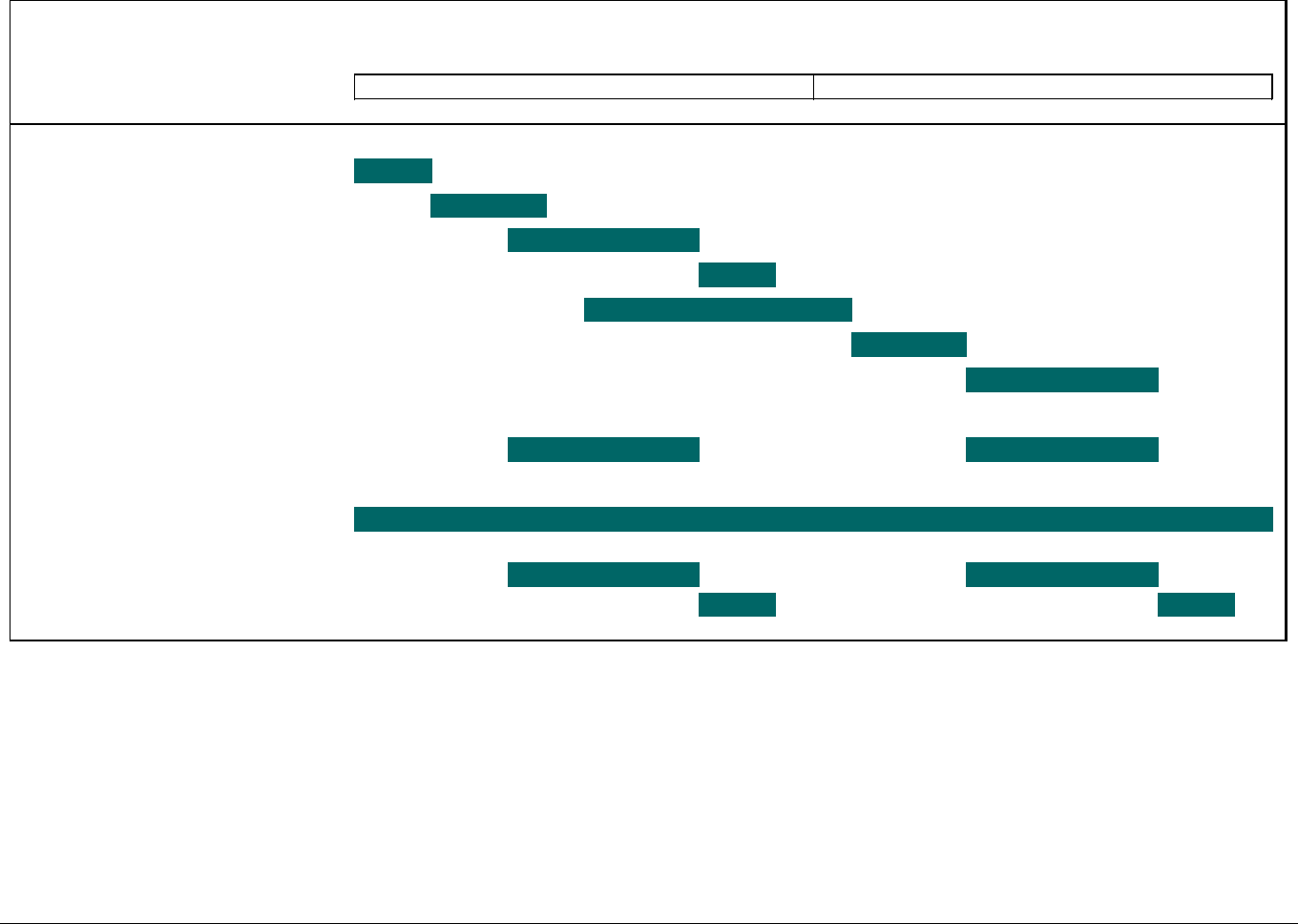
Juneau Downtown Circulator Study LSC Transportation Consultants, Inc.
City and Borough of Juneau Page 85
Table 29: Implementation Plan
Service/Task Jan Feb
Mar
Apr
May
Jun Jul Aug
Sept
Oct Nov Dec Jan Feb
Mar
Apr
May
Jun Jul Aug
Sept
Oct Nov Dec
Downtown Circulator
Circulator Study Approval
Prepare and Issue Request for Proposals
Bus Stop Improvements
Interview and Select Private Contractor
Branding and Marketing
Launch Press Release
Operate Circulator Service
Capital Transit Tripper
Expand Tripper Service
Limited Capital Transit Service to Mendenhall Glacier
Ongoing Communication with Forest Service
Monitoring
Collect Monitoring Data
Prepare/Present Monitoring Report
2024
2025
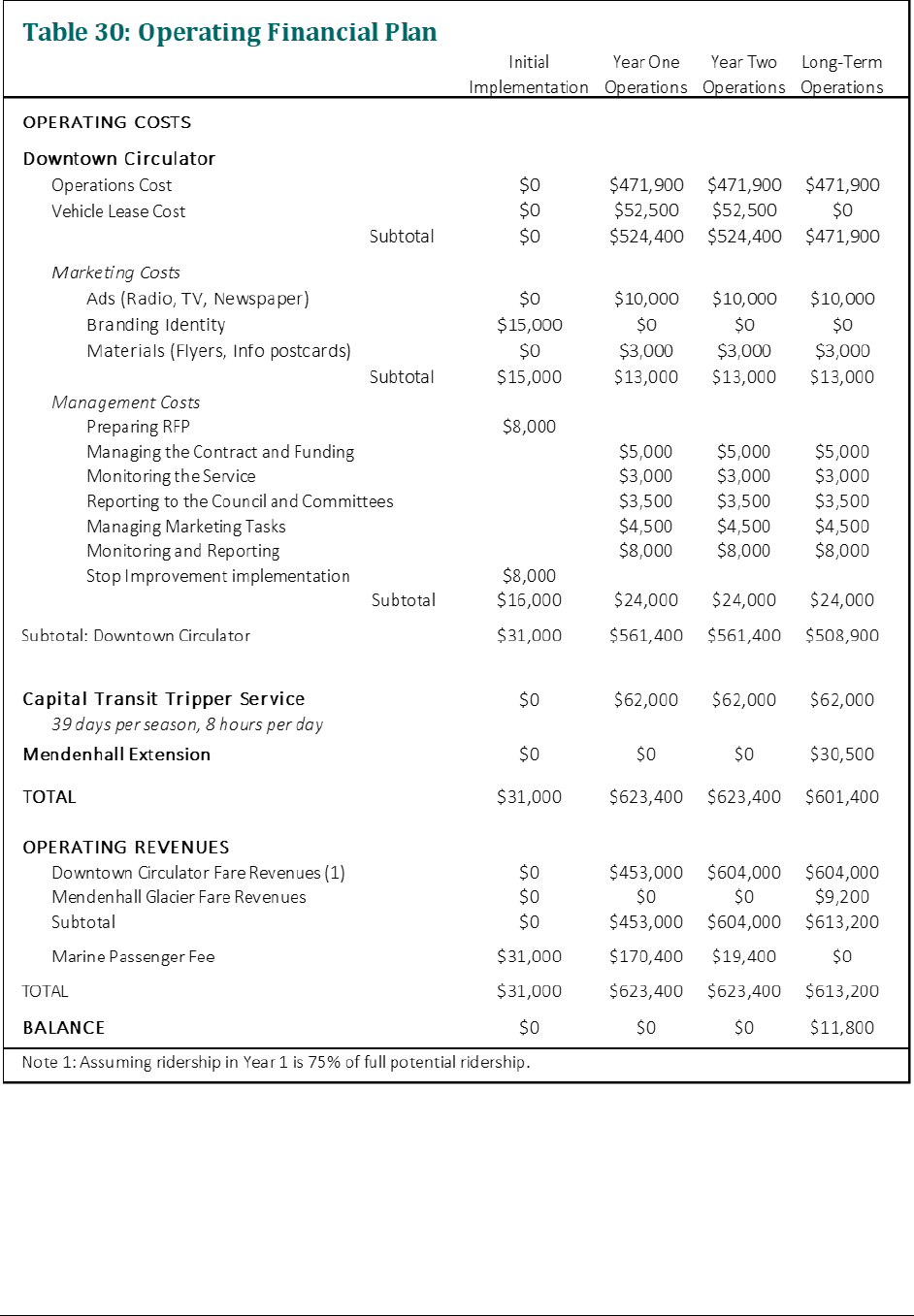
Juneau Downtown Circulator Study LSC Transportation Consultants, Inc.
City and Borough of Juneau Page 86
The cost of 8 hours per day of tripper service on 39 days per year, at Capital Transit’s current cost rate, is
$62,000 per year. If Capital Transit service was to extend to Mendenhall Glacier in the long term, this
would increase annual operating costs by $30,500 in today’s dollars. In sum, the three service strategies
will incur a cost of $31,000 for start-up expenses, $623,400 per year in the near term, and $601,400 per
year in the long term.

Juneau Downtown Circulator Study LSC Transportation Consultants, Inc.
City and Borough of Juneau Page 87
Operating Revenues
Downtown Circulator passenger fares (at $5.00 for a day pass and discounts for residents) are forecast to
generate $604,000 per year once passenger potential is fully realized. Experience with new transit
services indicates that the first year of service typically does not meet the full ridership potential, as
marketing efforts take time to be fully effective and potential passengers are not fully aware of the
service. A 25 percent reduction in passenger revenue was therefore applied for the first year of service. In
the long term, once Capital Transit service is extended to Mendenhall Glacier, this is expected to also
generate a relatively modest fare revenue of $9,200 per year.
As other local and federal operating sources are fully allocated to existing Capital Transit services, the
remaining required operating funding should be generated through the Marine Passenger Fees. As shown
in the bottom of Table 30, this equates to $31,000 for initial implementation, $170,400 for Year 1
operation, and $19,400 for Year 2 operation. In the long term, the reduction in operating costs associated
with the provision of public vehicles is forecast to allow fare revenues to fully cover costs, which would
avoid the need for Marine Passenger Fees. It is important to underscore, however, that there is a
substantial level of uncertainty regarding both the fare revenue estimate and the operating cost estimate,
and any additional funding would be addressed through the Marine Passenger Fee program.
Capital Financial Plan
Capital Costs
The capital costs of the visitor circulation strategies consist of the following, as shown in Table 31:
• $3,150,000 for the purchase of three zero-emission buses (including one spare vehicle)
• $73,000 in stop improvements for the Downtown Circulator
• $40,000 allocated for public bus stop improvements at Mendenhall Glacier
Table 31: Capital Funding Plan
Service/Item Cost
Capital Costs
Downtown Circulator
Stop Improvements (Benches, Signage, Shelter) $73,000
Zero Emission Vehicles (3) $3,150,000
Limited Services to Mendenhall
Bus Stop Improvement $40,000
Total
$3,263,000
Revenues
Federal Funding $2,520,000
Marine Passenger Fee $743,000
Total
$3,263,000
Balance
$0

Juneau Downtown Circulator Study LSC Transportation Consultants, Inc.
City and Borough of Juneau Page 88
Capital Revenues
Revenues to address the total of $3,263,000 in capital funding needs consist of the following:
• Federal Transit Administration Section funds, such as the 5339(c) Low or No Emission Grant
Program, are available for up to 80 percent of the cost of zero-emission buses.
• Marine Passenger Fees should address the remaining 20 percent of the vehicle purchase
costs as well as all of the bus stop improvement costs.
In total, this calculates to $2,520,000 in federal funds and $743,000 in Marine Passenger Fee revenues. If
federal funding is not fully available, Marine Passenger Fee requirements may be higher.

October 20, 2023
Alexandra Pierce, CBJ Tourism Manager
155 S. Seward St
Juneau, AK 99801
Subject: Draft JUNEAU VISITOR CIRCULATOR STUDY Review of Report-JCOS Comments and
Recommendations
The City and Borough's Commission on Sustainability (JCOS), which recommends sustainability policy to
Juneau’s elected officials, has strongly supported a shift toward electric vehicles for the CBJ transit system
and continues to do so for the circulator concept. The whole goal of cruise ship shore power is to remove
emissions and improve air quality. An electric circulator system complements this effort to reduce air
emissions issues in downtown Juneau and not compound the existing problem.
In 2010-2011, JCOS helped develop the Juneau Climate Action & Implementation Plan (JCAP), resulting in
the CBJ Assembly adoption of the plan in 2011 (Resolution 2593). The JCAP set a goal of reducing
greenhouse gas emissions by 25% by 2032. The JCAP includes several goals and recommendations relating
to electric vehicle adoption for the CBJ transit system:
Goal T-1: Reduce municipal fleet-related emissions.
Strategy TI-A. "Purchase low or zero-emission vehicles or renewable fuel vehicles to test for fleet use."
Goal T-2: Increase Capital Transit ridership
Strategy T-2. "Purchase only alternative/renewable fuel or hybrid transit vehicles." This developed from
the recommendation in the 2008 (15 years ago) CBJ Transit Development Plan that the CBJ consider future
fleet purchases of alternative fuel vehicles such as hybrid-electric.
Goal T-3: Reduce emissions per vehicle mile driven.
Strategy T3-B. "Consider the feasibility and economic viability of replacing the existing fleet with electric
buses."
In 2018, the Assembly adopted the Juneau Renewable Energy Strategy (Resolution 2808) developed and
drafted by the JCOS. Building on actions in the earlier JCAIP, the 2018 JRES supports increased use of
renewable energy in the community. The JRES strengthens our community's long-term commitment to
the similar goals expressed in the 2011 JCAIP and repeatedly identified under the CBJ Assembly’s annual
sustainability goals. Reduced reliance on fossil fuels for transportation is one of the four key strategy areas
the JRES identified. Incorporating electric circulator buses would be of great value to the CBJ in taking
the next steps to make these community aspirations a reality while simultaneously marketing Juneau
as a clean port destination.
Juneau Commission on Sustainability’s key areas of comments and recommendation on the JUNEAU
VISITOR CIRCULATOR STUDY:
Federal Funding Opportunities and Assistance
JCOS requests a thorough identification of federal funding opportunities to help pay for the circulator
expansion of CBJ Transit since it is apparent that there are several DOT, EPA, and perhaps other programs
available to assist the CBJ in instituting a circulator without all costs being borne by the Juneau taxpayers
or ridership fares. JCOS helping CBJ has been extremely successful in securing millions of federal dollars
through the Section 5339(C) LOW OR NO EMISSION GRANT PROGRAM in acquiring replacement and for
new improved service buses. Another CBJ success to build on is the 5339 (B) BUS FACILITIES GRANT
PROGRAM that is appropriately managed would pay for downtown bus charging facilities and safe, well-
lit and perhaps heated bus pick up/drop off stations along the circulator route to provide safe and dry
facilities for our residents and visitors alike. While JCOS is experienced with these two programs,
independent discussions with our Congressional delegation staff and review of the Inflation Reduction Act
and the Bipartisan Infrastructure bill championed by Senator Lisa Murkowski would provide economic
opportunities to timely make a clean circulator system in downtown Juneau a reality without paying for
it entirely on the backs of Juneau taxpayers. In the final report, we would like to see a detailed discussion
on all federal and state funding opportunities and mechanisms to help pay for the circulator system.
Juneau Resident Value Added Benefits
JCOS requests additional work and discussion on providing "value" to our Juneau residents. The report
does a fine job at visitor benefits but is missing a section on value-adding the Juneau circulator system to
Juneau residents and taxpayers.
JCOS would like to request a discussion on a downtown park and ride section. Downtown parking is an
actual or perceived problem for residents. However, parking and visitor congestion is a problem that the
circulator concept attempts to alleviate. Therefore, extending the value of the circulator concept to serve
the needs of Juneau residents should be articulated in the final report. The circulator study should
consider a CBJ-designated downtown "park and ride" parking lot(s). If the report and CBJ supported
incorporating park-and-ride lots into the circulator concept, it would provide a valuable service to Juneau
workers and visitors (requiring more than a 2-hour parking limit) to park their vehicles and then ride to
and from the downtown corridor.
Juneau also hosts several significant events in Juneau, including the Juneau Folk Festival, Gold Medal
Basketball Tournament, and the Sealaska Heritage Celebration events. A circulator that operates outside
the tourist season that can assist in Juneau hosting these and more events not only helps visitors but it
will increase restaurant and shopping traffic to our downtown corridor for these events.
Another salient discussion point is that these circulators can provide "beyond tourism season" on-call
transportation from local downtown hotels and designated downtown pick-up stations to Eaglecrest for
our growing winter tourism. Residents can use this system to reduce congestion and parking requirements
at Eaglecrest. The final report could also explore and discuss other opportunities that increase the
circulator concept's value proposition to improve and optimize Juneau resident's services and more fully
utilize transportation investments outside the traditional tourism season.
Avoid Mendenhall Glacier Visitor Center Issues with the Downtown Circulator
The whole discussion of the Mendenhall Glacier, its permitting, its impacts, its potential disruption, and
displacement of private businesses and local operations is a distraction to implementing here-and-now
solutions for the downtown circulator. The CBJ does not control the access to the visitor center and while
the CBJ is encouraged to negotiate and consult, the CBJ does not control the permitting and access to the
Glacier. JCOS is not recommending a protracted discussion with the US Forest Service and its management
of the Mendenhall visitor center that serves to stall solutions and implementation time for a downtown
circulator. This important topic can be dealt with in another study or effort separate from the immediate
issues concerning a downtown circulator.
Profit/Loss/ Cost Sensitivity Analysis and Public-Private Partnerships
JCOS recommends a more robust exploration and discussion in this crucial area of the report. Circulators
can make money and, if properly managed with efficiency and competency, contribute to Capital Transit's
bottom line in capital and operations, improving economics as well as perceived value to Juneau residents.
JCOS would recommend that the report conduct a sensitivity analysis on fee structures with beneficial
scenarios that support local ridership.
For example, could CBJ Capital Transit monthly passes be incorporated to provide free additional
circulator service?
Could monthly park-and-ride fare service that included access to off-downtown-corridor parking be
integrated so that Juneau residents did not have to pay a high daily rate? The daily circulator rate could
be raised and the monthly rate reduced so that the Capital Transit could afford "several," meaning three
(3) or more buses to provide optimal service and keep locals and tourists from waiting in the rain. An
effective circulator must be safe and reliable. Therefore, a more robust downtown circulator may be
required based on ridership, especially if CBJ management effectively used and parlayed federal funding
to help initially pay for the capital investment.
JCOS understands, based on past reports and anecdotal information, that our visitors are willing to pay
for a proven, safe, effective, and timely service. However, no surveys or cost sensitivity analysis based on
other competitive correlations appear in the report and should be considered.
Also, more information would be required to optimize services with a public/private partnership in that
the CBJ could offer the service to a private operator but receive a "cut" to pay for capital infrastructure,
replacement, and managerial operations. These options and costs need more exploration to maximize
service at the lowest price for Juneau residents while optimizing revenue from visitors alike with
appropriate fee structures of daily versus more extended duration fees.
In summary, the JCOS appreciates the invitation to comment. JCOS requests that our comments and other
public comments be placed in a report appendix and made an integral component of the final report. We

also ask that in case a written and documentable invite has not already occurred, both Juneau tribal
entities, the Douglas Indian Association and the Central Council of the Tlingit and Haida Indian Tribes of
Alaska, be directly and cordially invited to make comments for CBJ to maximize any future Justice 40 and
environmental justice points for any future federal funding grant and programmatic funding.
Sincerely,
Gretchen Keiser, JCOS Chair
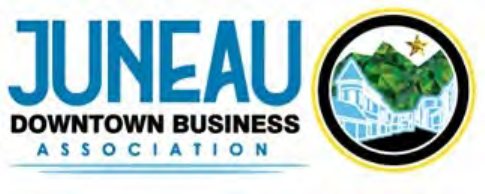
October 30, 2023
Alexandra Pierce
Tourism Director
155 South Seward Street
Juneau, AK 99802
RE: Downtown Business Association (DBA) comments on the Juneau Visitor Circulator Study
Dear Ms. Pierce,
Thank you for attending and presenting at our recent DBA board meeting on October 10. The DBA board
appreciates your efforts to advance Juneau's visitor industry, which many of our 135 downtown member
businesses, their employees, and families rely on. A clean, safe, reliable downtown circulator has been a
DBA priority for over a decade, expressed in several letters, presentations, and resolutions shared with
partners and the CBJ. We hope our comments now are timely and helpful to optimize the success of a
downtown circulator plan. We concur that a downtown circulator will have benefits for cruise ship
passengers to Juneau as well as locals.
According to a Cruise Line Industry Association (CLIA) report in 2018 (pre-COVID), the median age of
Alaska cruise passengers is 54 and slightly older than other cruise line destination vacationers. Most Alaska
cruise travelers are employed (72 percent), and 21 percent have retired. According to former Mayor Greg
Fisk in his downtown circulator presentations, the average Alaska cruise passenger has a walking radius
of ¼ mile. This limited walking distance is further limited by travelers with health or mobility conditions.
Additionally, some cruise visitors do not visit or shop in Juneau for lack of downtown shopping access
options due to weather or mobility issues. This phenomenon is especially true for vessels not docking at
16B public docks. Overcoming this transportation barrier with a convenient downtown circulator provides
options for eager-to-spend customers at DBA eateries, drinking establishments, and shops, beneficially
impacting DBA members and CBJ sales tax revenues. A small percentage of increased shopping visitors
that would otherwise "stay on the ship" would help pay for the circulator through increased sales tax from
this "stay on the ship" segment.
The visitor industry is an important economic component of DBA members and CBJ tax revenues. A
downtown circulator has several economic and social benefits. We also note that a poorly designed and/or
poorly managed circulator that does not meet the standard of safety, cleanliness, quick access, and
disembarkation or poorly planned stop locations would be problematic. Therefore, CBJ leadership,
management, and planning, not infrastructure, are perhaps the determining criteria for a downtown
circulator's success. The DBA is interested and supportive of a circulator that adds value to the Juneau
visitor experience, our downtown members, and residents. The Juneau Visitor Industry 2022 survey
identifies that spreading out tourist congestion is a high priority and important to Juneau residents.
Likewise, heavy traffic areas with shops experiencing high rental rates can be mitigated with proper
planning of circulator stops that are well planned and coordinated with DBA and its members.
Additional comments regarding recommendations:
Below are some key comments from our membership regarding possible recommendations:
• The identification of appropriate circulator stops will require specific design considerations to
reallocate foot traffic from high-density areas while also harmonizing and adding value. These
properties with high lease rates should not be negatively impacted by the circulator.
• Circulator stops must be clean and well-lit with no loitering for non-patrons. Maintaining these
high standards will be necessary to ensure a positive experience for visitors and residents.
• Consideration should be given to circulator stops that can provide downtown employees with a
park-and-ride option to their place of employment from Franklin, Seward, and Main Street.
• A circulator should provide downtown residents access to groceries, hardware, banking, and
pharmacy services. Thus, we favor the long route described in the study completed by LSC
Transportation Consultants and strongly support a stop at the Foodland Shopping Center.
• The Mendenhall Glacier Visitor Center has unique access issues requiring bifurcation from the
downtown circulator project. We recommend that this project stays focused on being a
downtown-specific solution that provides immediate access to a vibrant and accessible shopping
area while simultaneously dispersing downtown congestion-related visitor traffic.
• The circulator should utilize clean energy (electric or hybrid preferred) and provide the public with
easy, non-step access on and off the bus with timely and dependable service.
• In terms of scheduling, we favor at least two circulators with no more than 15-minute intervals to
allow visitors with limited time to shop and spend locally.
• Year-round service would benefit our downtown residents who do not drive.
Please know that we appreciate your presence at our recent DBA board meeting and for allowing us the
opportunity to discuss this study with you. We fully support a well-designed circulator with adequate
service and proper city management to address the needs of Juneau's visitor industry, a core economic
driver upon which our members, their employees, and their families rely.
Venetia V Santana
President, DBA Board of Directors
